Physical Address
304 North Cardinal St.
Dorchester Center, MA 02124
Pediatric neuroimaging is a distinct subspecialty. Anatomic areas in neuroimaging include the skull, brain, orbits, face and sinuses, neck, and spine. At many children's hospitals, dedicated neuroradiologists perform and interpret all of the neuroimaging. The large amount of information included in pediatric neuroradiology is beyond the scope of this textbook. Specifically, diseases affecting both the pediatric and the adult population and presenting with similar imaging findings such as stroke and vascular anomalies will not be covered. Therefore, this chapter is a review of the commonly encountered entities in pediatric neuroimaging that are unique to the pediatric population or have unique pediatric features.
In pediatric neuroimaging, magnetic resonance imaging (MRI), computed tomography (CT), and ultrasound are all used, with some overlap. In general, MRI has become the definitive test in evaluating intracranial abnormalities. It is the test of choice for evaluating brain involvement for neoplasms, vascular lesions, inflammatory processes, demyelinating disorders, metabolic diseases, and developmental abnormalities, as well as for the evaluation of neurodegenerative disorders, focal seizures, unexplained hydrocephalus, and neuroendocrine disorders. CT is typically reserved for the evaluation of trauma and acute neurologic symptoms when MRI cannot be performed due to availability constraints or the patient's inability to lay still. CT has been historically the exam of choice for trauma and shunt malfunction; however, this has changed recently with fast MRI techniques being now widely used for shunt malfunction and recently instituted for trauma at some institutions. Sinus disease, orbital cellulitis, temporal bones, and neck abnormalities remain often evaluated by CT. The use of MRI for the evaluation of temporal bone, face, and neck abnormalities is rapidly increasing and at many times may either substitute or complement CT evaluation. Neck ultrasound is used for thyroid evaluation and superficial masses. Head ultrasound is reserved for evaluating premature infants and newborns, prior to closure of the anterior fontanelle.
A number of advanced MRI techniques are playing an increasing role in the neuroimaging of children. Such techniques and associated basic vocabulary are summarized here. Applications in pediatric patients are also discussed.
Diffusion-weighted imaging (DWI) is determined by the variability in the diffusivity of water molecules in tissues. The random movement of water molecules is known as Brownian motion. In tissues, there is variable restriction of the movement of water molecules relative to tissue structure. Pathologic states may alter the diffusion characteristics of water molecules in the brain and therefore affect the appearance of the DWI images. Images on DWI are influenced not only by diffusion of water molecules but also by other tissue properties, such as T2. To eliminate the influences on imaging appearance of factors unrelated to diffusion of water molecules, the data are processed, most commonly by using a technique called an apparent diffusion coefficient (ADC) map . For each DWI sequence, at least two sets of images are created: the DWI images and the ADC map. In a pathologic process in which there is true restricted diffusion, the involved area appears high in signal on the DWI images and low in signal on the ADC map ( Fig. 8-1A and B ). Conversely, in pathologic processes in which there is facilitated diffusion, signal will be low on DWI images and high on the ADC map. Due to the influences of T2 tissue properties on DWI imaging, an area of increased signal on T2-weighted sequences (including T2 fluid-attenuated inversion recovery sequences) may show as increased DWI signal and not represent true diffusion restriction. In this case, signal will be normal or increased on ADC map, instead of decreased. This phenomenon is known as T2 shine-through ( Fig. 8-2A–C ) and should not be confused with restricted diffusion.
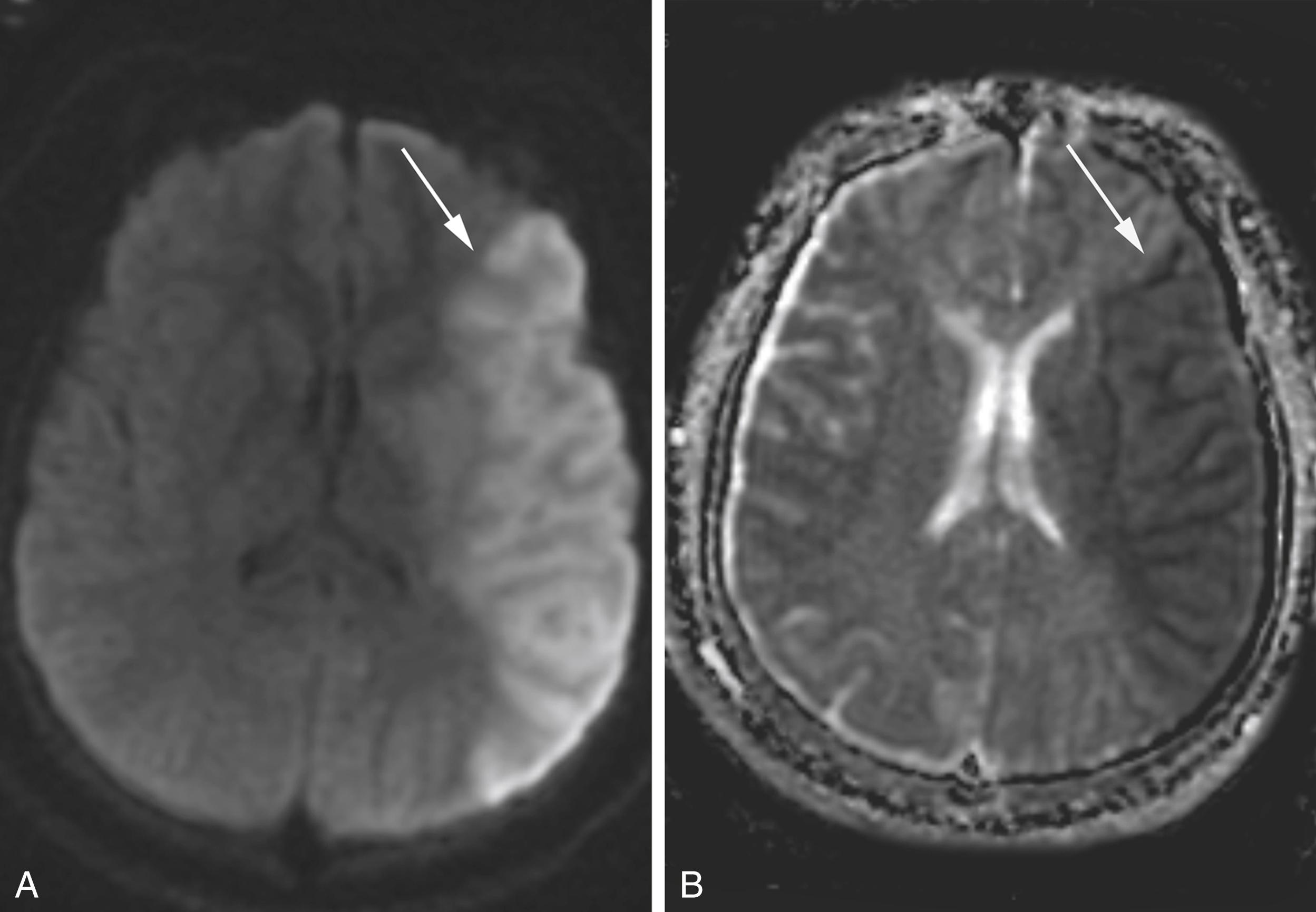
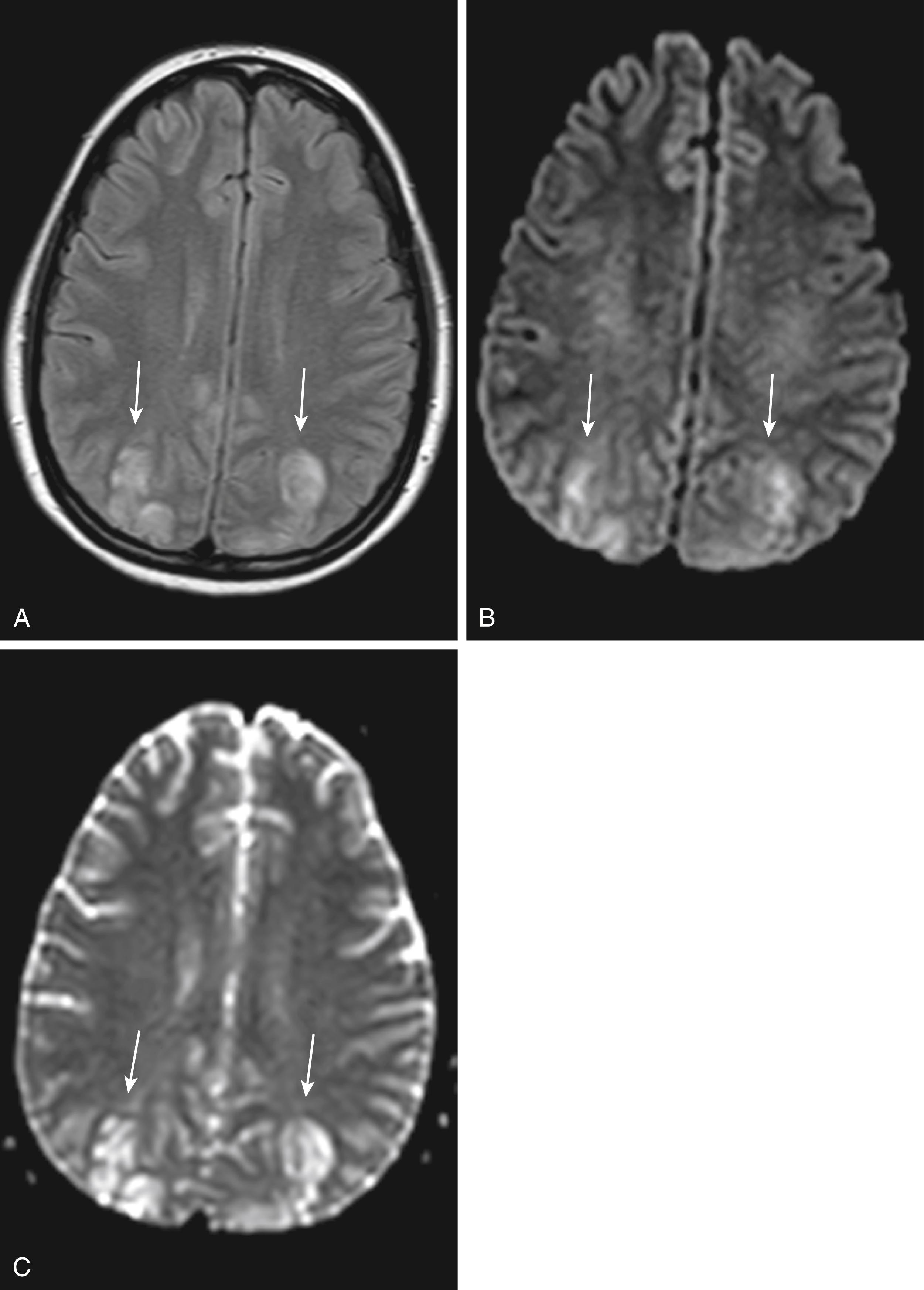
Restricted diffusion is seen in pathologic processes that present with cytotoxic edema including brain infarct and/or ischemia, nonhemorrhagic traumatic injury, seizure-related edema, and encephalitis. Other causes of diffusion restriction include purulent fluid collections ( Fig. 8-3A–C ), epidermoid cysts, subacute hematoma, and hypercellular tumors. Processes that show facilitated diffusion include vasogenic edema and cerebrospinal fluid (CSF) collections, such as an arachnoid cyst.
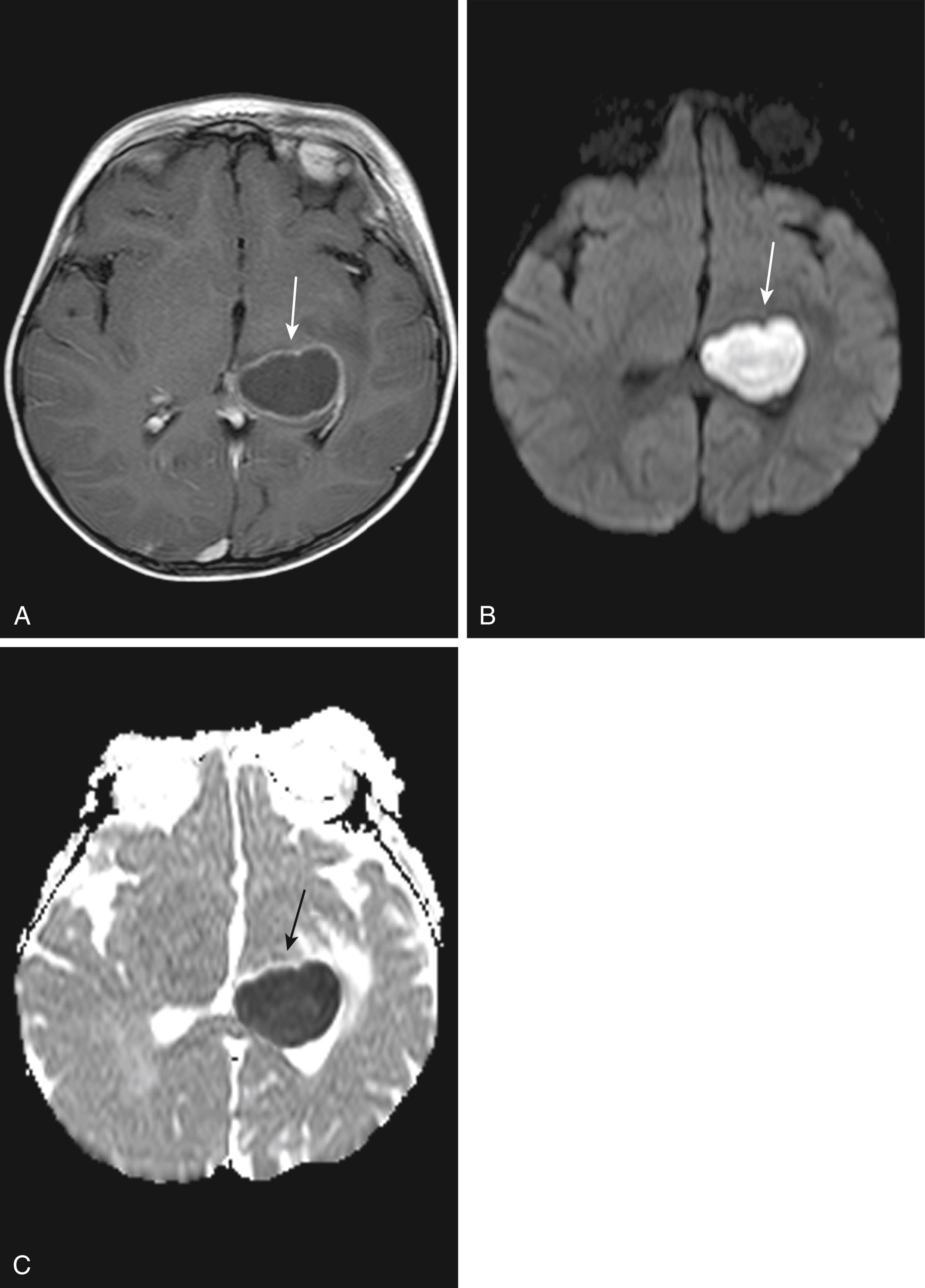
DWI has become an extremely important tool in neuroimaging. One of its major advantages is its high sensitivity for ischemia and infarction—often revealing findings not yet evident on conventional magnetic resonance (MR) sequences. It is also helpful in differentiating among posterior fossa tumors. Hypercellular medulloblastomas have restricted diffusion, whereas low-grade astrocytomas typically do not. Restricted diffusion is also rare in ependymomas. Table 8-1 shows a glossary of terms related to DWI and diffusion tensor imaging (DTI).
| Term | Definition |
|---|---|
| Isotropy | Uniformity of physical properties of a molecule in all directions; in other words, the absence of any kind of polarity |
| Anisotropy | The opposite of isotropy; having polarity or directionality |
| Eigenvalue | The mathematical property of a tensor (vector) related to magnitude and direction |
| Fractional anisotropy | A metric measuring the degree of anisotropy (0 for isotropy and 1 for full anisotropy) |
| ADC | A measure of the freedom of water diffusion in a particular tissue; increased ADC = increased diffusivity |
| Tractography | A postprocessing method of creating images representing axonal fiber tracts from diffusion tensor data |
| Tensor | The magnitude and direction of diffusion; is used similarly to the term vector . A 3 × 3 matrix is used to calculate a tensor |
Diffusion is anisotropic in white matter fibers, as axonal membranes and myelin sheaths act as barriers to the motion of water molecules in directions not parallel to their own orientation. By applying diffusion gradients in multiple directions during a diffusion MRI sequence, DTI technique enables the identification of the direction of maximum diffusivity in a voxel and therefore the identification of location, orientation, and directionality of the white matter tracts. DTI provides several capabilities not previously possible. (1) Large, individual white matter tracts can be depicted as discrete anatomic structures. The three-dimensional postprocessing technique used to create such images is tractography. (2) Metrics describing the microarchitecture of tissue can be calculated. They include fractional anisotropy, mean diffusivity, radial diffusivity, and axial diffusivity.
Tractography images are typically shown in color. By convention, white matter tracts oriented left to right are shown as red, cephalocaudad as blue, and anteroposterior as green ( Fig. 8-4 ).
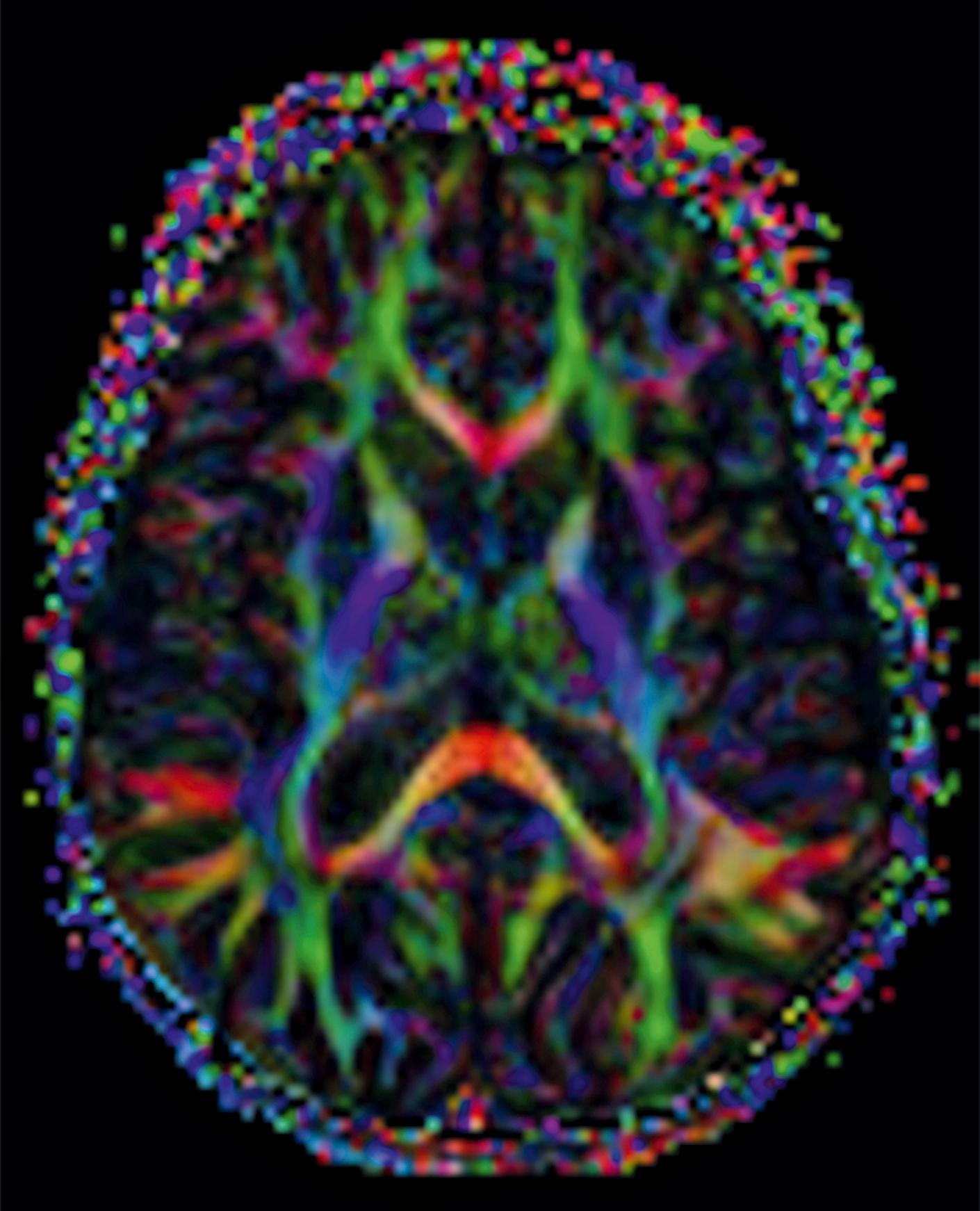
DTI and tractography can be used to evaluate myelination. Increased myelination increases anisotropy. Therefore, in normal infants, anisotropy increases with age. Most disease states that affect white matter decrease anisotropy. DTI has been used to evaluate stroke, hydrocephalus, trauma, and demyelinating disorders. DTI and tractography have also been used to study and depict the white matter tract abnormalities associated with congenital brain anomalies and in the presurgical evaluation of brain tumors ( Fig. 8-5 ). One important limitation of DTI-based tractography is that it underestimates the white matter tracts in parenchymal locations where there are crossing fibers. This is because a single tensor can resolve only a single fiber direction within a voxel. Recent studies have described new diffusion-based nontensor tractography techniques that demonstrate fiber tracts more accurately, but these are not yet being used in the routine clinical practices.
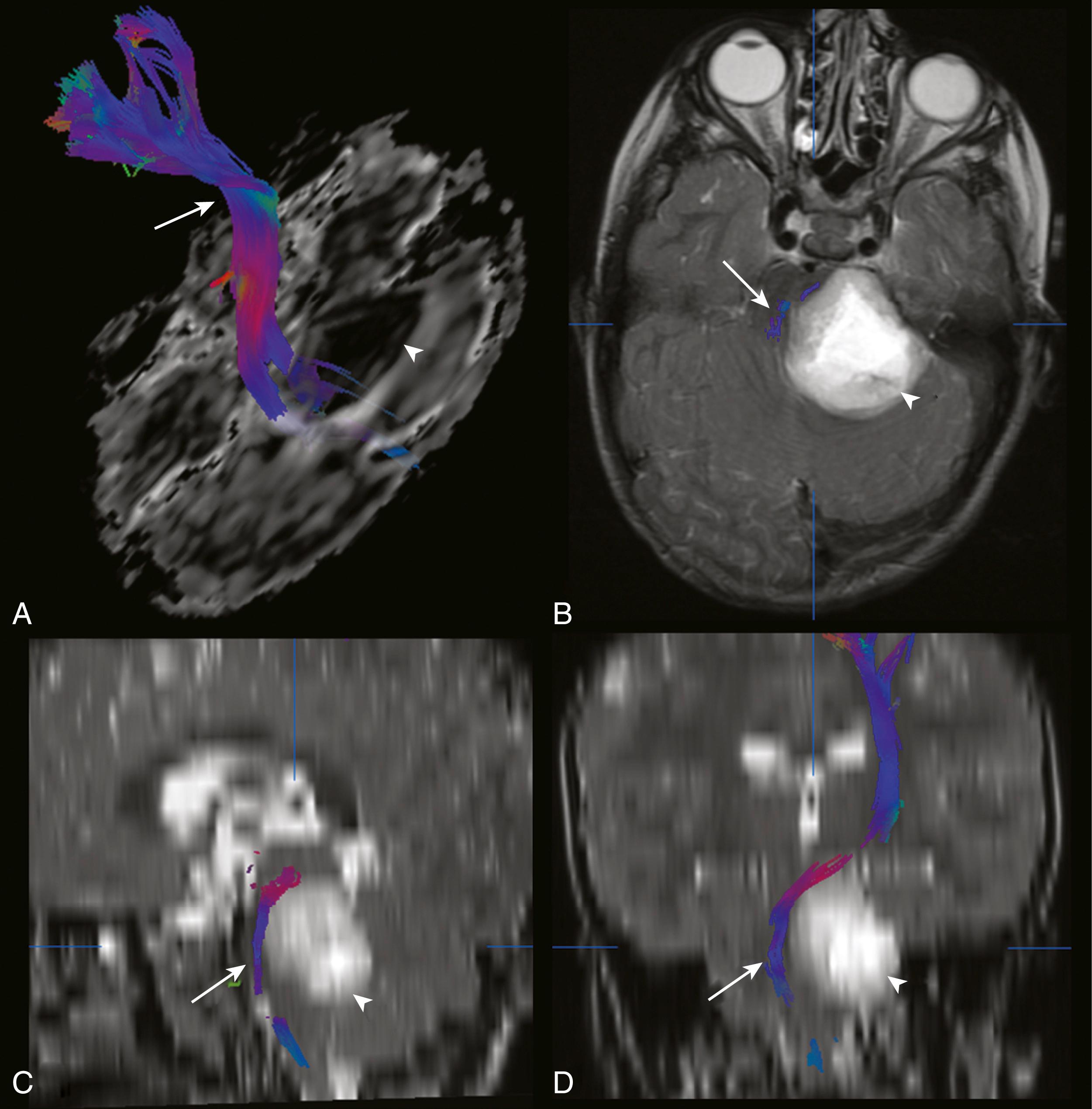
Perfusion MRI evaluates cerebral microvascular parameters, including cerebral blood volume, mean transit time, and cerebral blood flow. It relies on the use of a tracer that may be exogenous (gadolinium) in dynamic susceptibility contrast-enhanced and dynamic contrast-enhanced techniques or endogenous as in noncontrast arterial spin labeling technique. The main applications of perfusion MRI are evaluation of vascular pathologies (ischemic strokes, vasculopathies, vasospasm) and tumors. In the evaluation of brain tumors, perfusion may help with preoperative tumor grading and biopsy guidance by identifying high perfusion areas suspicious to represent higher grade portions of the tumor. Perfusion also plays a role in the evaluation of tumor treatment response and in the attempt to answer the always difficult question of tumor recurrence versus radiation necrosis.
Proton (hydrogen) MR spectroscopy (MRS) is a tool that is used to help to characterize a number of pediatric neurologic conditions. Most often, single-voxel spectroscopy is created using a 1-cubic centimeter sample area. The results of spectroscopy are typically depicted as a spectrum, with each metabolic peak characterized by resonance frequency, height, width, and area ( Fig. 8-6 ). Metabolic profiles depicted on MRS have been much less specific than originally hoped. However, the information obtained can provide useful information that complements the information derived from conventional MRI in many pediatric disorders, including neoplasms, hypoxic ischemic insult, and metabolic diseases.
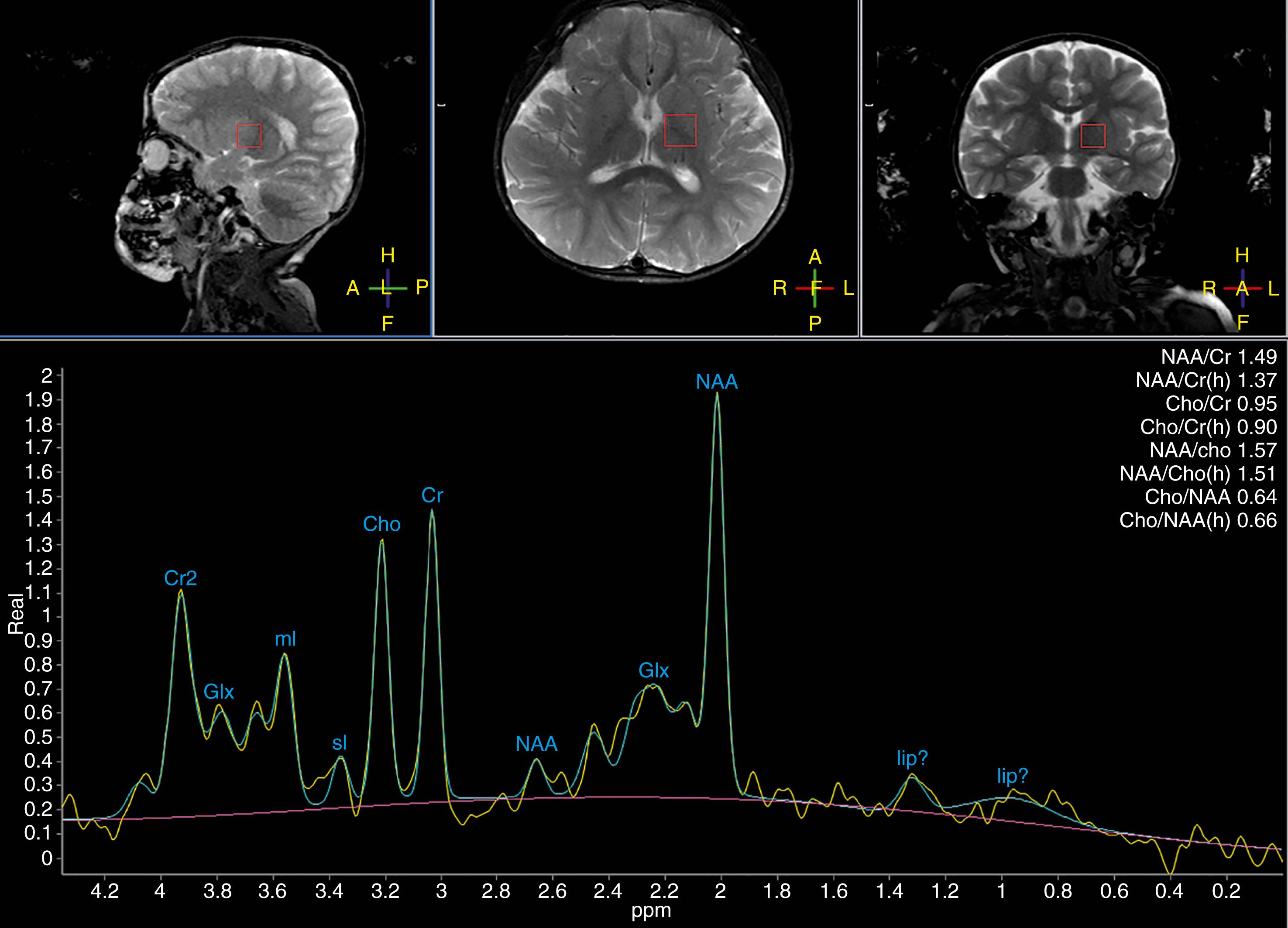
The most commonly evaluated brain metabolites include N -acetylaspartate (NAA), creatine (Cr), choline (Cho), myoinositol (mI), and lactate (Lac) (see Fig. 8-6 ). NAA is a neuronal marker and is decreased in most disorders that decrease neuronal viability and density, such as neoplasms ( Fig. 8-7 ), infarcts, radiation injuries, and many white matter diseases. NAA is markedly elevated in Canavan disease and may also be elevated in Salla disease and Pelizaeus–Merzbacher disease. Cho compounds reflect the synthesis and degradation of cell membranes; therefore, increased Cho is seen when there is high cellular turnover, as occurs with most tumors (see Fig. 8-7 ). Lac is a product of anaerobic glycolysis, typically elevated in the setting of acute ischemia ( Fig. 8-8 ), infarction, abscess, many high-grade tumors, and some metabolic diseases, such as mitochondrial disorders. mI is considered a glial marker, elevated in gliosis and astrocytosis in pediatrics. Cr is relatively constant; therefore, it is used as an internal reference for calculation of metabolite ratios. Cr deficiency syndromes are rare causes of decreased Cr levels. Taurine (Tau) is not a commonly seen metabolite in clinical MRS; however, it has been shown to be elevated in medulloblastoma and therefore is an important metabolite to recognize in pediatric posterior fossa tumors (at 3.3 ppm, above baseline on short TE 30–35 and below baseline on TE 144).
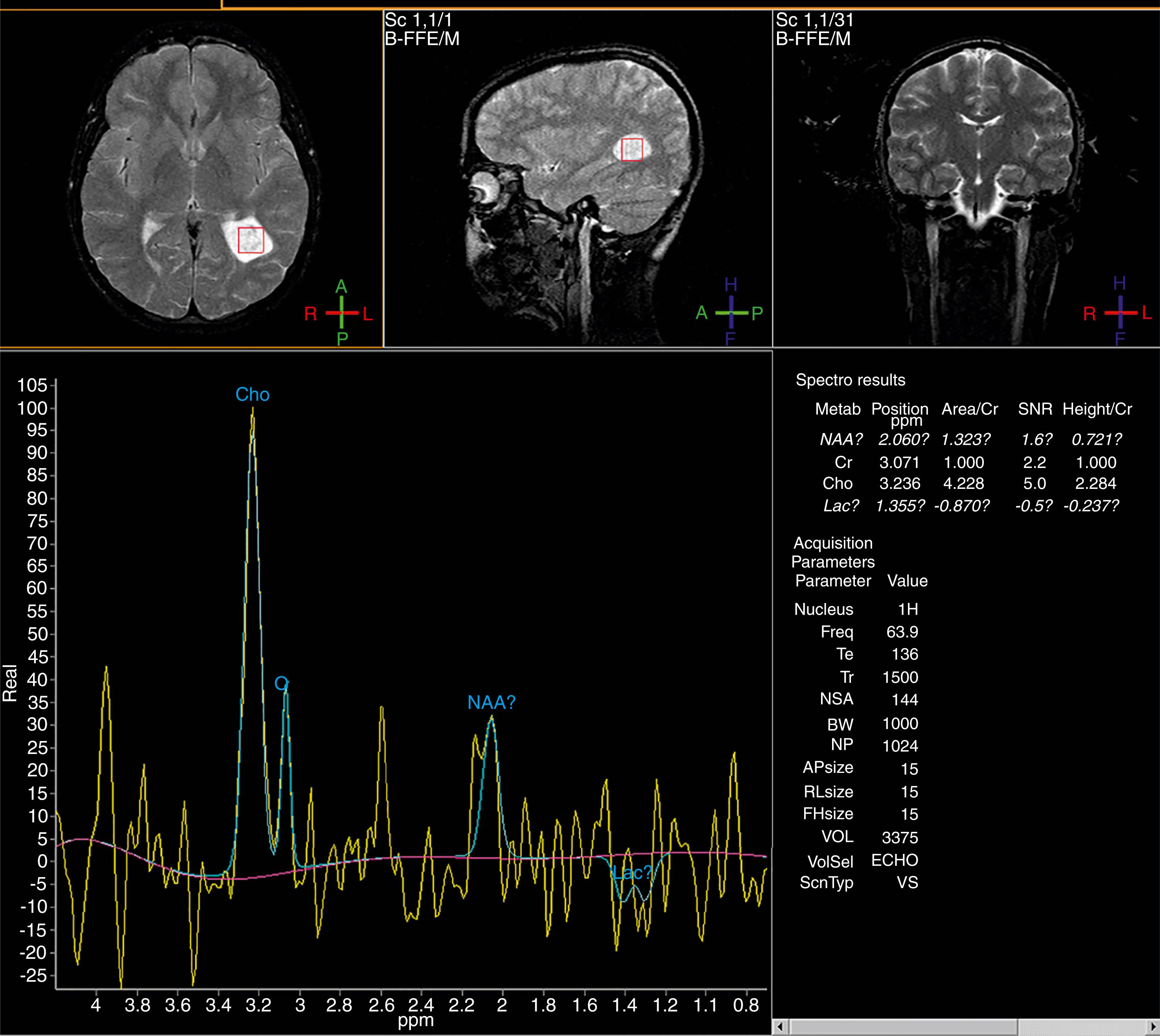
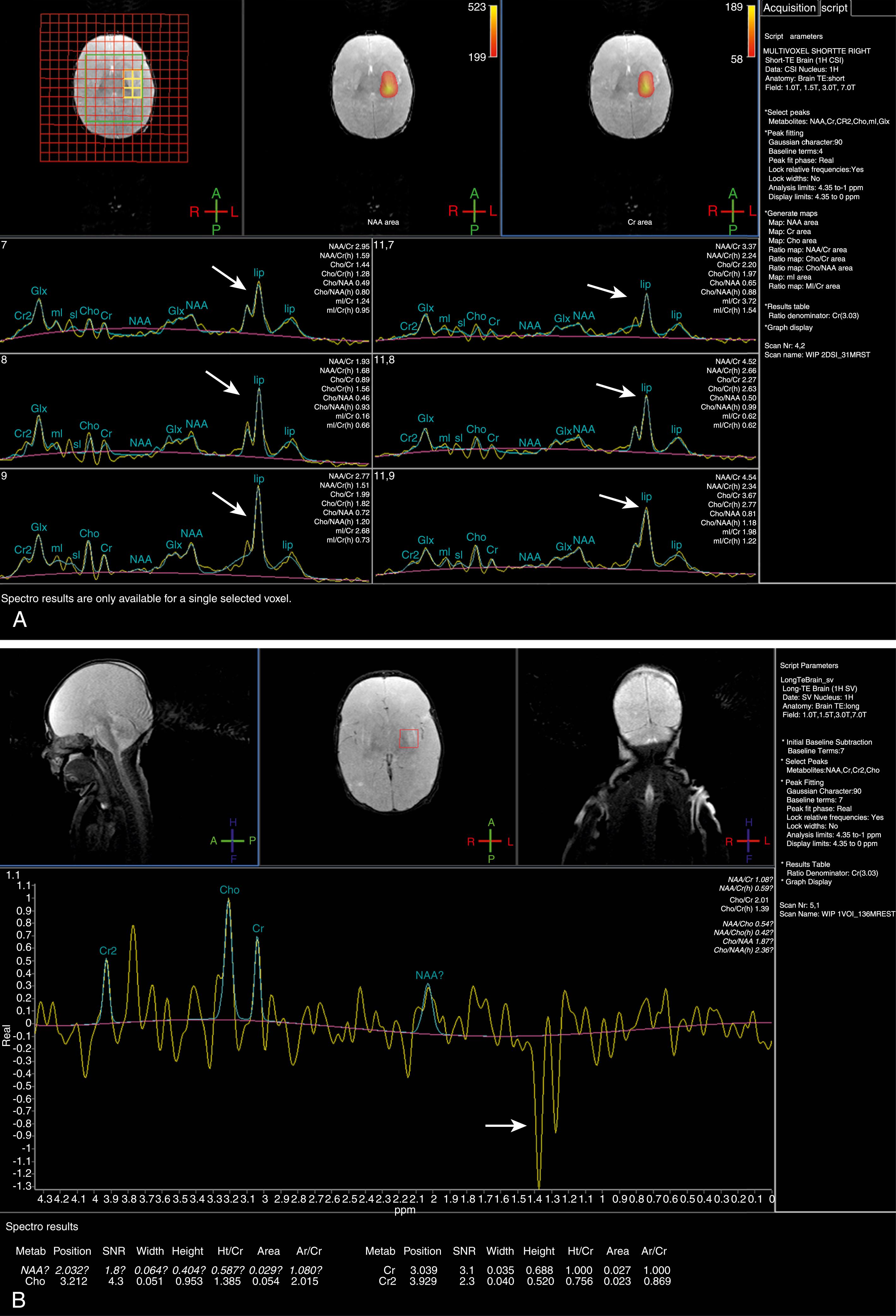
There are differences in metabolite levels in the gray and white matter. The concentration of NAA in gray matter is higher than in white matter, and Cho concentration is typically higher in white matter. There are also differences in metabolite levels in the developing brain, especially during the first year of life. In the newborn period, NAA levels are low and mI and Cho levels are high ( Fig. 8-9 ). Small Lac peak can also be found in healthy newborns.
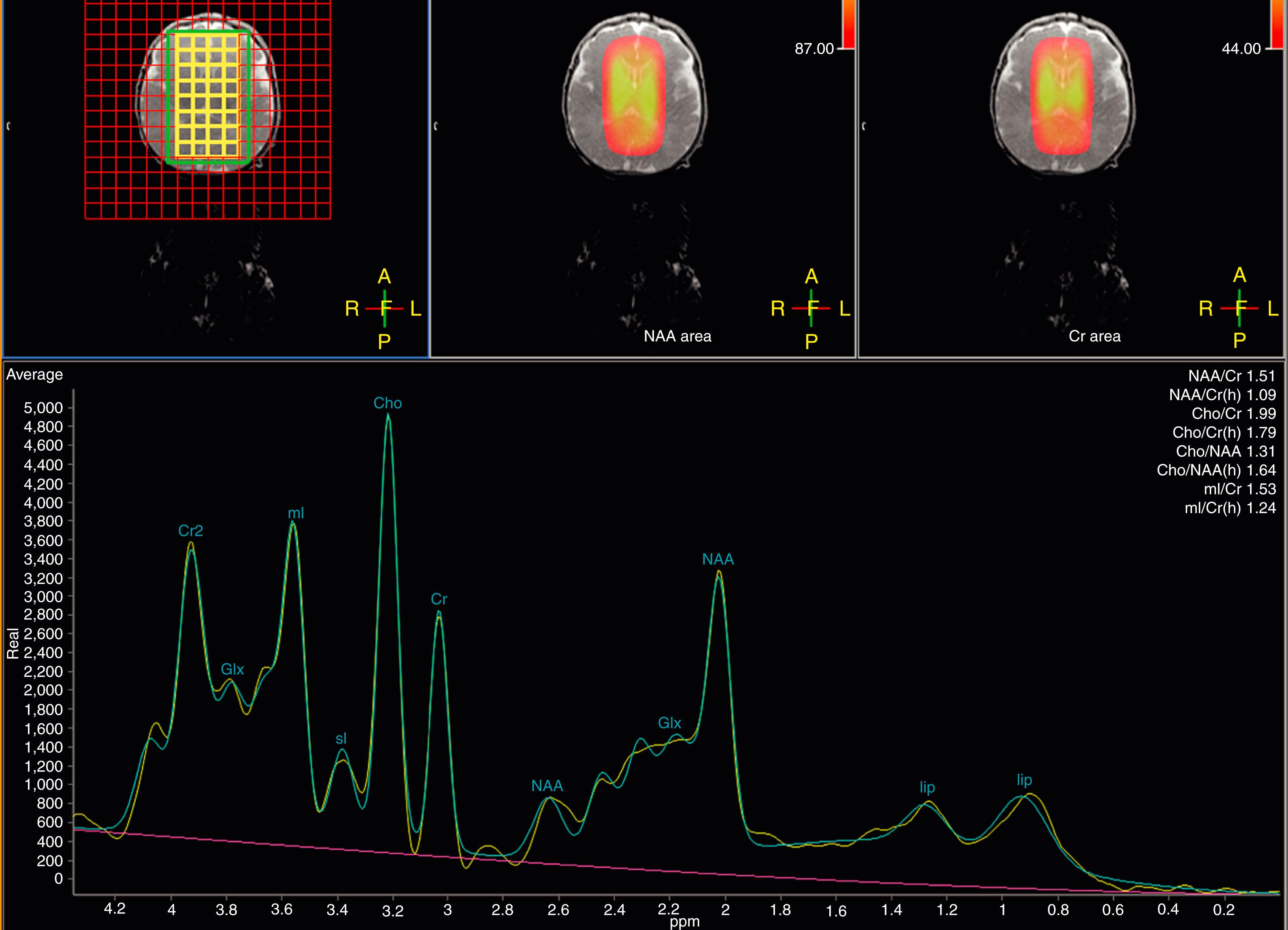
Functional MRI (fMRI) is a noninvasive method of evaluating regional neuronal activity within the brain. Neuronal activity increases metabolic activity, which results in increased blood flow to that region and a relative increase in the ratio of oxygenated hemoglobin to deoxygenated hemoglobin. Deoxyhemoglobin is paramagnetic; therefore, a change in the ratio affects the magnetic state of the tissue and, as a result, changes the local MRI signal. This phenomenon is called the blood oxygenation level–dependent (BOLD) effect. fMRI techniques show these changes superimposed on anatomic information. fMRI is used to document regional neuronal activity during a specific task. The most validated use is for localization of different body representations in the primary motor and somatosensory cortex, as well as language lateralization ( Fig. 8-10A–F ). Clinically, fMRI has been used in the evaluation of patients with seizures and planning of surgical approaches to brain tumors. It also has been a very useful research tool in increasing our understanding of brain function. Current research is mostly focused on resting state techniques (R-fMRI), which measure BOLD fluctuations of spontaneous neuronal activity without the performance of a specific task.
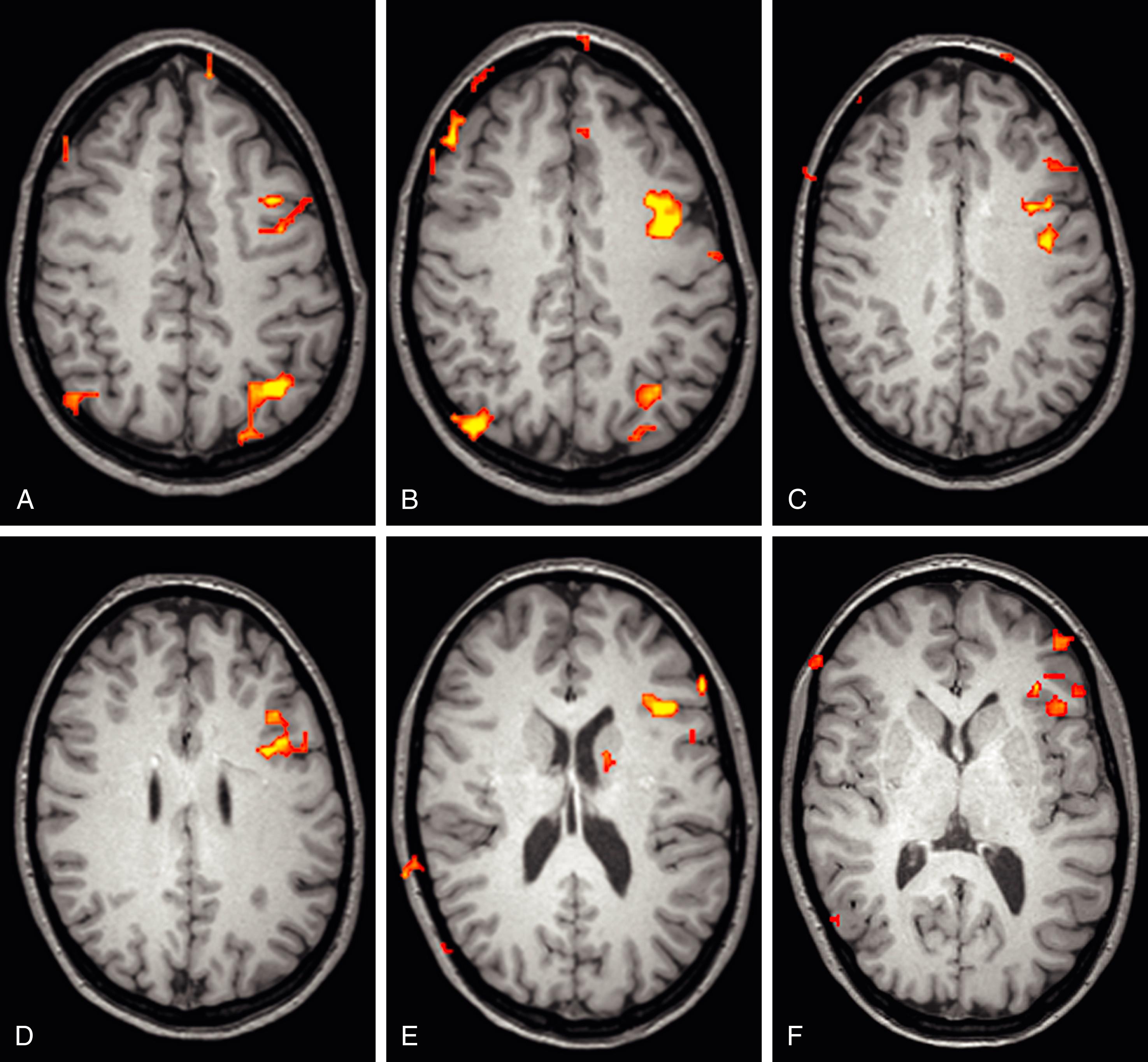
Neonatal head ultrasound is performed through the open fontanels of neonates and infants using high-frequency transducers. Images are commonly obtained in the sagittal and coronal planes via the anterior fontanel using a sector transducer ( Fig. 8-11A and B ). Linear high-resolution transducers are used to assess the extraaxial spaces ( Fig. 8-12A and B ) and superficial cortex. Additional images via the mastoid fontanel enable the detection of posterior fossa hemorrhages ( Fig. 8-13A and B ) and congenital anomalies. Evaluation via the posterior fontanel can be used for differentiation of white matter injury versus anisotropy artifact in cases of abnormally increased posterior periventricular white matter echogenicity. In premature infants, head ultrasound is most commonly used to diagnose and follow up intracranial complications, such as germinal matrix hemorrhage and white matter injury of prematurity (periventricular leukomalacia). It can also be used to screen for congenital abnormalities and hydrocephalus. Another common indication is evaluation of an infant with a large head circumference.
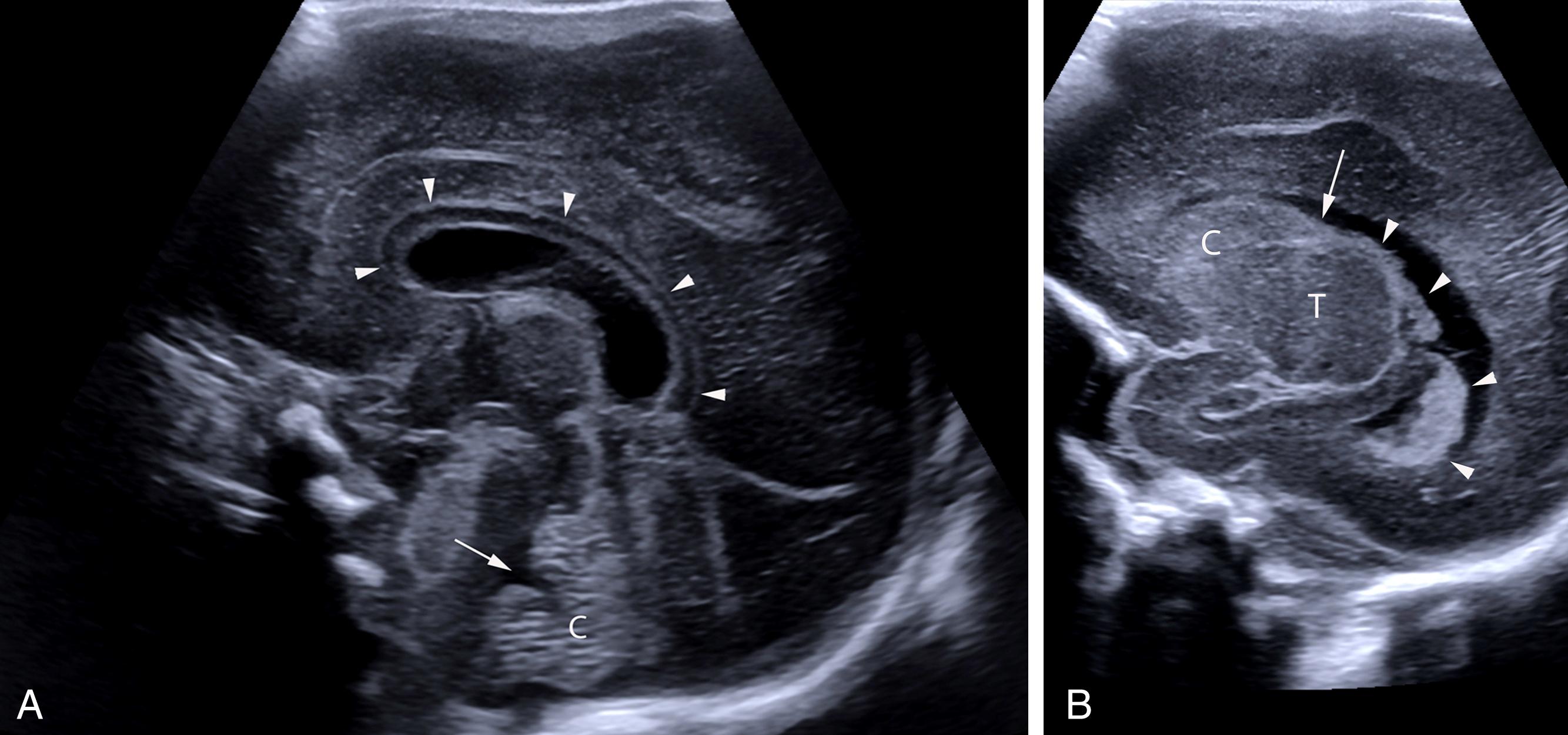
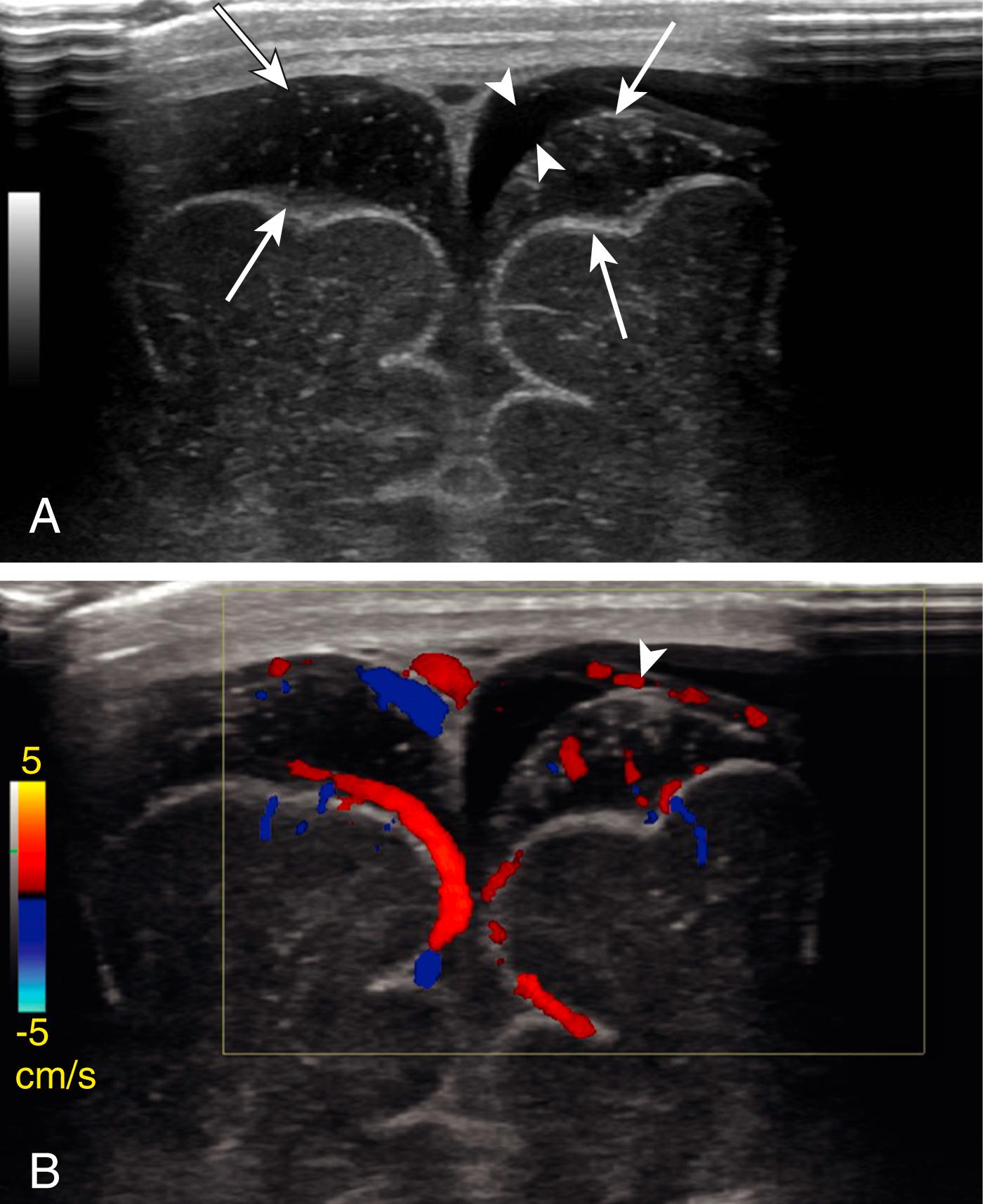
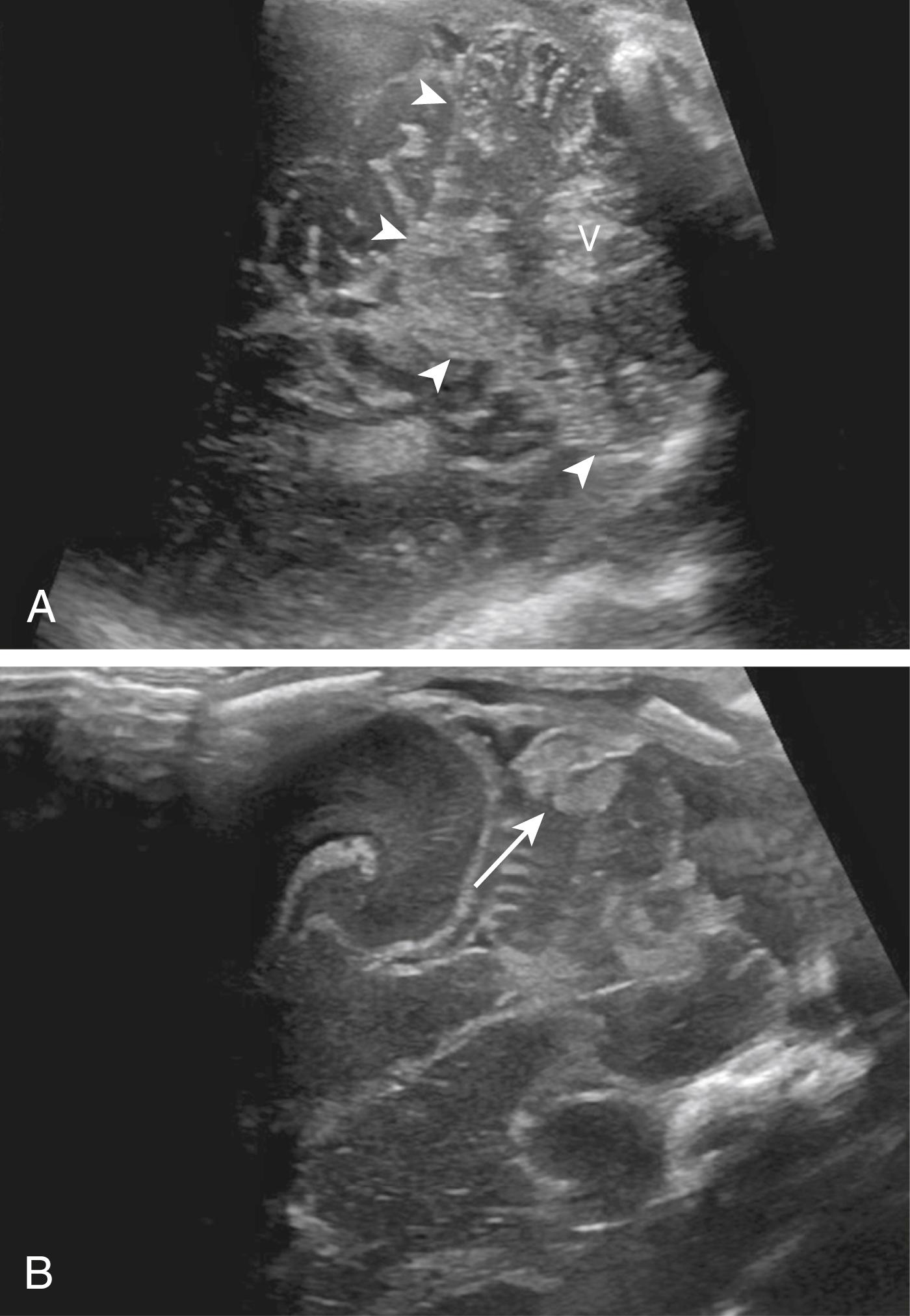
The germinal matrix is a fetal structure that is a stem source for neuroblasts. It typically involutes by term but is still present in premature infants, mostly within the caudothalamic groove (the space between the caudate head and the thalamus). The germinal matrix is highly vascular and is subject to hemorrhaging with fluctuation in cerebral blood pressure. Germinal matrix hemorrhage most commonly occurs in premature infants during the first days after birth. Potential complications include destruction of the precursor cells within the germinal matrix, hydrocephalus, and hemorrhagic infarction of the surrounding periventricular tissues. Cerebellar hemorrhage can also be seen in very premature patients ( Fig. 8-13A and B ).
On ultrasound, germinal matrix hemorrhage is seen as an ovoid echogenic mass within the caudothalamic groove ( Figs. 8-14A and B ). For those not well acquainted with head ultrasound, there may be confusion in differentiating germinal matrix hemorrhage from the normally echogenic choroid plexus. In contrast to germinal matrix hemorrhage, normal choroid plexus should never extend as anterior as the caudothalamic groove on a parasagittal view ( Fig. 8-11B ). Hemorrhage may extend into the ventricular system and lead to hydrocephalus. Germinal matrix hemorrhage is categorized into one of four grades ( Table 8-2 ). Intraparenchymal hemorrhage (grade IV) is secondary to venous infarction of the deep medullary veins ( Fig. 8-15A and B and Fig. 8-16 ) rather than a direct extension of hemorrhage. Grades I and II hemorrhages tend to have good prognosis. In contrast, grades III and IV hemorrhages tend to have poor prognosis, including high incidences of neurologic impairment, hydrocephalus, and death.
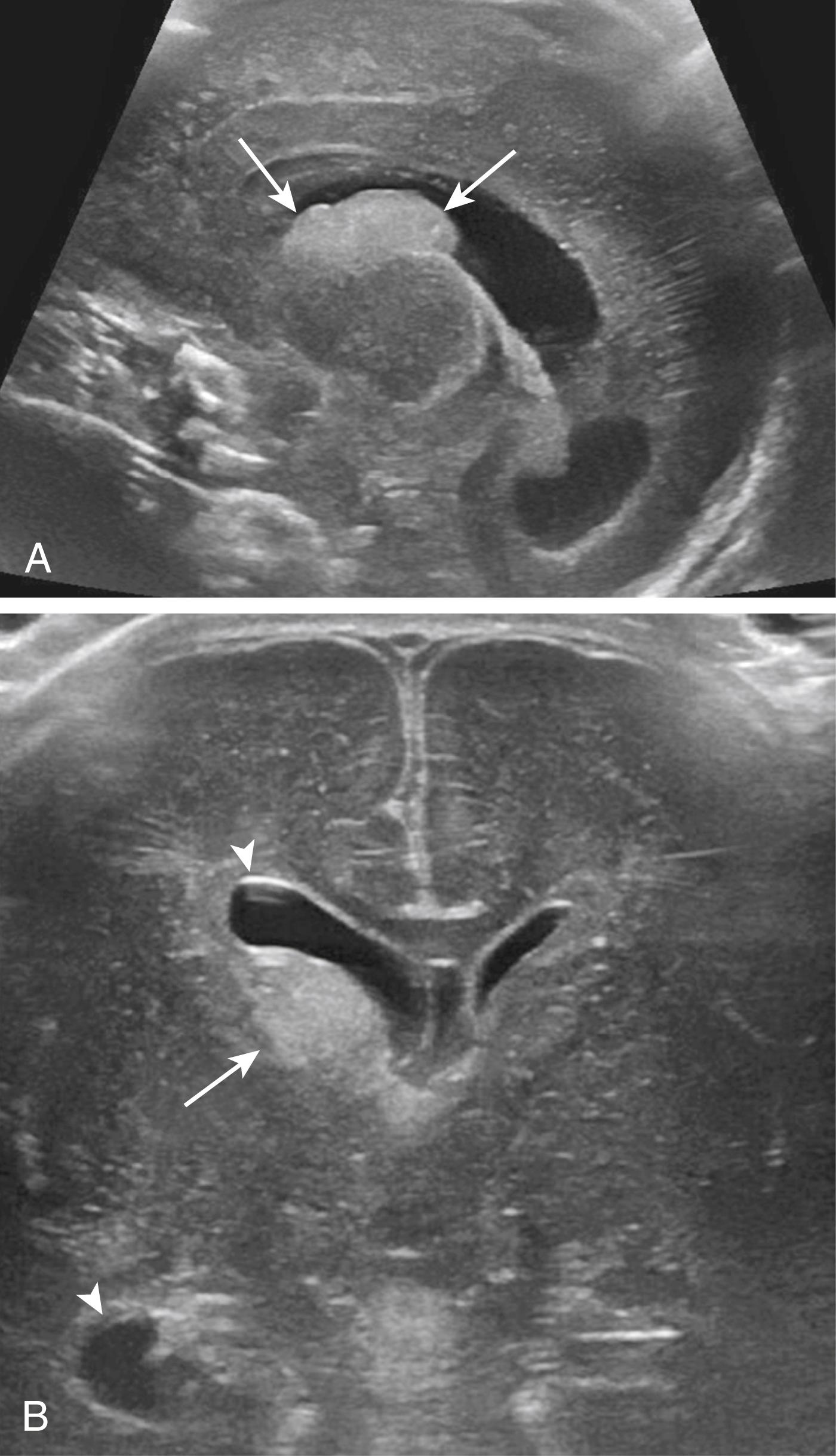
| Grade | Morphologic Findings |
|---|---|
| I | Hemorrhage confined to germinal matrix |
| II | Intraventricular hemorrhage without ventricular dilatation |
| III | Intraventricular hemorrhage with ventricular dilatation |
| IV | Intraparenchymal hemorrhage |
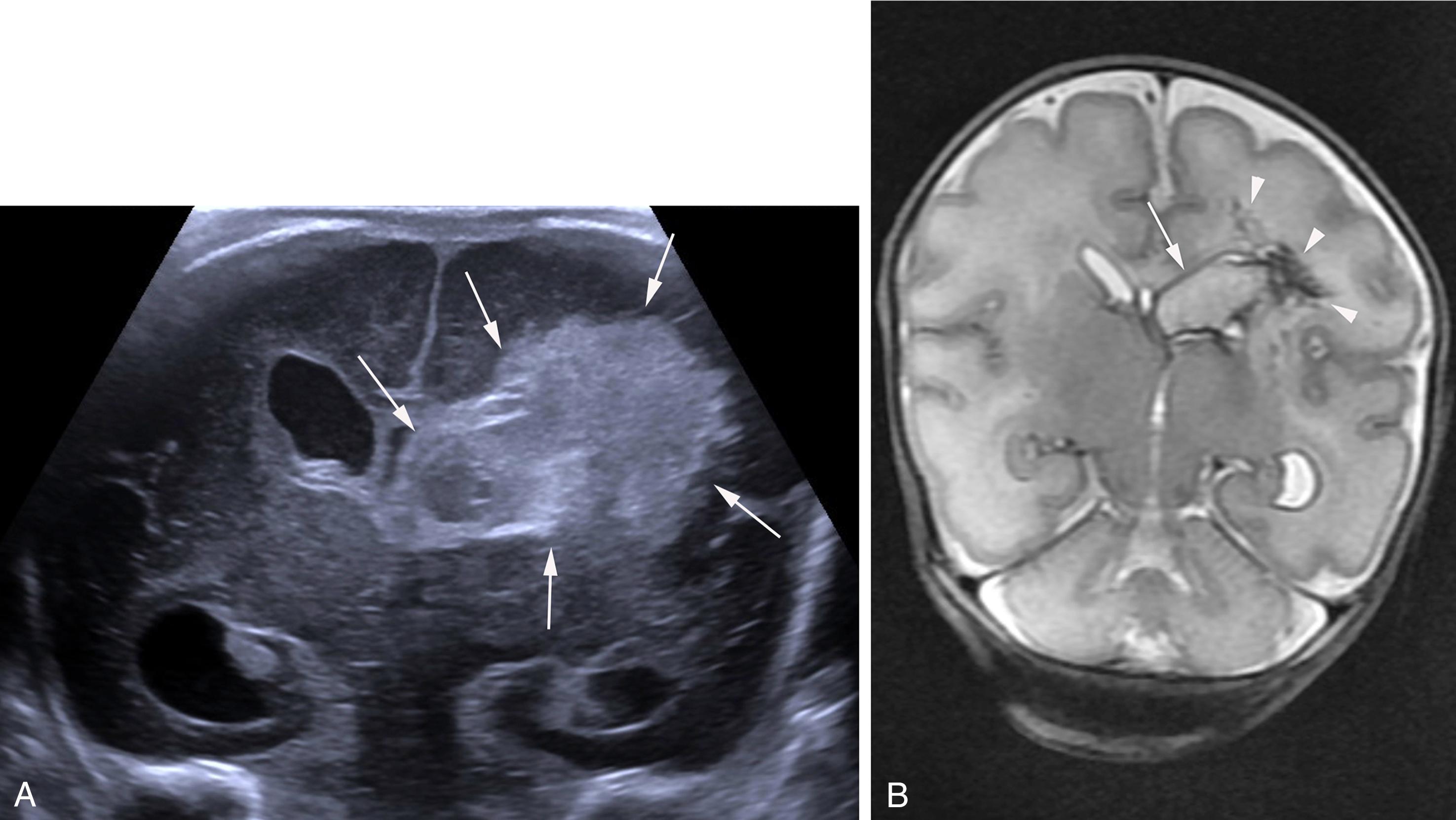
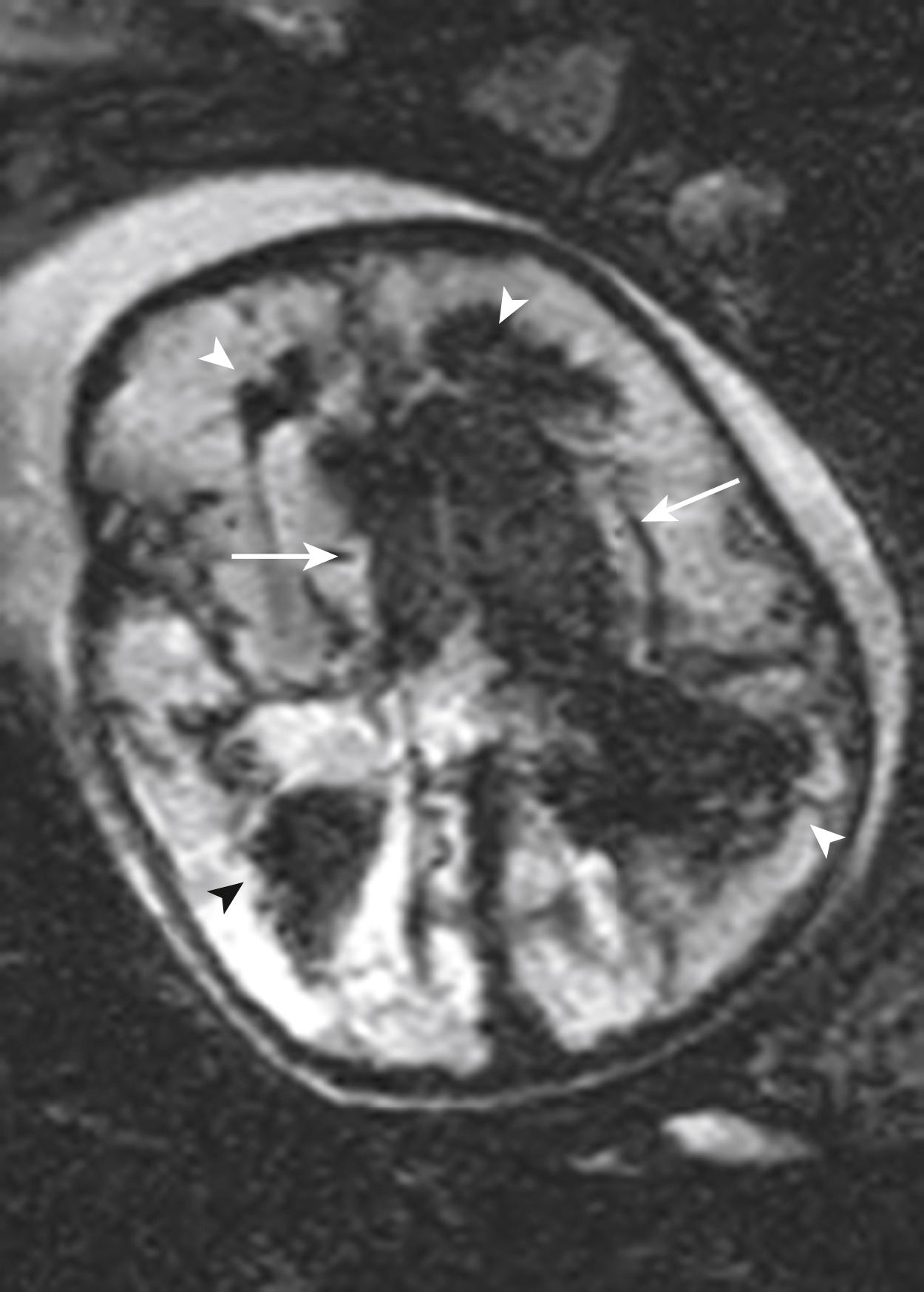
Benign enlargement of extraaxial spaces (benign macrocrania) is a diagnosis of exclusion. The term refers to children with large heads (head circumference greater than 97% for age), prominent subarachnoid spaces, and normal development. Typically, such children present between 6 months and 2 years of age. After 2 years of age, the head size usually normalizes, and the children have no long-term consequences. The parents of such children often have large heads or had large heads as infants. On imaging, there is a prominent size of subarachnoid spaces and normal to borderline prominent ventricular system ( Fig. 8-17A–C ). Imaging is otherwise normal. Clinical follow-up is necessary to exclude loss of milestones or continued increase in head circumference that may indicate communicating hydrocephalus.
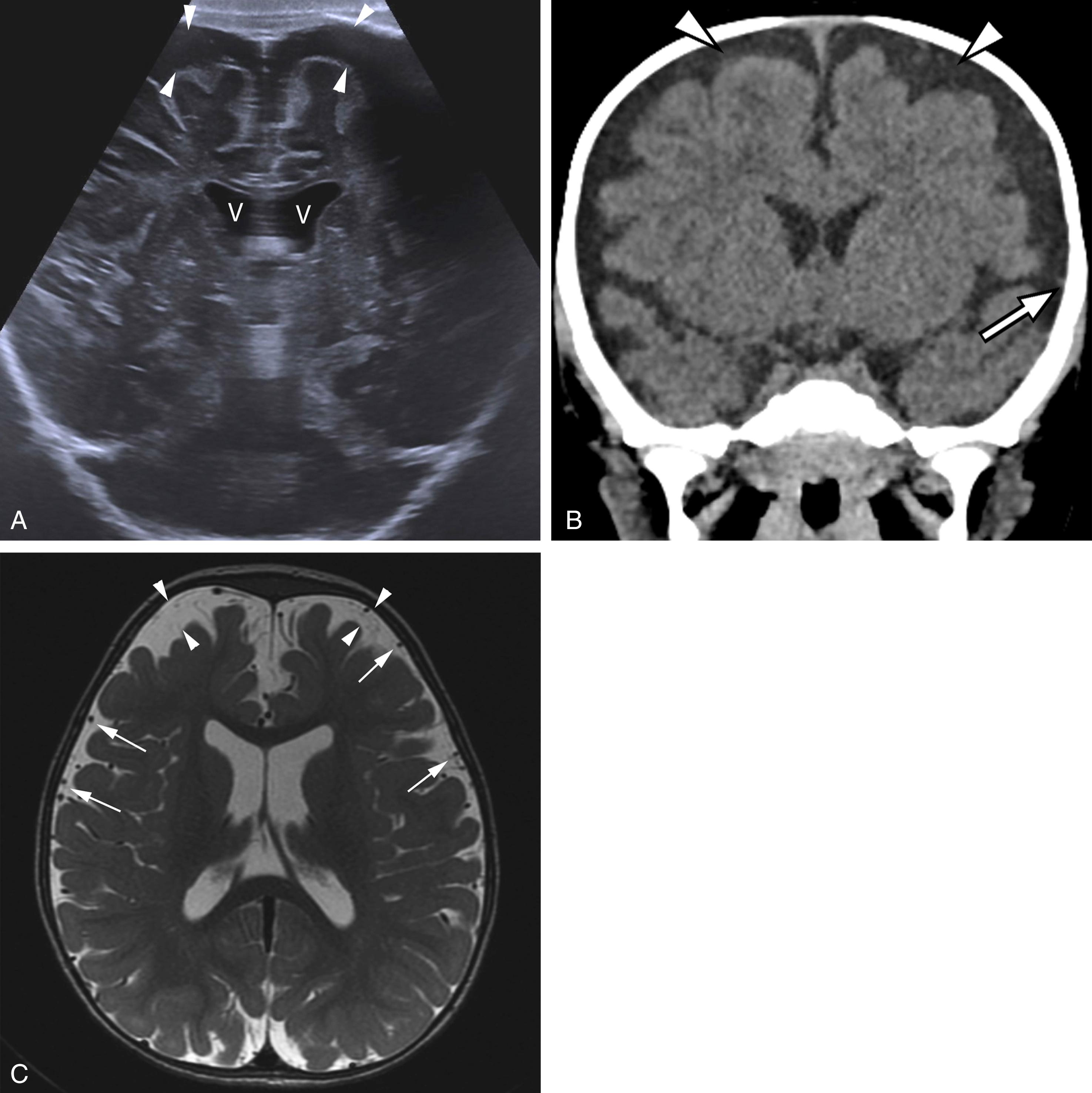
Significant changes in brain myelination occur during the first 24 months of life. Before myelination, white matter is hydrophilic and, because it contains water, appears high in signal on T2-weighted images and low in signal on T1-weighted images ( Figs. 8-18A and B and 8-19 ). With myelination, the white matter becomes hydrophobic and, because it contains less water, appears low in signal on T2-weighted images and high in signal on T1-weighted images ( Fig. 8-18C and D ). Myelination starts in utero and progresses from caudal to cranial, central to peripheral, and dorsal to ventral, paralleling neurologic development. In myelinating white matter, T1 shortening precedes T2 shortening. Therefore, T1-weighted sequence is the preferred sequence for the evaluation of normal myelination from birth until 6 months of age, whereas T2-weighted sequence is more frequently used after 6 months, especially after 1 year of age. Myelination in a term infant on T1-weighted sequence is seen along the vermis, dentate nucleus, dorsal brainstem, cerebellar peduncles, globus pallidi, ventrolateral thalami, posterior aspect of the posterior limb of internal capsule (PLIC), central corona radiata, perirolandic regions, and optic tracts ( Fig. 8-20A–D ). During the first 3 months of life, there is progressive myelination of the spinal cord and brainstem, followed by myelination of the cerebellar white matter. The corpus callosum begins to myelinate in the splenium (posterior part) at 2–3 months of age, proceeds anteriorly, and is completely myelinated through the rostrum (anterior part) by 6–8 months of age. Table 8-3 summarizes the expected myelination milestones in T1 and T2 sequences, with key milestones highlighted in bold. Myelination becomes similar to adult patterns on T2-weighted sequence by 24–36 months of age, with the exception of few terminal zones. Terminal zones of myelination can be seen in the frontotemporal subcortical white matter until the age of 36–40 months, whereas the commonly identified posterior periventricular terminal zones of myelination can be seen as late as teenage years ( Fig. 8-21A and B ).
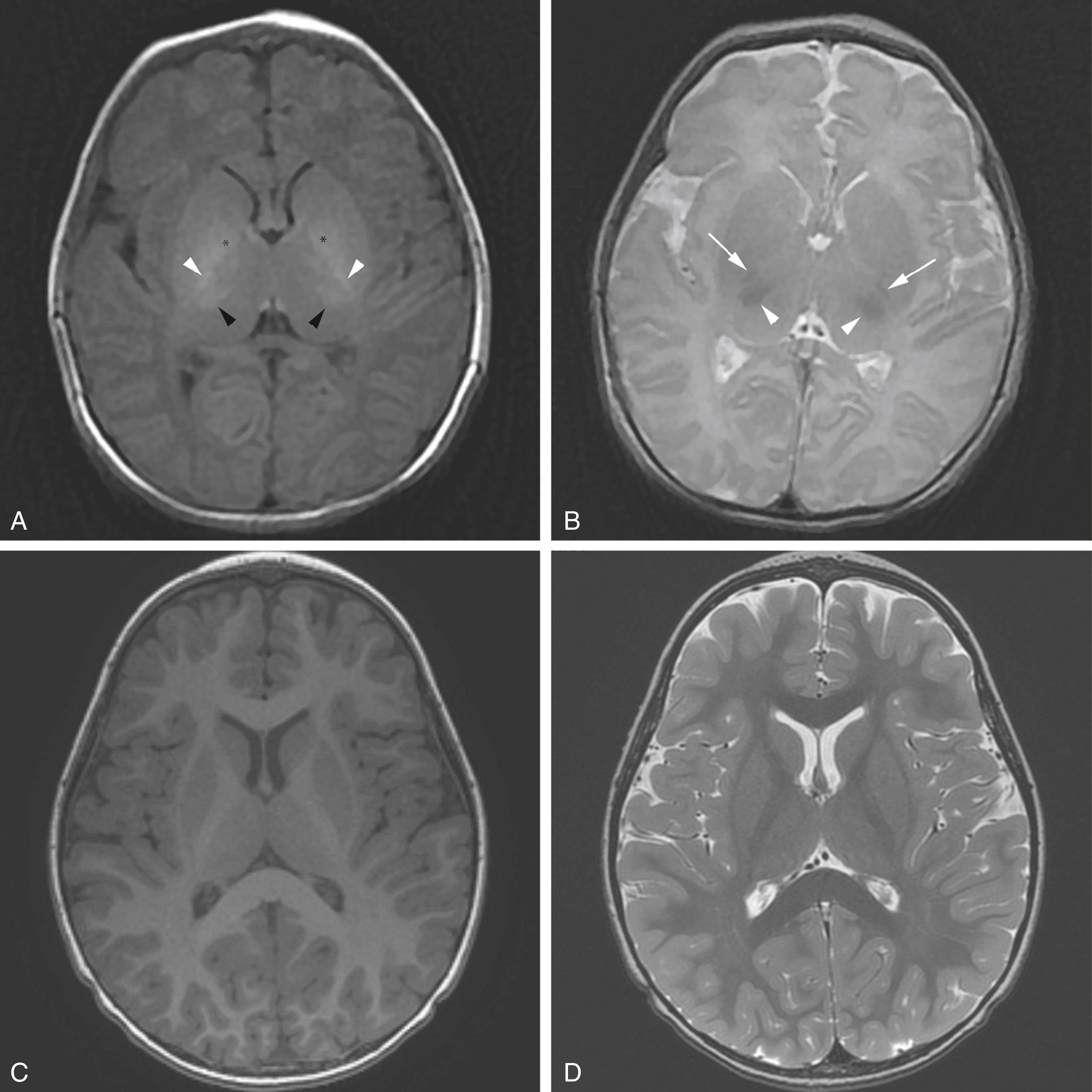
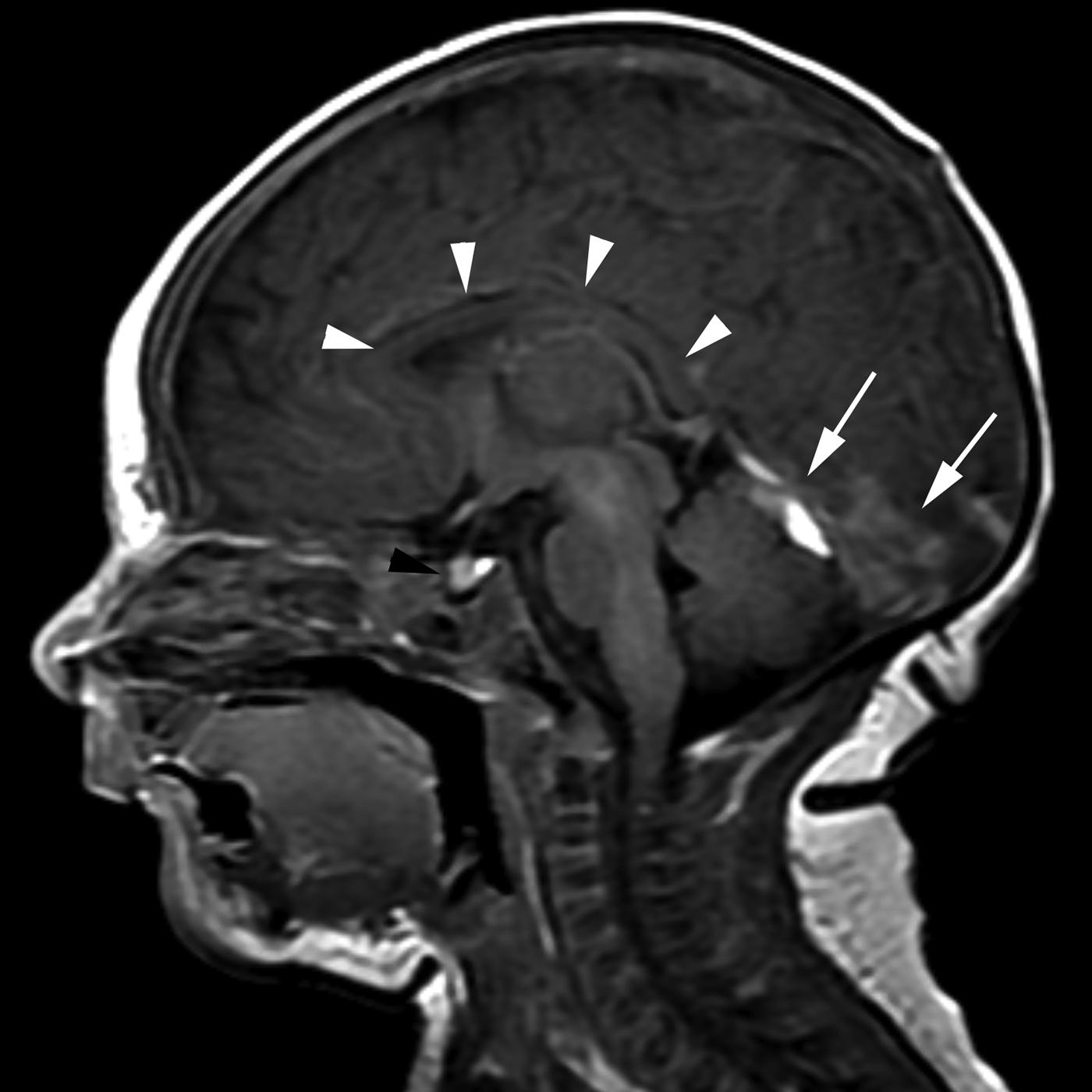
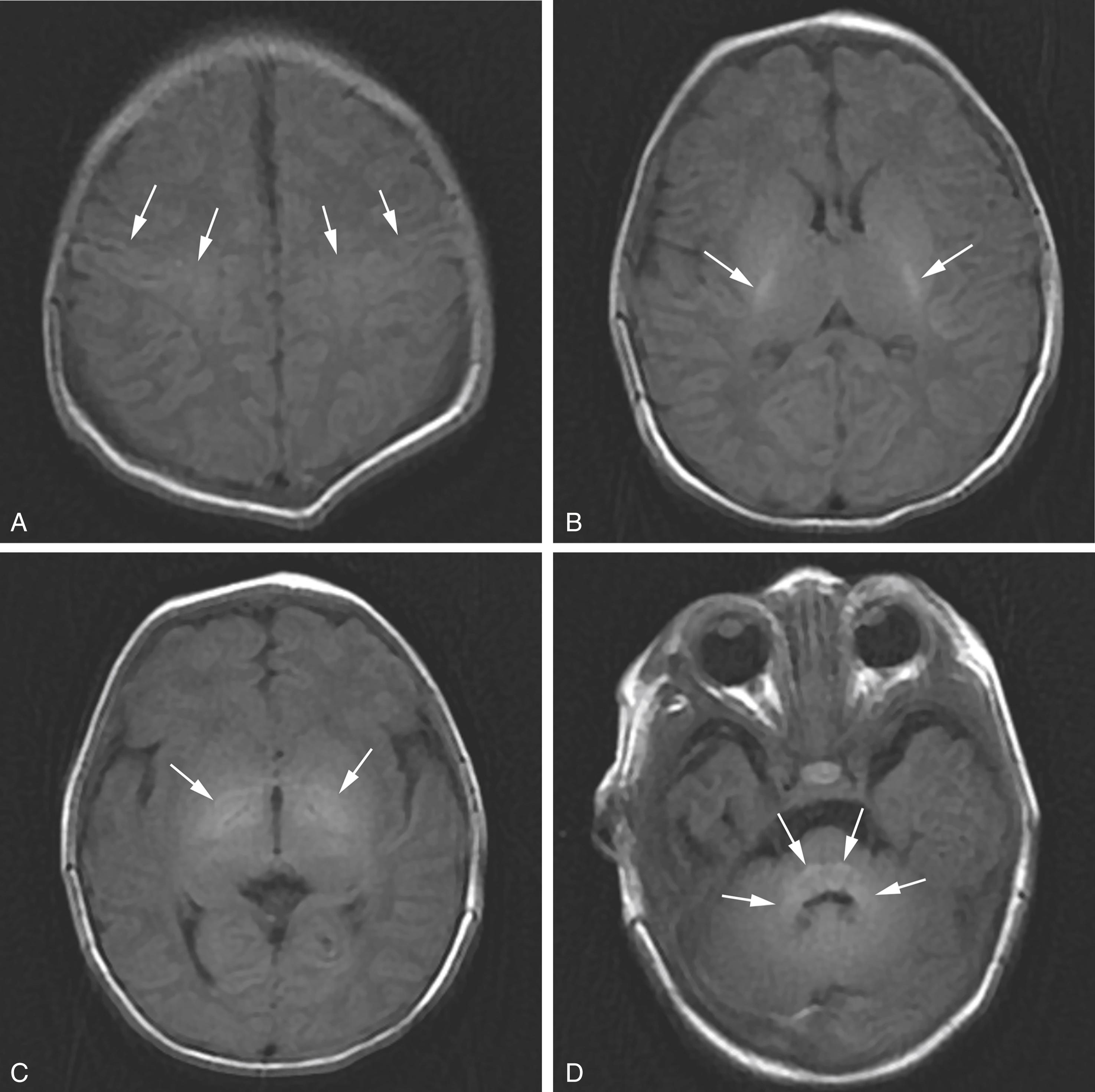
| Age | T1 High Signal | T2 Low Signal |
|---|---|---|
| Term | Rolandic or perirolandic gyri (up to 2 mo) | Central CR |
| Central CR | Posterior ⅓ of PLIC | |
| PLIC | Dorsal pons | |
| Globus pallidi | Vermis | |
| Lateral thalamus | ||
| Optic radiations | ||
| Dorsal brainstem | ||
| Cerebellar peduncles | ||
| Dentate nucleus | ||
| Vermis | ||
| By 3–4 mo | Splenium of corpus callosum | ½ PLIC |
| Cerebellar white matter | Optic radiations | |
| ALIC | Middle cerebellar peduncle | |
| Anterior pons | Dentate nucleus | |
| Hippocampus | ||
| Central occipital white matter | ||
| By 6 mo | Genu of corpus callosum | Splenium of corpus callosum |
| Deep frontal white matter | Entire PLIC | |
| Cerebellar white matter | ||
| Anterior pons | ||
| By 8 mo | Near adult, except for most peripheral temporal and frontal subcortical branches | Genu of corpus callosum |
| ALIC (at least partially) | ||
| Increasing myelination of CR | ||
| By 12 mo | Temporal white matter | CR |
| ALIC | ||
| Deep occipital white matter | ||
| By 14–18 mo | Subcortical U-fibers | Deep frontal white matter |
| Branching occipital white matter | ||
| 18–24 mo | Fully myelinated | Near adult, except for most peripheral temporal and frontal subcortical branches |
| 24–36 mo | Fully myelinated |
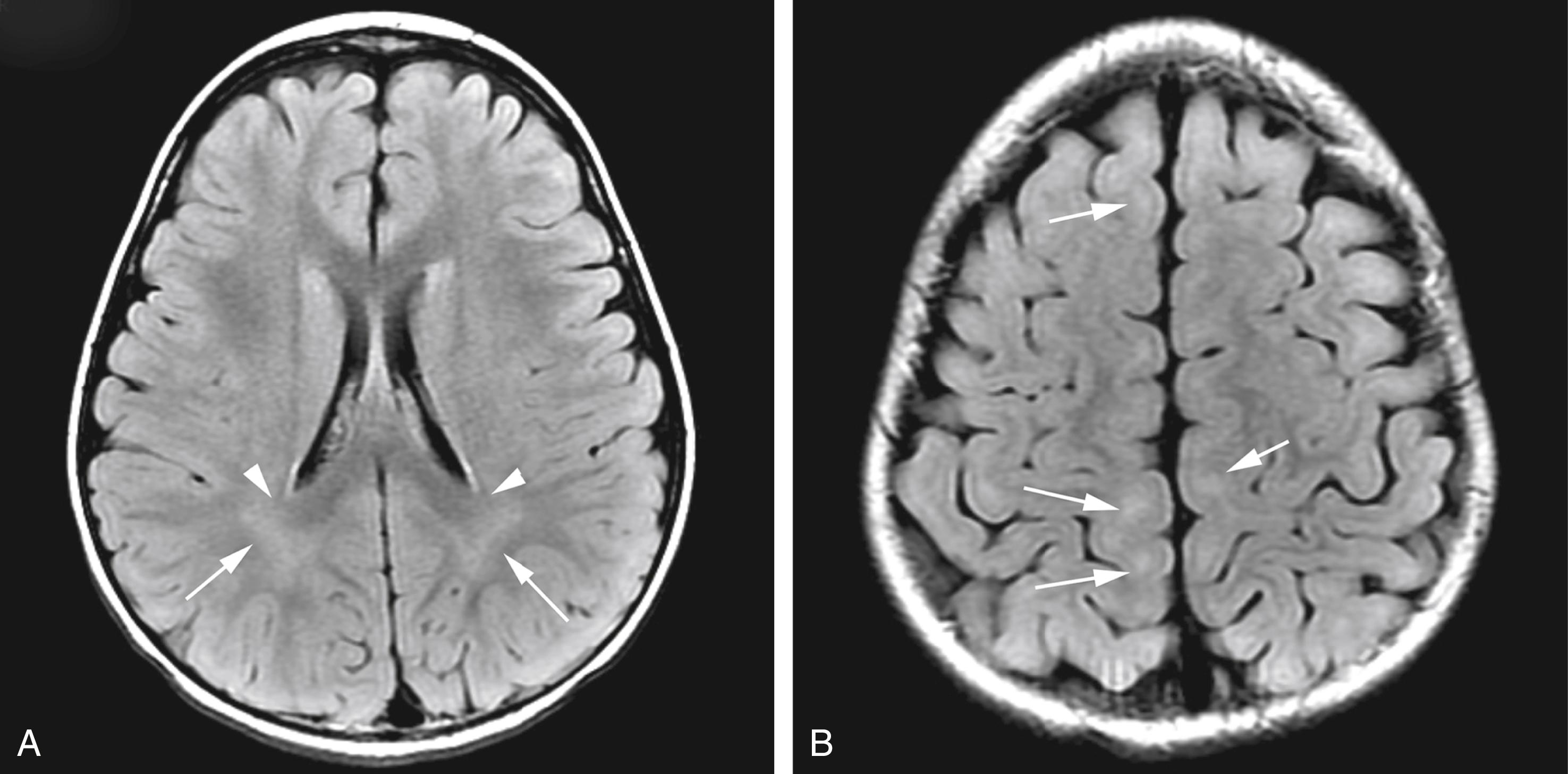
Assessing myelination has become a key component in the evaluation of children with developmental delay. Abnormal myelination is a nonspecific finding and can be secondary to a number of causes, including metabolic disease, infection, trauma, hypoxia–ischemia, and genetic or malformative syndromes.
Perinatal partial asphyxia in premature neonates can result in damage to the periventricular white matter, the watershed zone of the premature infant, and result in white matter injury of prematurity (periventricular leukomalacia). It most commonly affects the white matter adjacent to the atria, frontal horns, and corona radiata along the lateral ventricles ( Fig. 8-22 ). On ultrasound, increased heterogeneous echogenicity is seen within the periventricular white matter ( Fig. 8-23A and B ). It is associated with neurologic sequelae, such as movement disorders, seizures, and spasticity. In severe cases, there may be cystic necrosis and development of periventricular cysts during the subacute and chronic phases ( Fig. 8-24 ). With time, there is often volume loss of the involved white matter ( Fig. 8-25A and B ). Doppler interrogation of the circle of Willis may add value in the evaluation of acute ischemia and increase intracranial pressure. Premature and full-term infants exhibit a generally accepted resistive index range of approximately 0.6–0.9, in the absence of cardiac disease or peripheral vascular disease. Lower values may indicate acute hypoxia or ischemia, as a result of increased diastolic flow through cerebral vasodilation. Higher values may suggest cerebral swelling where intracranial pressures rise higher than systemic pressures, leading to decreased diastolic flow.
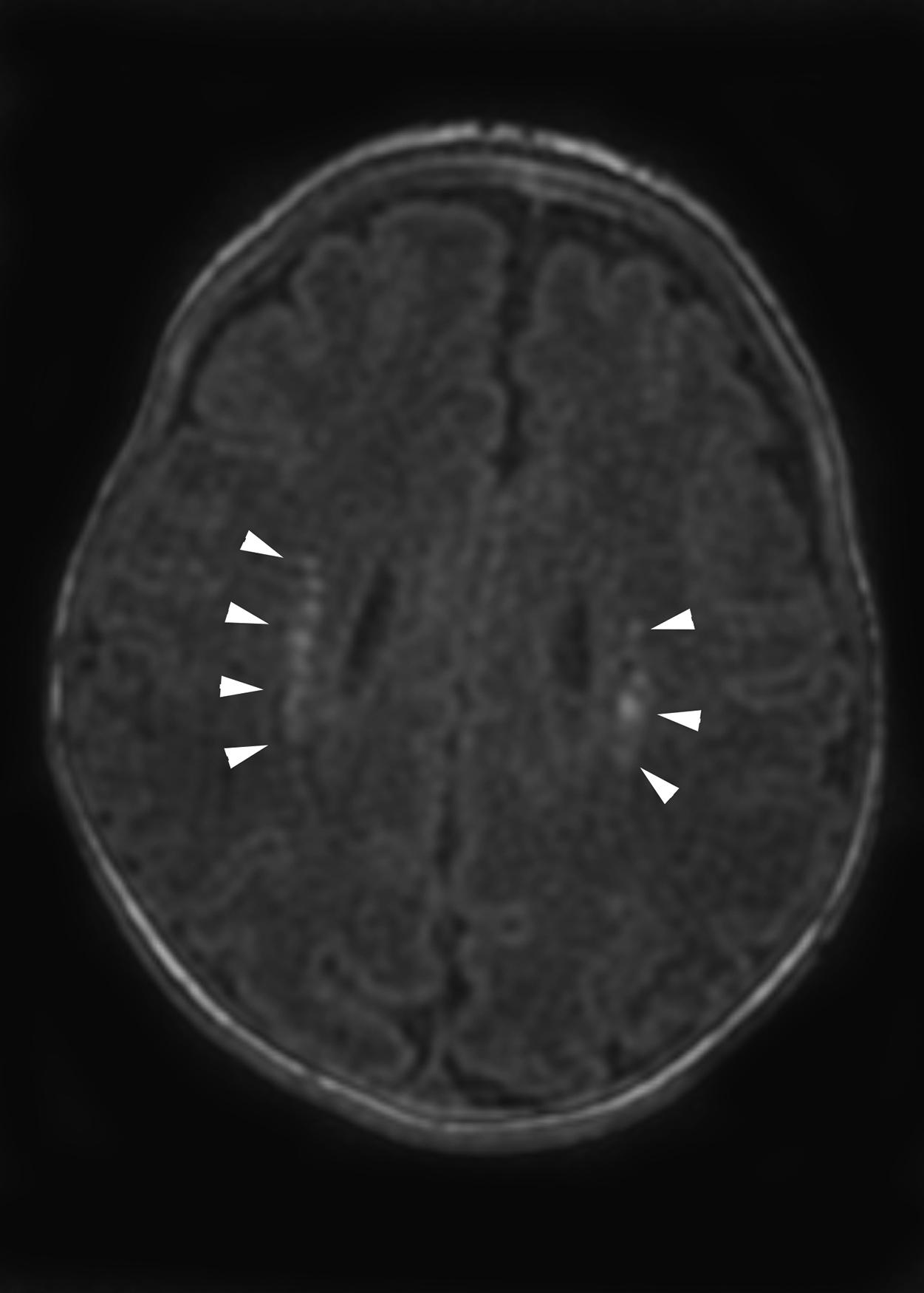
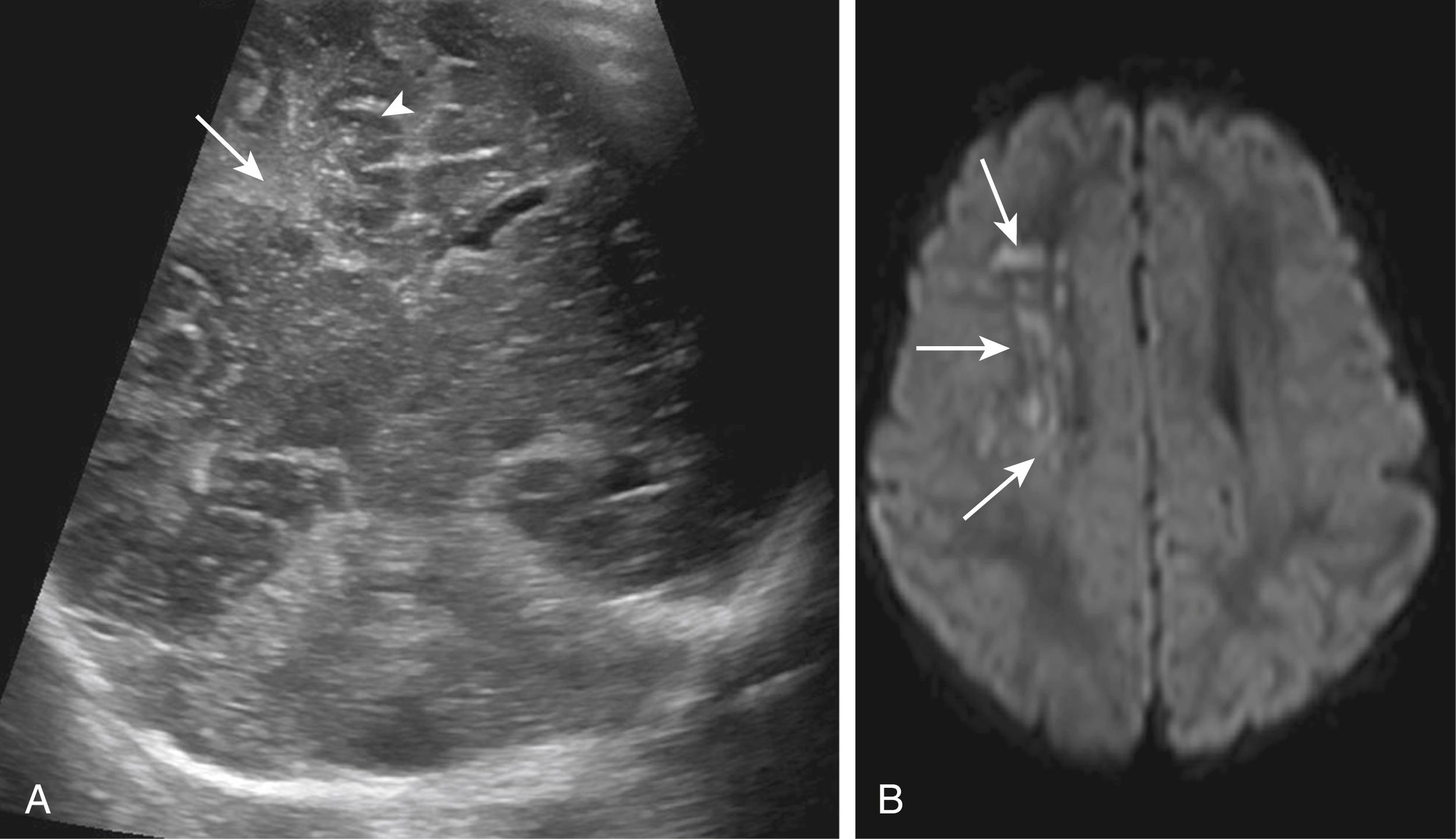
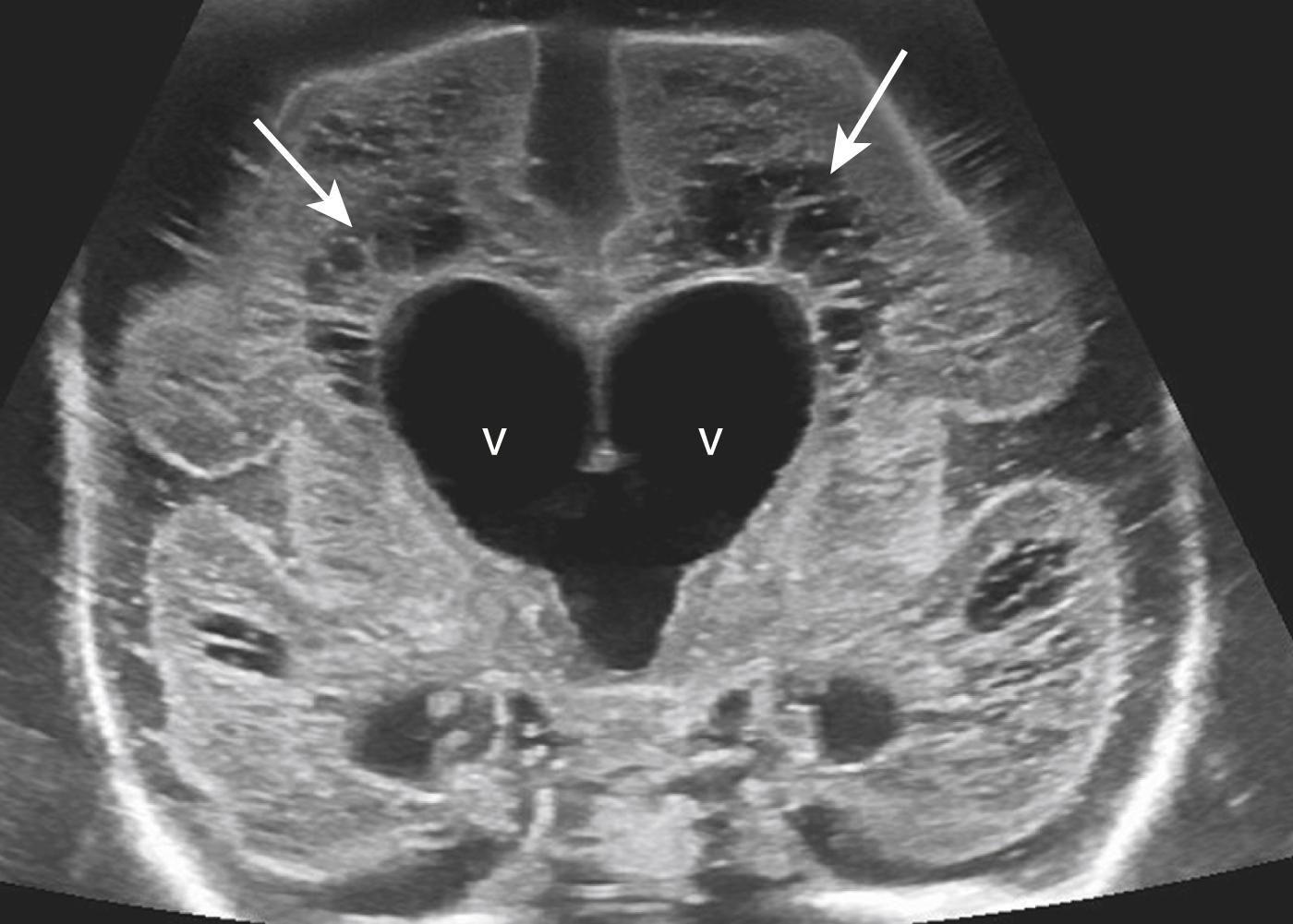
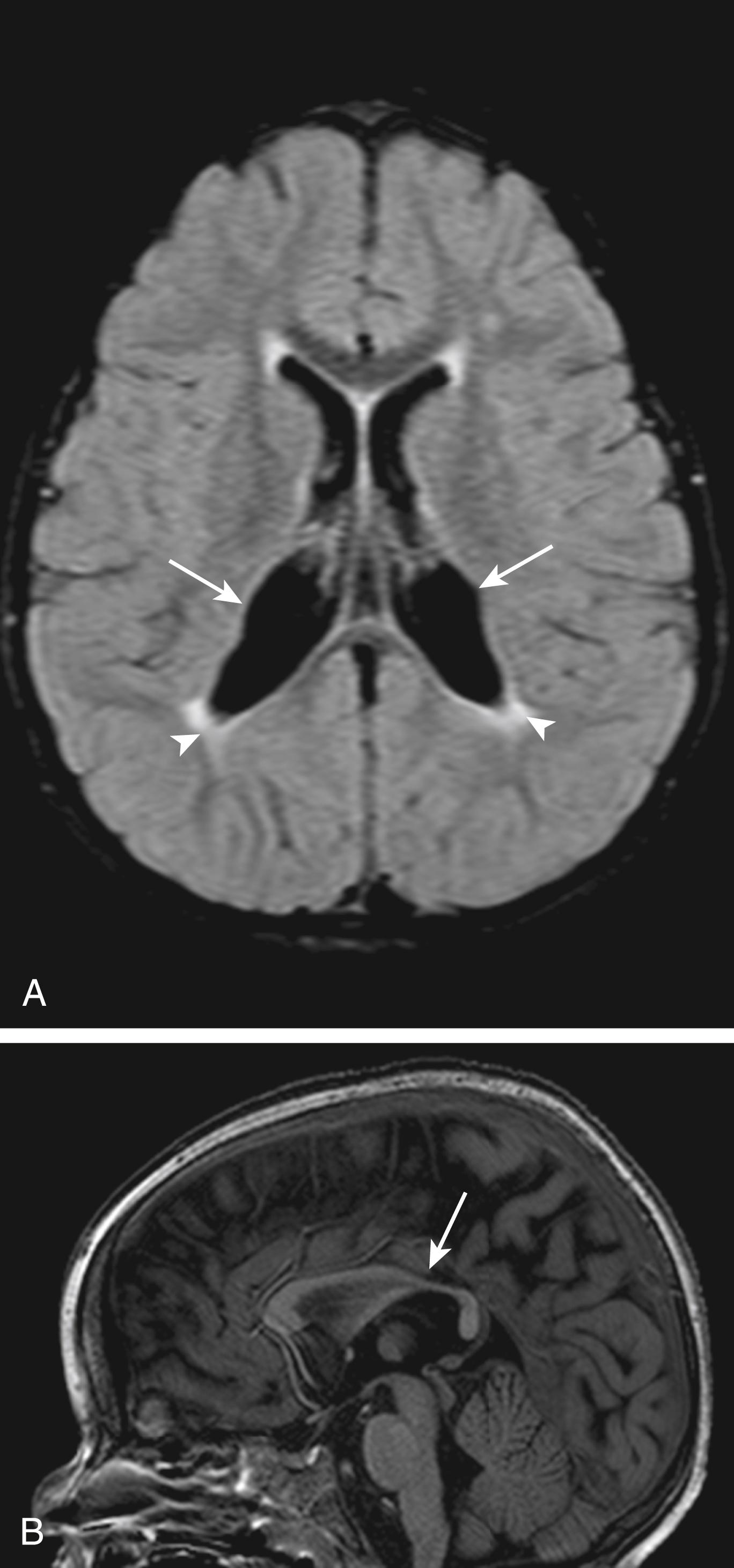
Partial asphyxia in term neonates and older children will affect the border zones (watershed zones) between the anterior and middle and/or middle and posterior circulations (see Fig. 8-31A and B ).
Profound prolonged asphyxia affects the most metabolic active areas of the brain, especially the basal ganglia and perirolandic regions, in both preterm and term neonates. Findings on MRI include symmetric increase T1 and T2 signal, especially along the posterior lentiform nuclei (putamen and globus pallidi) and the ventrolateral thalami. Diffusion restriction is often present if the patient is imaged after 24 h and prior to 10–14 days after the insult. In term neonates (above 36 weeks of gestation), another early finding of profound hypoxic ischemic insult includes absent visualization of the T1 hyperintense signal of the myelinated posterior limb of the internal capsule ( Fig. 8-26A and B ). The recent use of hypothermia to treat neonates with hypoxic ischemic insult has led to a decreased number of positive MRI cases and, when positive, the resultant imaging findings may be delayed. A mixed pattern involving both the basal ganglia and white matter can also be present. Head ultrasound may identify early signs of hypoxic ischemic insult, such as accentuated gray–white matter differentiation, slit-like ventricles secondary to edema, and blurring of interhemispheric fissure ( Fig. 8-27 ). Chronic changes of profound hypoxic ischemic insult include signal abnormality and volume loss of the posterior lentiform nuclei and ventrolateral thalami ( Fig. 8-28 ) with or without associated white matter volume loss.
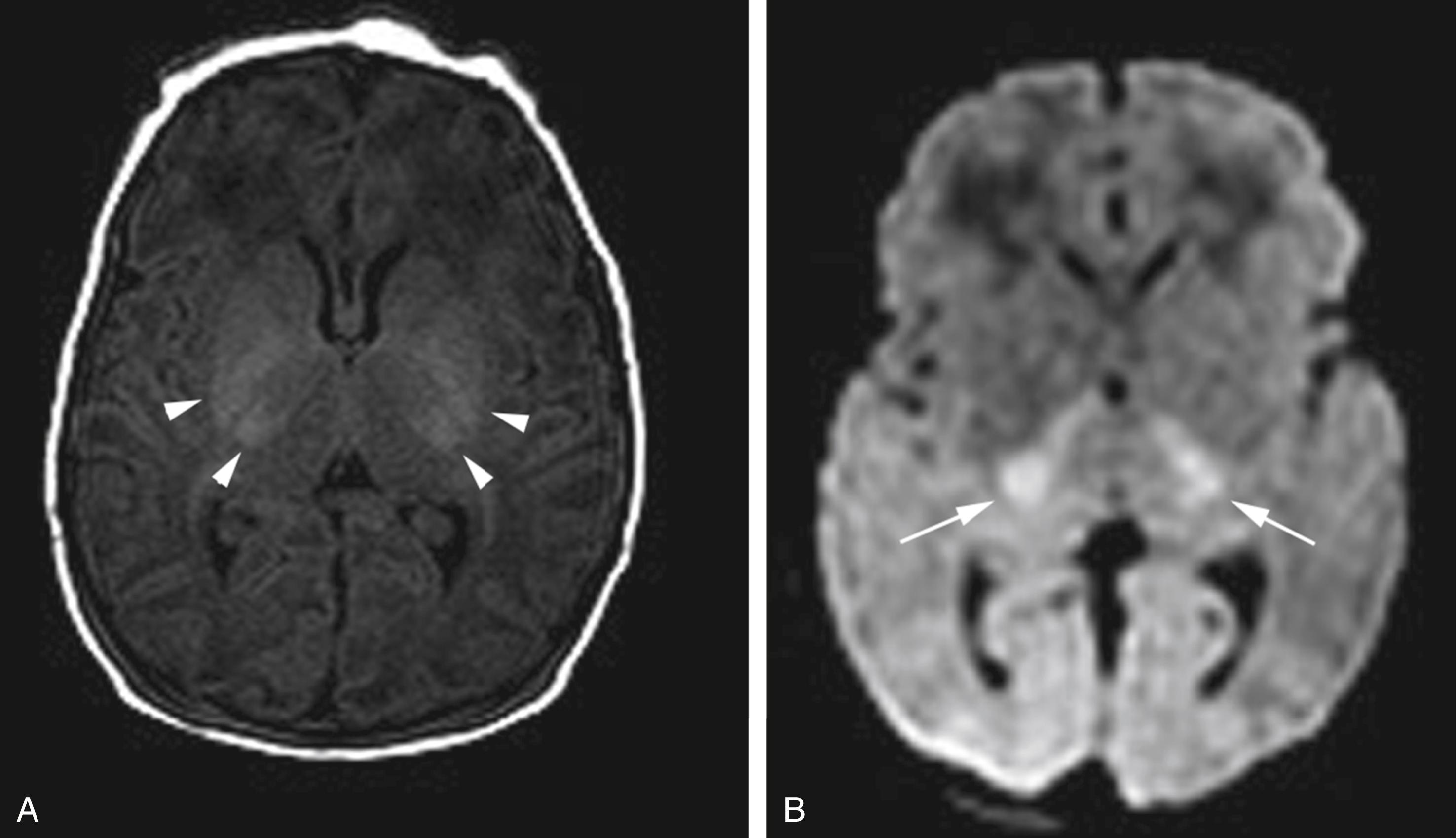
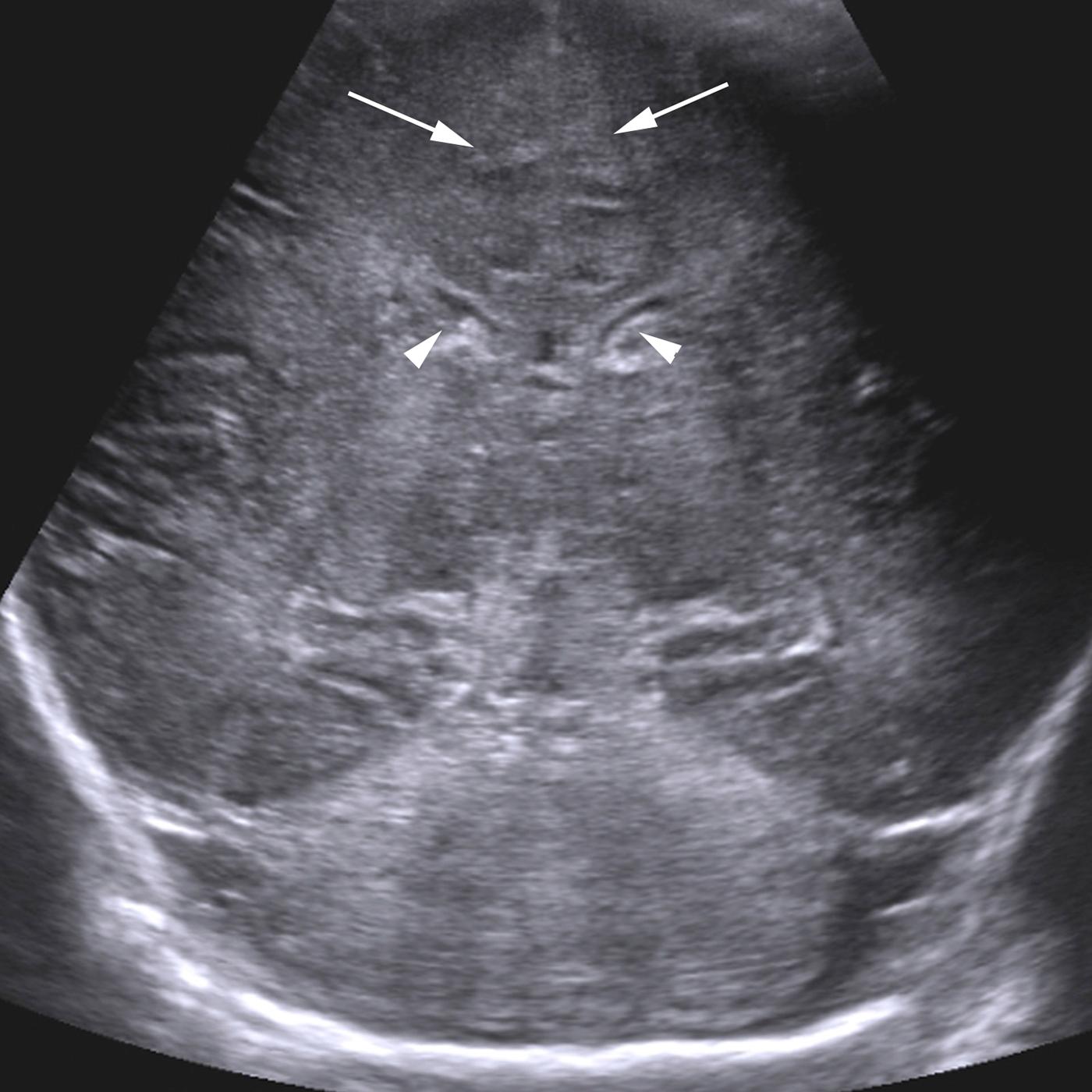
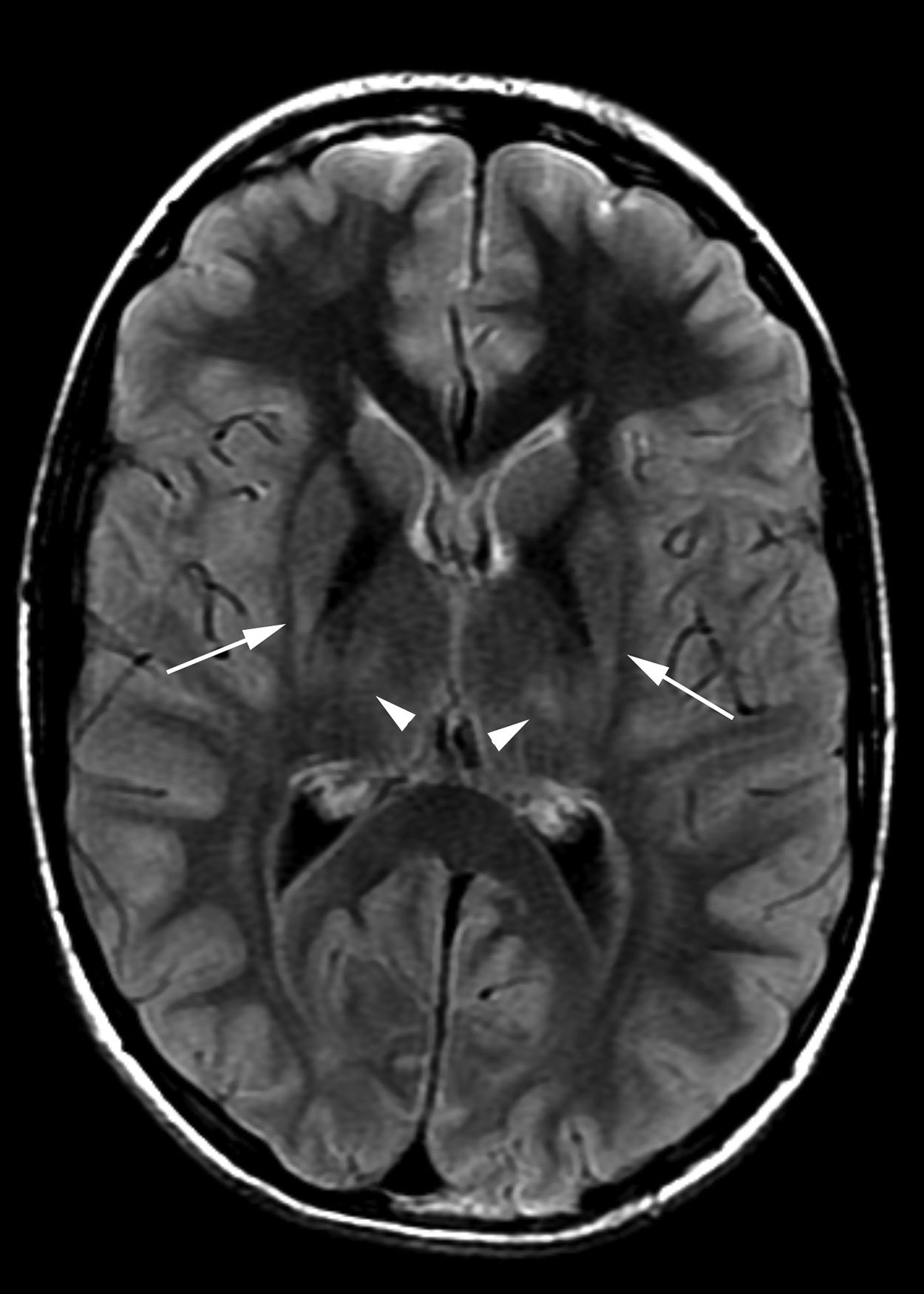
Imaging mimickers of hypoxic ischemic insult in encephalopathic neonates include neonatal hypoglycemia and metabolic diseases such as molybdenum cofactor deficiency ( Fig. 8-29A and B ), pyruvate dehydrogenase deficiency, nonketotic hyperglycinemia (will have elevated glycine peak 3.55 ppm), urea cycle disorders, and aminoacidurias. Neonatal hypoglycemia presents with diffusion restriction along the posterior parieto-occipital regions and can be confirmed clinically with glucose levels ( Fig. 8-29A ). Metabolic diseases mimicking hypoxic ischemic insult tend to present after a week or more of life, different from perinatal hypoxic ischemic insult, which usually presents during the first 24 h of life.
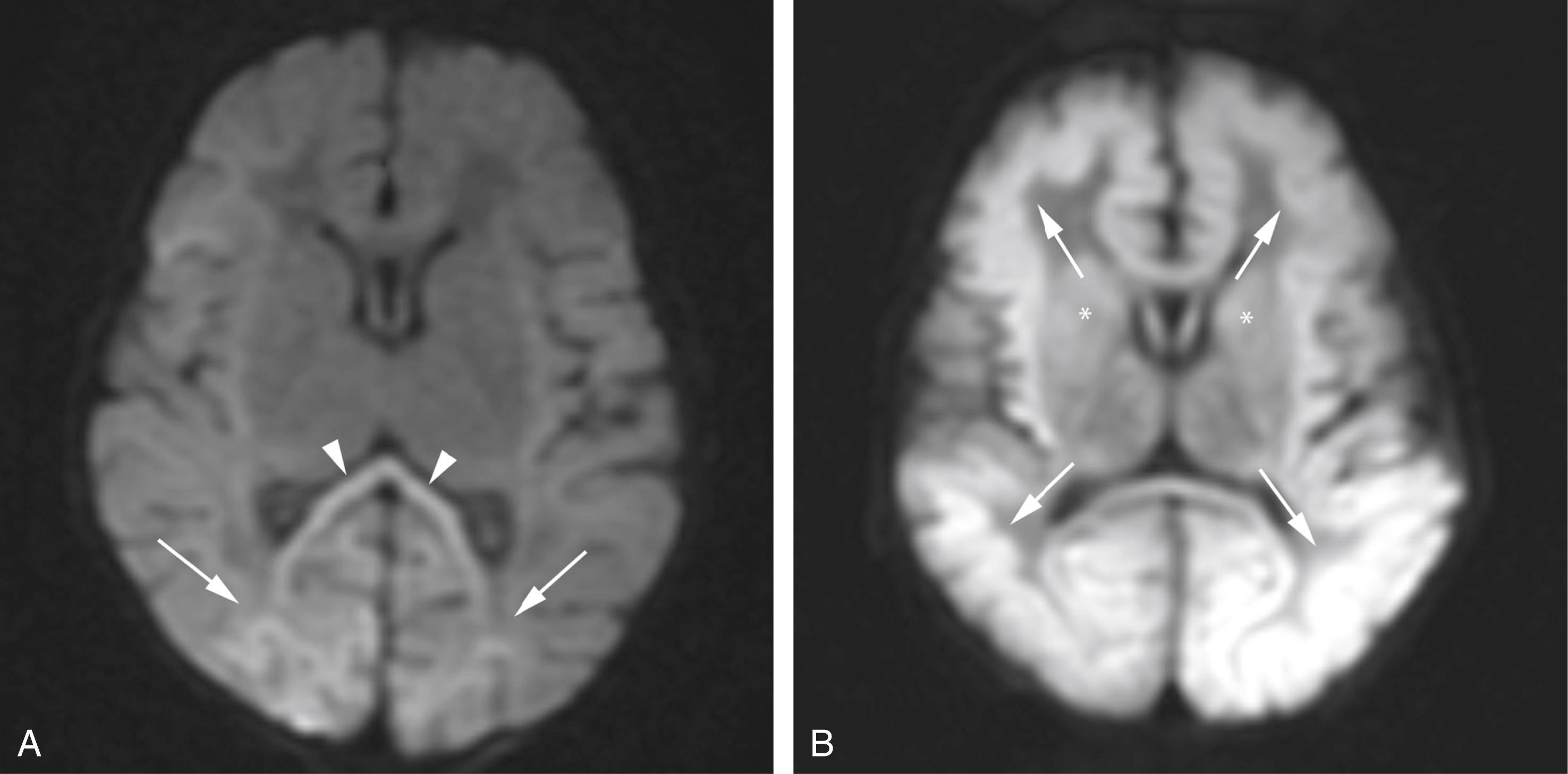
Neurodevelopmental abnormalities are the result of in utero disruption in central nervous system (CNS) formation. Causes include genetic, environmental, infectious, vascular, or metabolic etiologies. Classification can be made based on the stage of developmental insult ( Table 8-4 ) including abnormalities of dorsal induction, ventral induction, and cortical development. Malformations of cortical development (MCDs) can be categorized as disorders of cell proliferation and apoptosis; cell migration; and postmigrational neuronal development. The type of developmental lesion often reflects the timing of the in utero disturbance. Multiple distinct developmental abnormalities may be present simultaneously.
| Abnormality | Mechanism (Abnormality of) | Description | Imaging Findings |
|---|---|---|---|
| Chiari type 2 | Dorsal induction and complex hindbrain malformation | Small posterior fossa with inferior displacement of cerebellum, fourth ventricle, and brainstem into cervical canal; associated with myelomeningocele | Colpocephaly |
| Fenestrated falx | |||
| Large massa intermedia | |||
| Tectal beaking | |||
| Cervicomedullary kink | |||
| Hydrocephalus | |||
| Holoprosencephaly | Ventral induction | Failure in cleavage of brain into two cerebral hemispheres | Alobar type: |
| Single ventricle Fused thalami | |||
| Absent corpus callosum and falx | |||
| Dandy–Walker malformation | Defect in rhombencephalon formation and/or abnormal fenestration of foramens of Magendie and Luschka | Complete or partial agenesis of the cerebellar vermis in conjunction with an enlarged retrocerebellar CSF spaces and/or cyst | Posterior fossa is enlarged (elevated torcula) |
| May be an isolated posterior fossa anomaly or present with multiple associated supratentorial abnormalities | |||
| Molar tooth malformation | Neuronal progenitor cell Ciliary dysfunction (ciliopathy) | Absent decussation of superior cerebellar peduncles giving the appearance of a molar tooth on axial plane | Deep interpeduncular fossa and marked vermian hypoplasia May have associated encephalocele, kidney, eye, and limb abnormalities Clinical presentation with cognitive deficits and intellectual disabilities |
| Rhombencephalosynapsis | Defect in rhombencephalon formation of unknown etiology | Complete or partial cerebellar vermian agenesis with fusion of the cerebellar hemispheres | Fusion of cerebellar hemispheres with midline continuation of cerebellar folia Posterior convex margins of the cerebellum on axial plane Absent primary fissure and rounded fastigial point on sagittal plane. Common association with congenital hydrocephalus due to aqueduct stenosis |
| Microlissencephaly | Neuronal proliferation and cell apoptosis | Arrest neuronal proliferation resulting in decreased number of neurons | Microcephaly and simplified pattern of gyration |
| Megalencephaly | Neuronal proliferation and cell apoptosis | Increase neuronal proliferation arrests apoptosis resulting in overgrow of cerebral parenchyma | Enlarged and dysplastic cerebral hemisphere (hemimegaloencephaly) with enlarged ipsilateral ventricle Enlarged dysplastic bilateral cerebral hemispheres (dysplastic megalencephaly) Sporadic or part of megalencephaly syndromes Intractable epilepsy |
| Gray matter heterotopia | Neuronal migration | Arrested migration of neurons, resulting in heterotopic areas of gray matter within the subependymal regions or white matter | Sporadic or part of megalencephaly syndromes Intractable epilepsy |
| Nodular or laminar appearance | |||
| Isointense to gray matter | |||
| Other migration abnormalities, hippocampal, and callosal anomalies may be seen | |||
| Lissencephaly | Neuronal migration | Arrest neuronal migration causing failure of development of gyri and sulci | Smooth cortical surface (“Figure eight” appearance of the brain) |
| Cortical thickening | |||
| Other migration abnormalities are common | |||
| Part of many genetic disorders | |||
| Cobblestone malformation | Neuronal migration | Overmigration of neurons with lack of normal laminar organization of the cortex | Smooth external cortical surface |
| Pebbled appearance of the cortex | |||
| Hypoplastic and kinked brainstem | |||
| Often associated with aqueductal stenosis, eye abnormalities, and congenital muscular dystrophies | |||
| Cortical dysplasia | Neuronal proliferation (FCD type II and glioneuronal tumors) postmigration (FCD type I and III) | Abnormality of neuronal proliferation and/or postmigration leading to dysplastic cortex | Imaging commonly normal |
| Type II FCD may show focal cortical thickening, blurring of gray–white matter, and triangular-shaped white matter signal changes | |||
| May have associated glioneuronal tumor (dual pathology) | |||
| Polymicrogyria | Late migration/postmigration | Cortex showing multiple small gyri and sulci | Predilection to perisylvian region |
| Small gyri may appear fused, given appearance similar to pachygyria | |||
| Encephaloclastic or genetic syndromes | |||
| Schizencephaly | Postmigration | Gray matter–lined cleft extending from lateral ventricle to cerebral surface | Absent septum pellucidum—common |
| Other migration abnormalities, hippocampal, and callosal anomalies may be seen Results from encephaloclastic insult |
|||
| Dysgenesis of the corpus callosum | Commissure formation | Complete or partial absence of the corpus callosum | Parallel lateral ventricles |
| Bundles of Probst | |||
| Colpocephaly | |||
| High-riding third ventricle | |||
| Vein of Galen malformation | Disorder of vascular differentiation | Arteriovenous fistula to embryonic precursor of the vein of Galen resulting in large posterior midline venous varix | May cause brain ischemia or infarct from “steal phenomenon” |
| May present with hydrocephalus | |||
| Congestive heart failure may be the first identified symptom | |||
| Hydranencephaly | Encephaloclastic | Destruction of the cerebrum secondary to insult affecting the bilateral internal carotid arteries | Cerebrum replaced by CSF |
| Falx is present | |||
| Thalami separated | |||
| Normal or enlarged head circumference | |||
| Porencephaly | Encephaloclastic | Cyst formation from injury to brain parenchyma during first or second trimester | Thin-walled CSF cyst |
| May communicate with lateral ventricle (no cortical lining) | |||
| No septations |
Neurodevelopmental abnormalities can also result from destruction of already formed structures (encephaloclastic insult). Most commonly they are related to a vascular injury that can be the result of a number of underlying causes. The most commonly encountered sequelae of encephaloclastic insults are porencephaly, encephalomalacia, and hydranencephaly. Encephaloclastic insults can also result in MCDs such as schizencephaly and polymicrogyria if occurred during the late migration/postmigration phases of brain development.
Before the end of the second trimester, parenchymal injury does not result in glial scar formation. During this early time period, focal injury results in the development of a fluid-filled space called a porencephalic cyst . On imaging, this appears as a thin-walled, CSF-containing cyst that may communicate with the ventricles ( Fig. 8-30 ). During the third trimester and neonatal period, parenchymal injury incites some glial scar formation, resulting in softening of the brain parenchyma (encephalomalacia) and tissue loss with or without reactive gliosis. Encephalomalacia appears as areas of high T2-weighted signal frequently with associated septations in the region of injury ( Fig. 8-31A and B ).
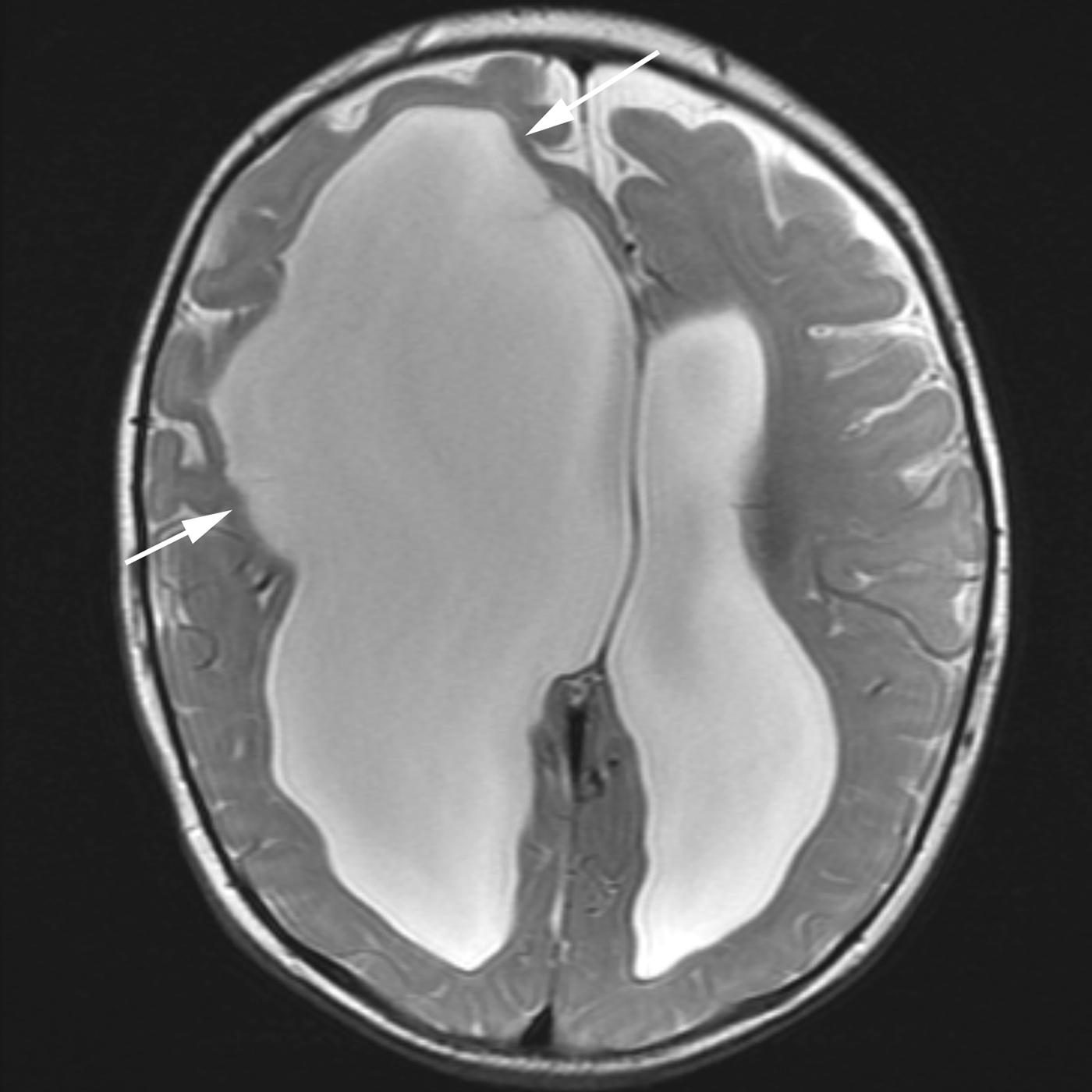
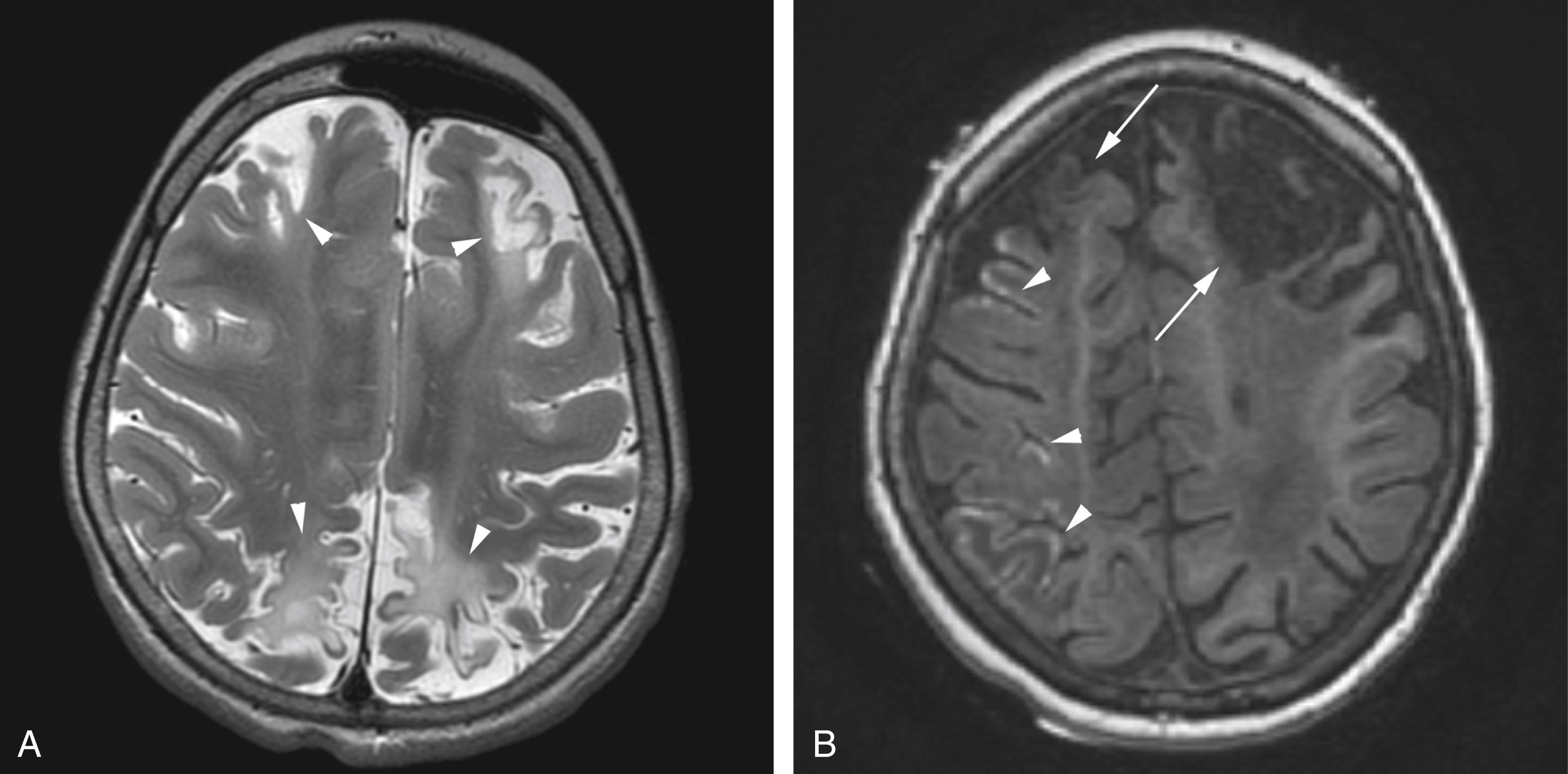
Hydranencephaly is the result of significant injury to the majority of the cerebral hemispheres secondary to an in utero destructive process. The cause is thought to be vascular in origin with involvement of both internal carotid arteries. Infectious vasculitis has been identified as a potential cause. The supratentorial compartment is almost entirely filled with CSF. A few areas of preserved parenchyma may be seen along the convexities and thalami ( Fig. 8-32A–C ). The brainstem is usually hypoplastic due to decreased descending white matter tracts, and the cerebellum is typically intact. These structures remain because they are supplied by the vertebrobasilar arterial system. The presence of the falx cerebri and the separation of the thalami seen in hydranencephaly (see Fig. 8-32B ) help to differentiate this disorder from severe (alobar) holoprosencephaly. It is sometimes very difficult and impossible to differentiate hydranencephaly from severe hydrocephalus ( Fig. 8-33 ).
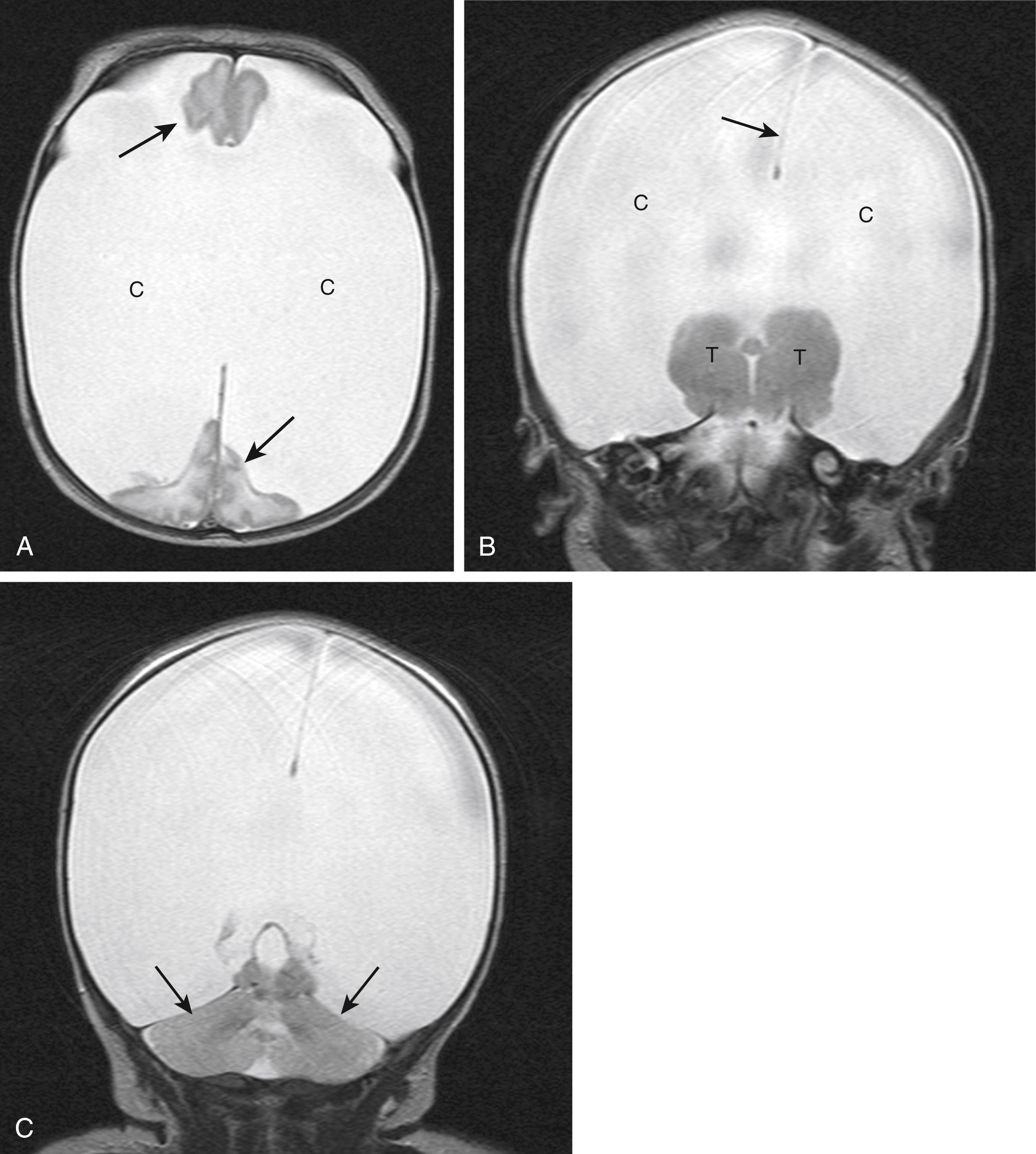
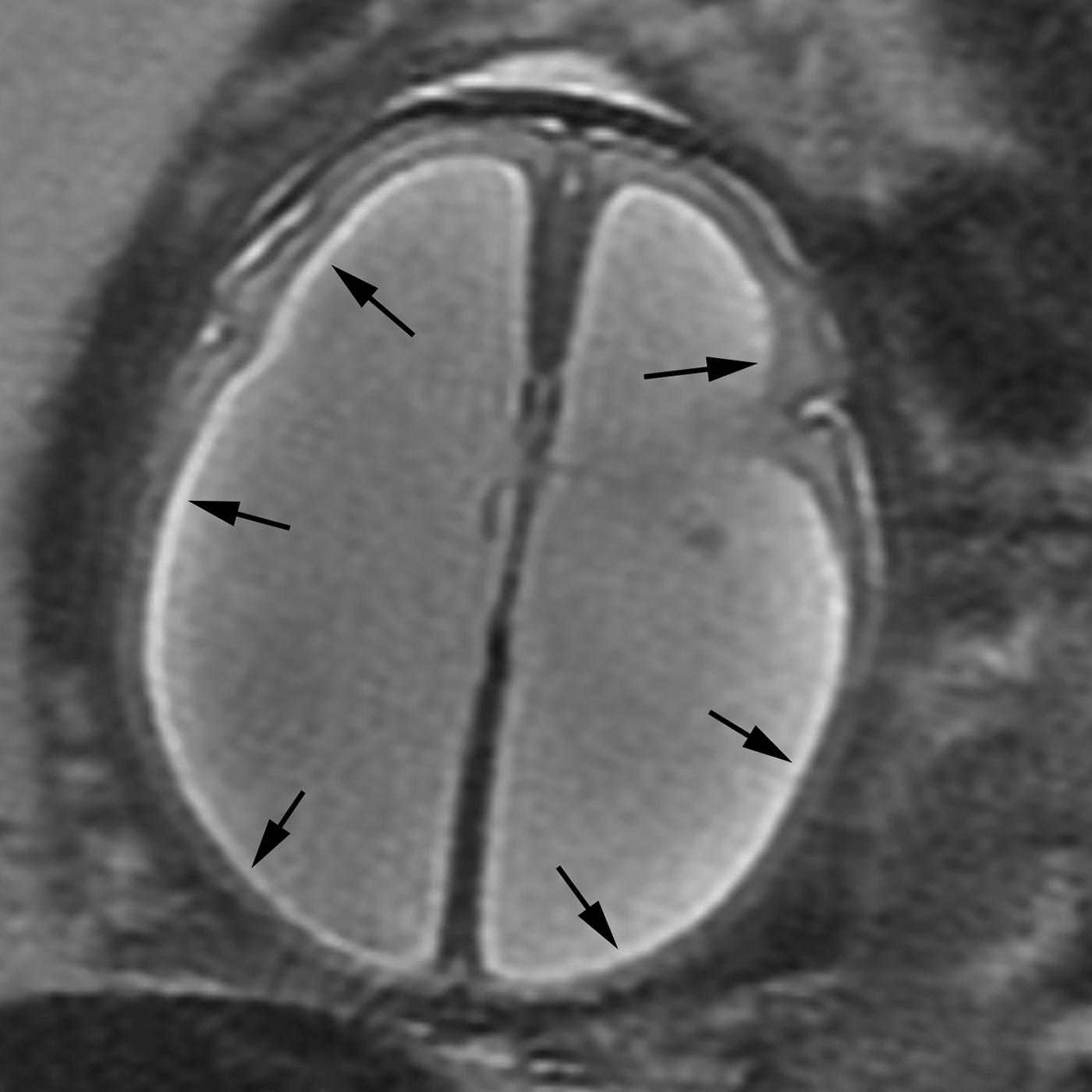
Chiari type 1 is the presence of an abnormal inferior location of the cerebellar tonsils, at least 5 mm below the foramen magnum ( Fig. 8-34 ). The cerebellar tonsils are typically elongated in morphology rather than round, and there are different degrees of CSF effacement at the craniocervical junction. The medulla and fourth ventricle are commonly in normal positions although low position of the cervicomedullary junction may be seen in cases of complex Chiari 1 (also known as Chiari 1.5) which are often associated with a posteriorly tilted dens of C2 and sometimes with a hypoplastic clivus and basilar invagination. Complications of Chiari type 1 include hydrocephalus and hydromyelia (see Fig. 8-34 ). It may be suspected on CT when the foramen magnum appears “full” with soft tissue ( Fig. 8-35 ). It is best visualized on sagittal MR images. Phase-contrast CSF flow MR sequence may be used to show CSF space effacement and pistoning movement of the cerebellar tonsils. Chiari 1 may be acquired with increase intracranial pressure and may also resolve with child growth, therefore not always a true malformation.
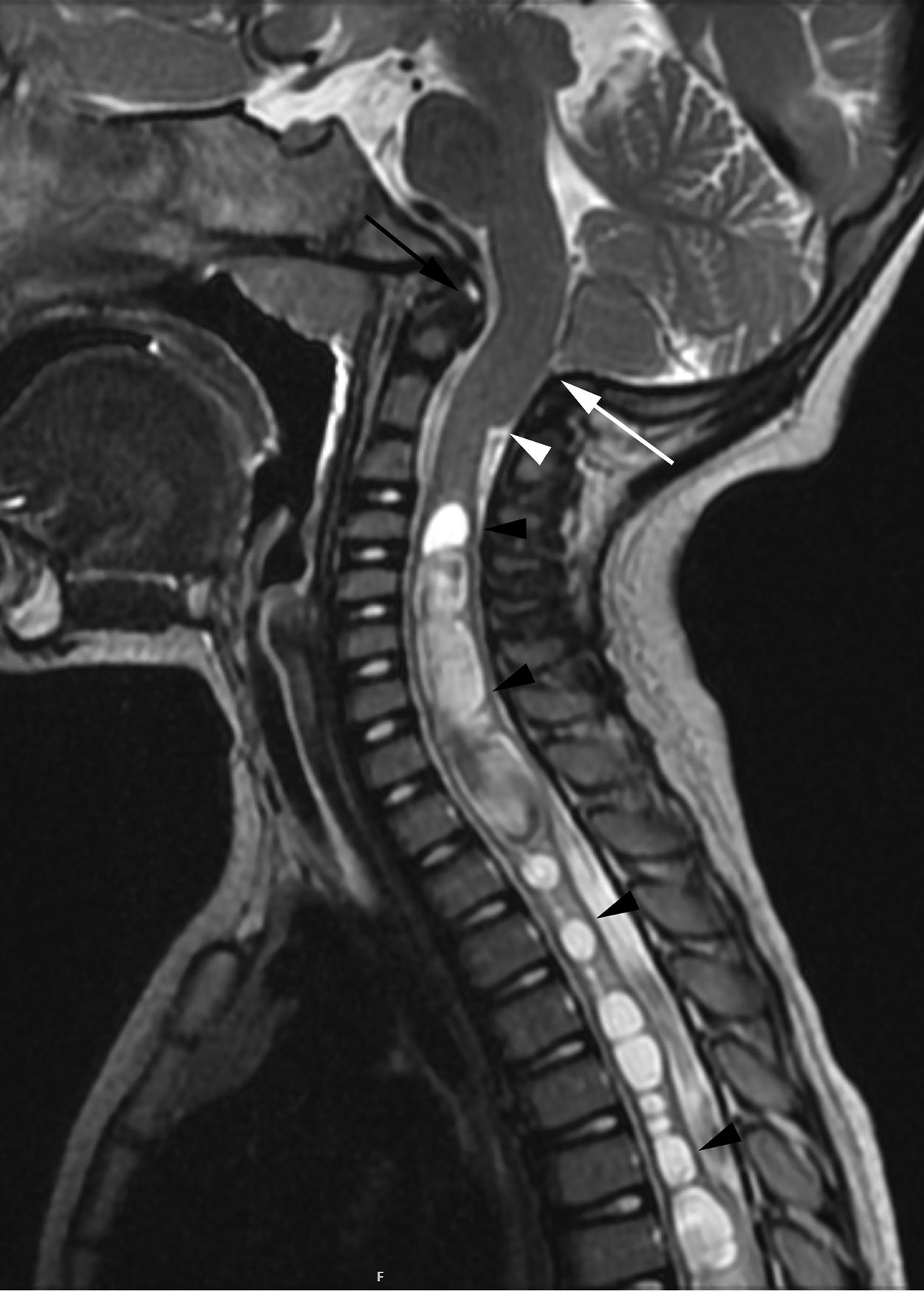
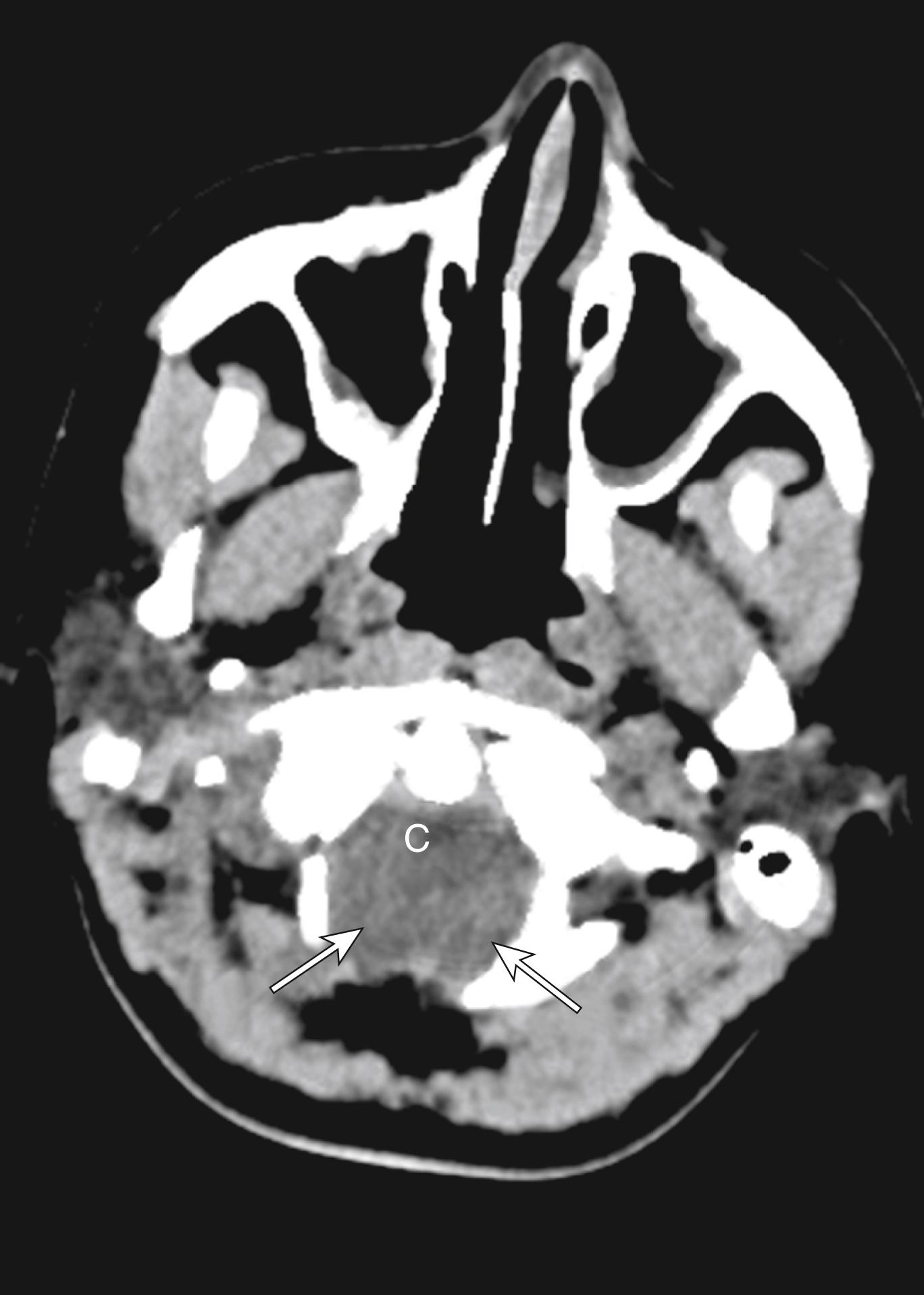
Chiari type 2 is a true malformation of hindbrain and is almost always associated with spinal myelomeningoceles. Conversely, almost all patients with myelomeningoceles have Chiari type 2 malformation. Patients with this abnormality have small posterior fossa and associated inferior displacement of the cerebellum, medulla, and fourth ventricle into the upper cervical canal ( Fig. 8-36 ). Associated imaging findings include a kinked appearance of the medulla, colpocephaly (disproportionate enlargement of the occipital horns of the lateral ventricles), fenestration of the falx associated with interdigitating gyri across the midline, enlargement of the massa intermedia, inferior pointing of the lateral ventricles, and tectal beaking (a pointed appearance of the quadrigeminal plate). Chiari type 2 malformations are usually associated with hydrocephalus, often diagnosed prenatally ( Fig. 8-37A and B ).
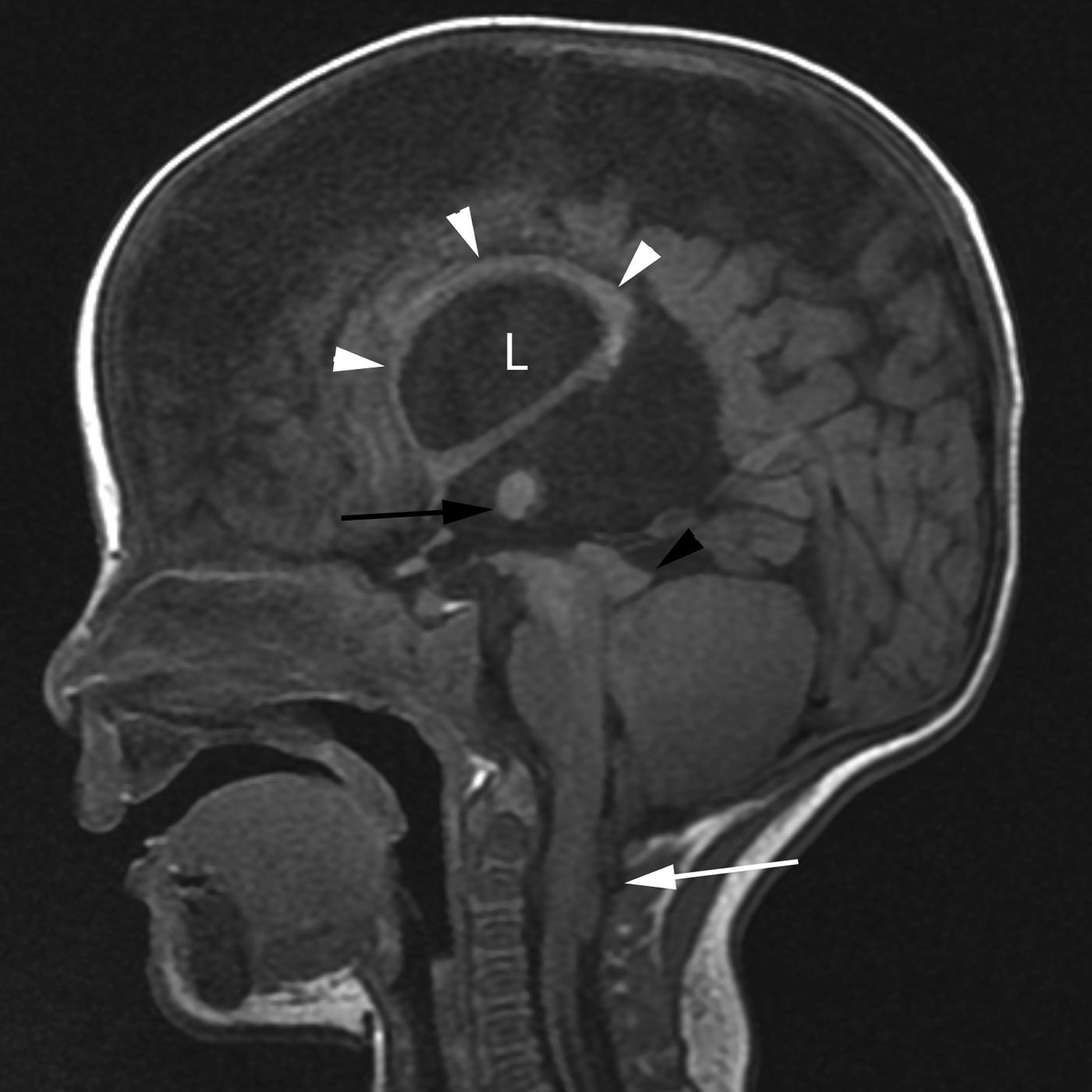
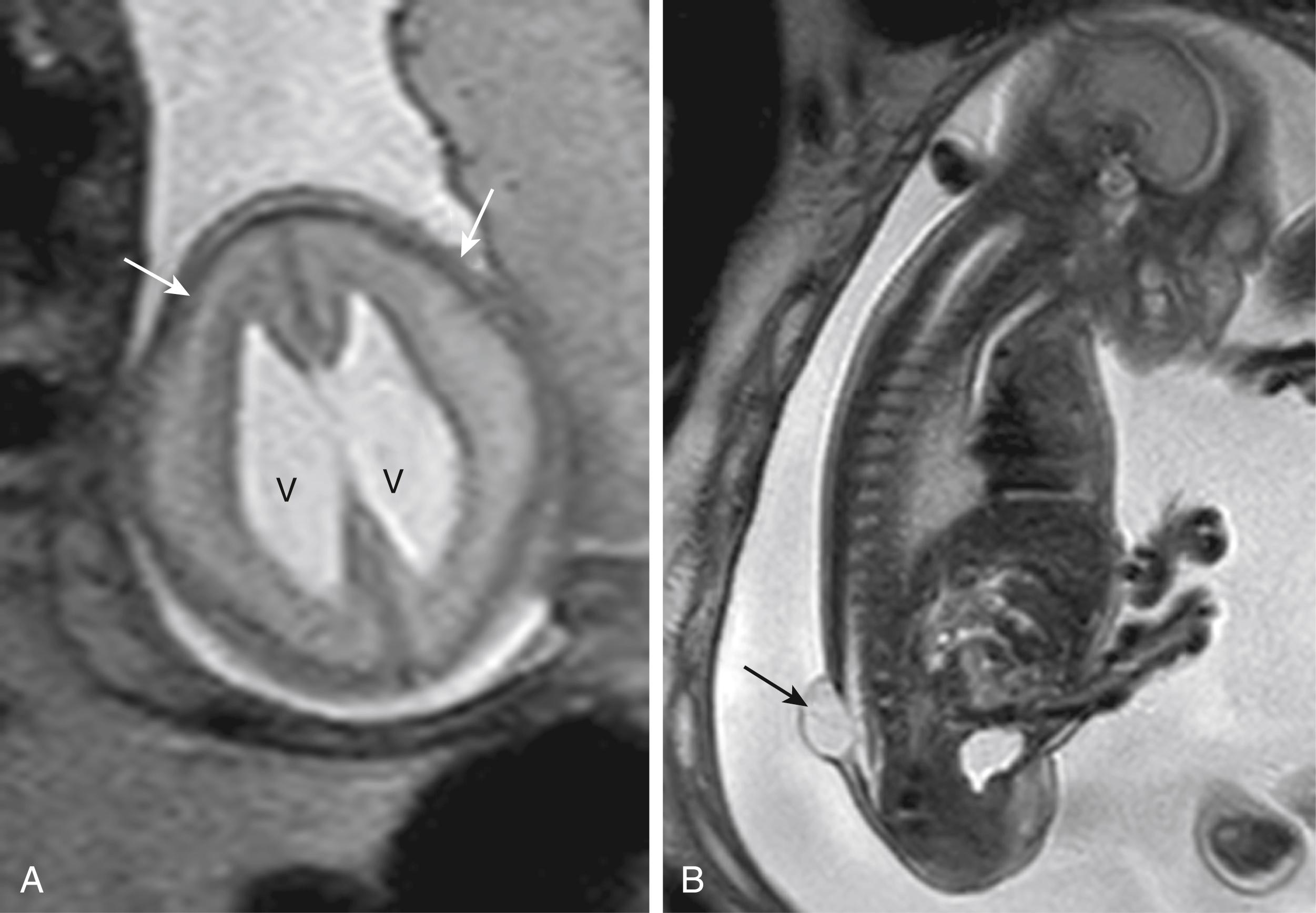
Prenatal correction of myelomeningocele can be performed in a subset of fetuses, following specific inclusion criteria. The aim is to decrease the degree of hindbrain herniation and the postnatal need of ventricular shunting, as well as to improve lower extremity function ( Fig. 8-38A and B ).
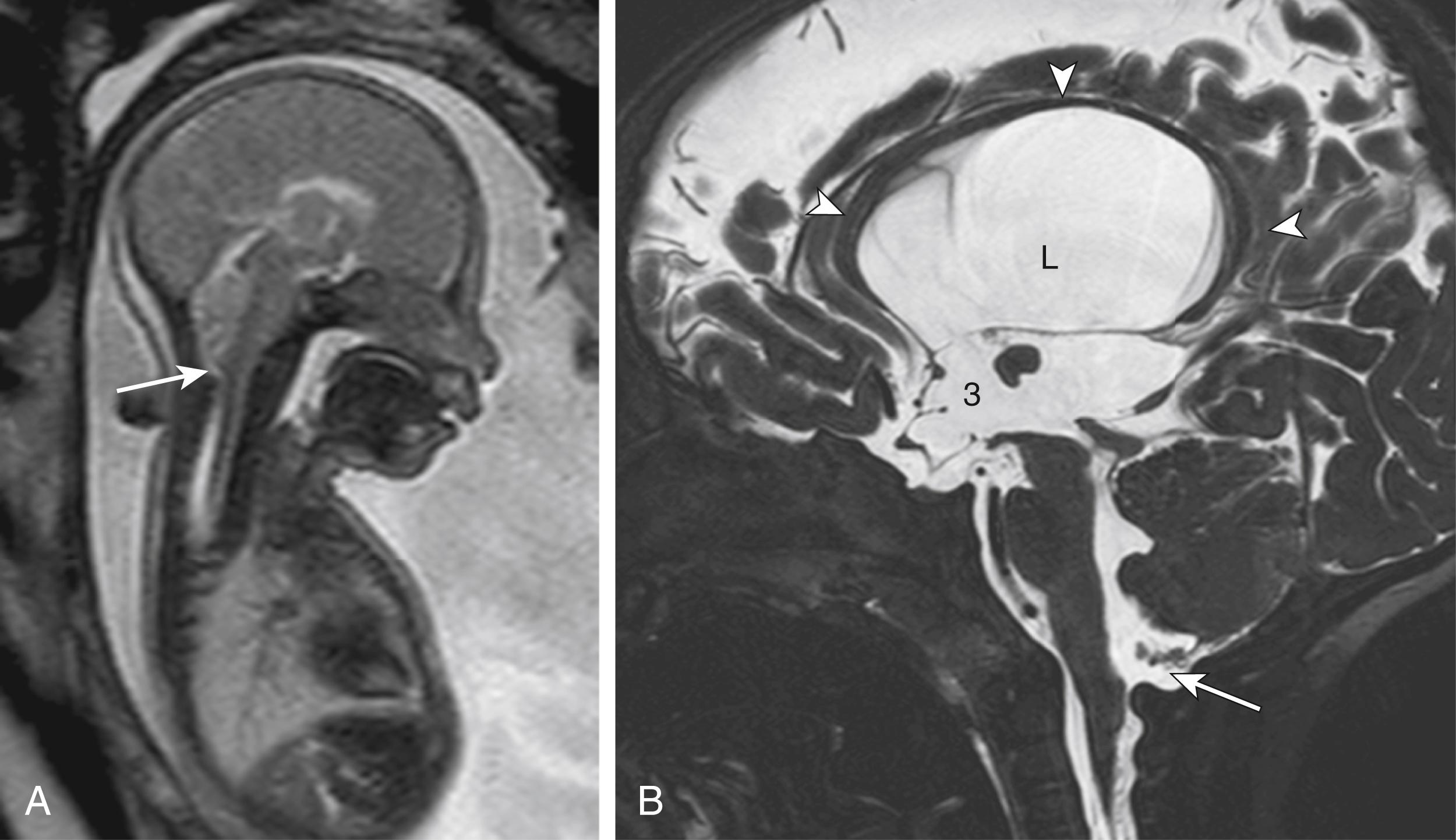
Chiari type 3 is very rare and includes an occipital encephalocele or upper cervical dysraphism instead of a lower spinal myelomeningocele.
Holoprosencephaly results from lack of complete cleavage of the brain into two hemispheres. Although there is a continuous spectrum of severity, holoprosencephaly is classically classified into one of three distinct groups: alobar, semilobar, or lobar. The severity of the brain abnormality is usually reflected in the severity of the associated midline facial abnormality.
Alobar holoprosencephaly ( Fig. 8-39A and B ) is the most severe form and is characterized by a monoventricle. The thalami are fused and there is no attempt at cleavage of the cerebral hemispheres. There is no falx cerebri or corpus callosum. There is a single anterior cerebral artery (azygous artery). These infants are commonly stillborn or have a very short life span.
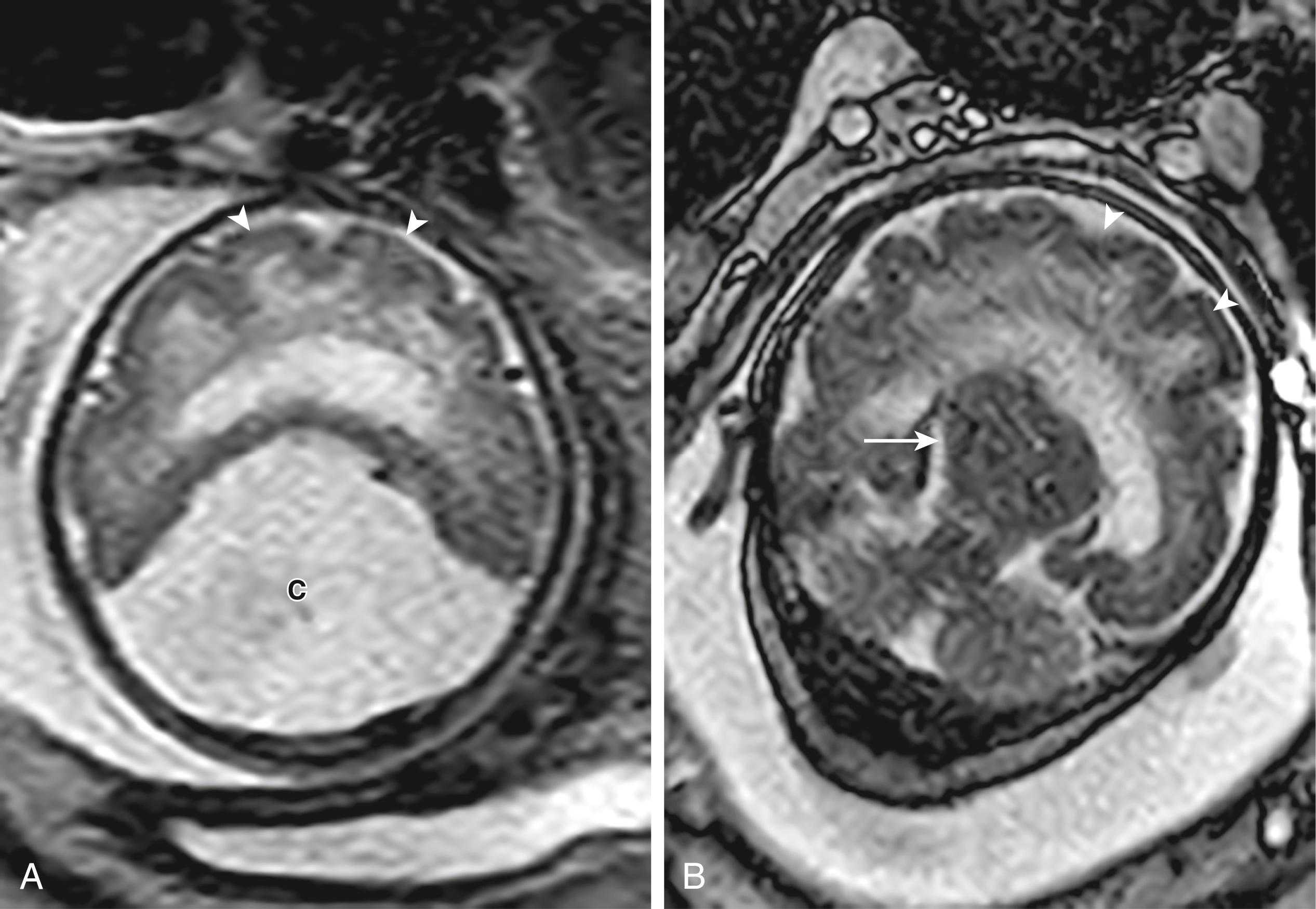
With the intermediate form, semilobar holoprosencephaly ( Fig. 8-40A and B ), the cerebral hemispheres are partially cleaved from each other posteriorly. The temporal horns of the lateral ventricles may be formed, but there is a single ventricle anteriorly. There is at least partial separation of the thalami. Midline structures, such as the falx and corpus callosum, may be present posteriorly but not anteriorly.
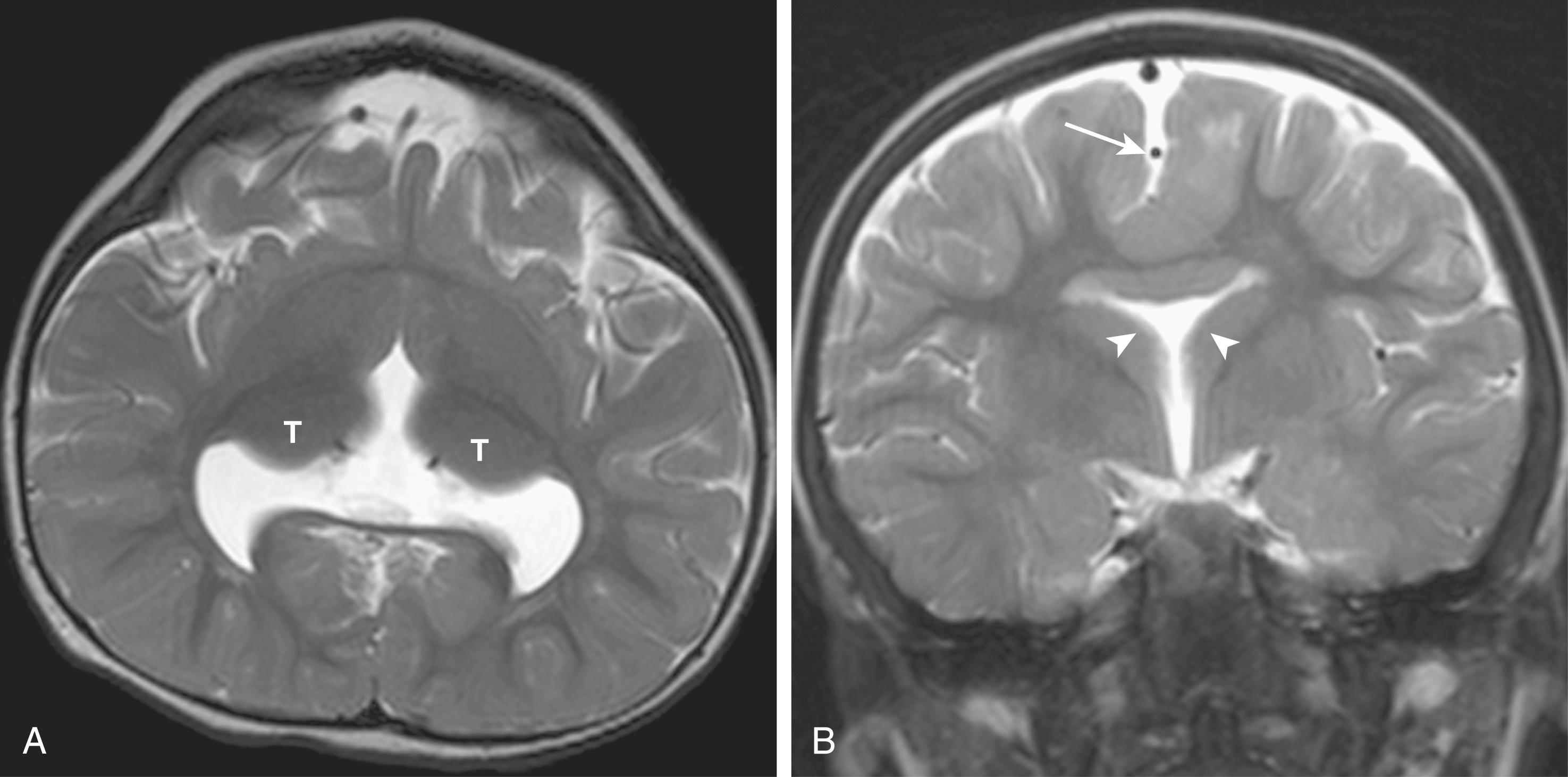
Lobar holoprosencephaly is a milder form in which the occipital and temporal horns are well formed, but there is failure of cleavage of the frontal lobes. The septum pellucidum is absent, and the corpus callosum may be absent or dysplastic.
A less severe form of holoprosencephaly is syntelencephaly or middle interhemispheric variant, and may be seen as fusion only of the midline posterior frontal lobes and/or parietal lobes ( Fig. 8-41 ). Different degrees of septum pellucidum and corpus callosum agenesis/dysgenesis can be present.
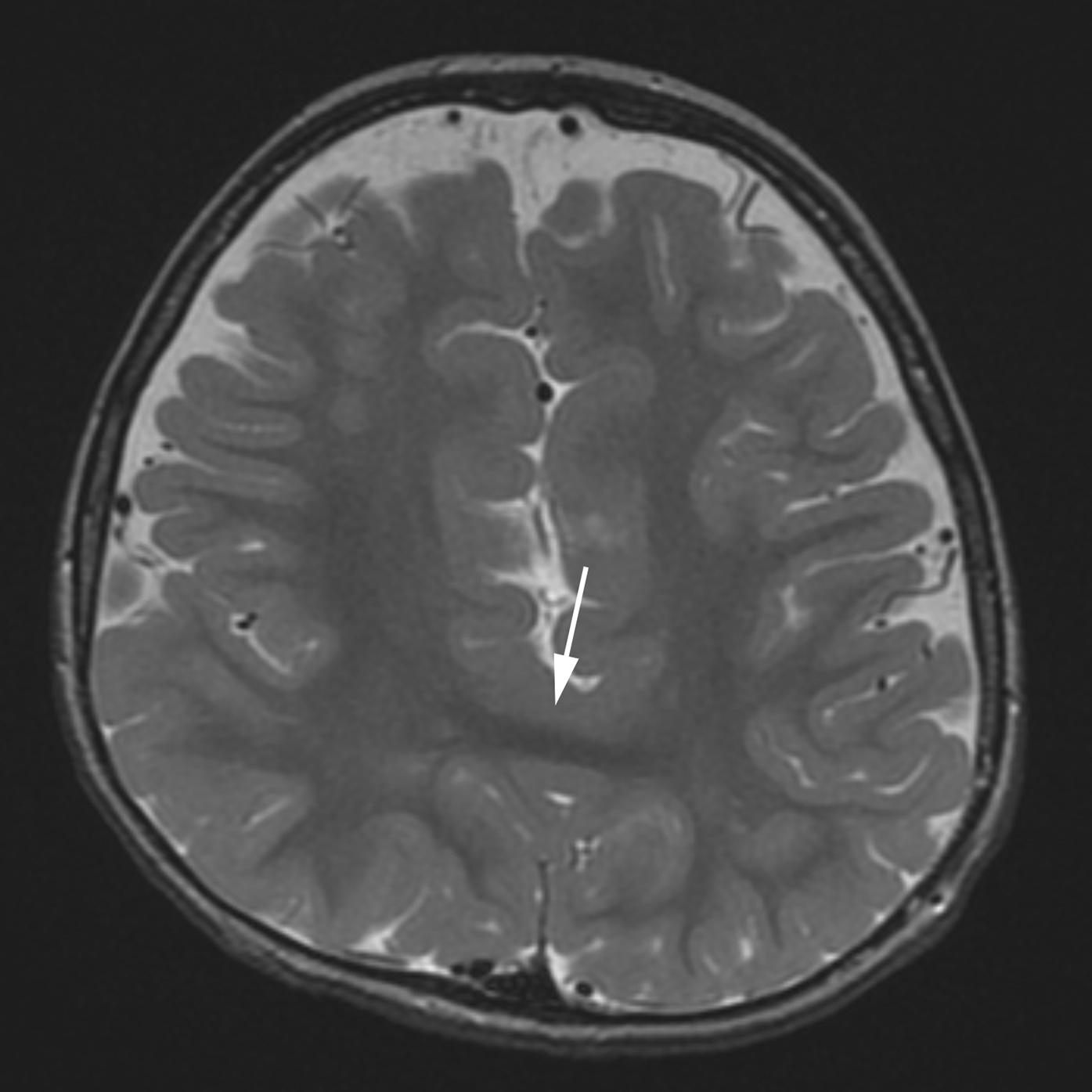
Another milder form of lobar holoprosencephaly is septopreoptic holoprosencephaly. In this variant, the midline fusion is limited to the septal and preoptic regions. The fornices are commonly thick or fused and the anterior commissure may be hypoplastic or absent.
Septo-optic dysplasia is another type of ventral induction malformation, analogous to mild holoprosencephaly. It was originally described as absence of the septum pellucidum and hypoplasia of the optic nerves (diagnosed most often by ophthalmological evaluation) ( Fig. 8-42A and B ). It was later discovered that there are often associated pituitary abnormalities and dysfunction (in approximately two thirds of patients). Currently, several authors believe that a combination of any two of the three findings is part of the disease spectrum. Pituitary abnormalities may include absent visualization of T1 bright posterior pituitary gland, ectopic posterior pituitary gland ( Fig. 8-43 ), interrupted or hypoplastic pituitary stalk, or hormonal abnormalities with no obvious imaging finding. Septo-optic dysplasia may also present with schizencephaly, heterotopia, and incomplete hippocampi inversion. In septo-optic dysplasia, the frontal horns of the lateral ventricles have a squared appearance on coronal MR images. The septum pellucidum may also be completely or partially absent in cases of congenital hydrocephalus due to increase ventricular pressure (see Figs. 8-53A and 8-121A ), an important differential diagnosis, as not all cases of absent septum pellucidum are related to septo-optic dysplasia.
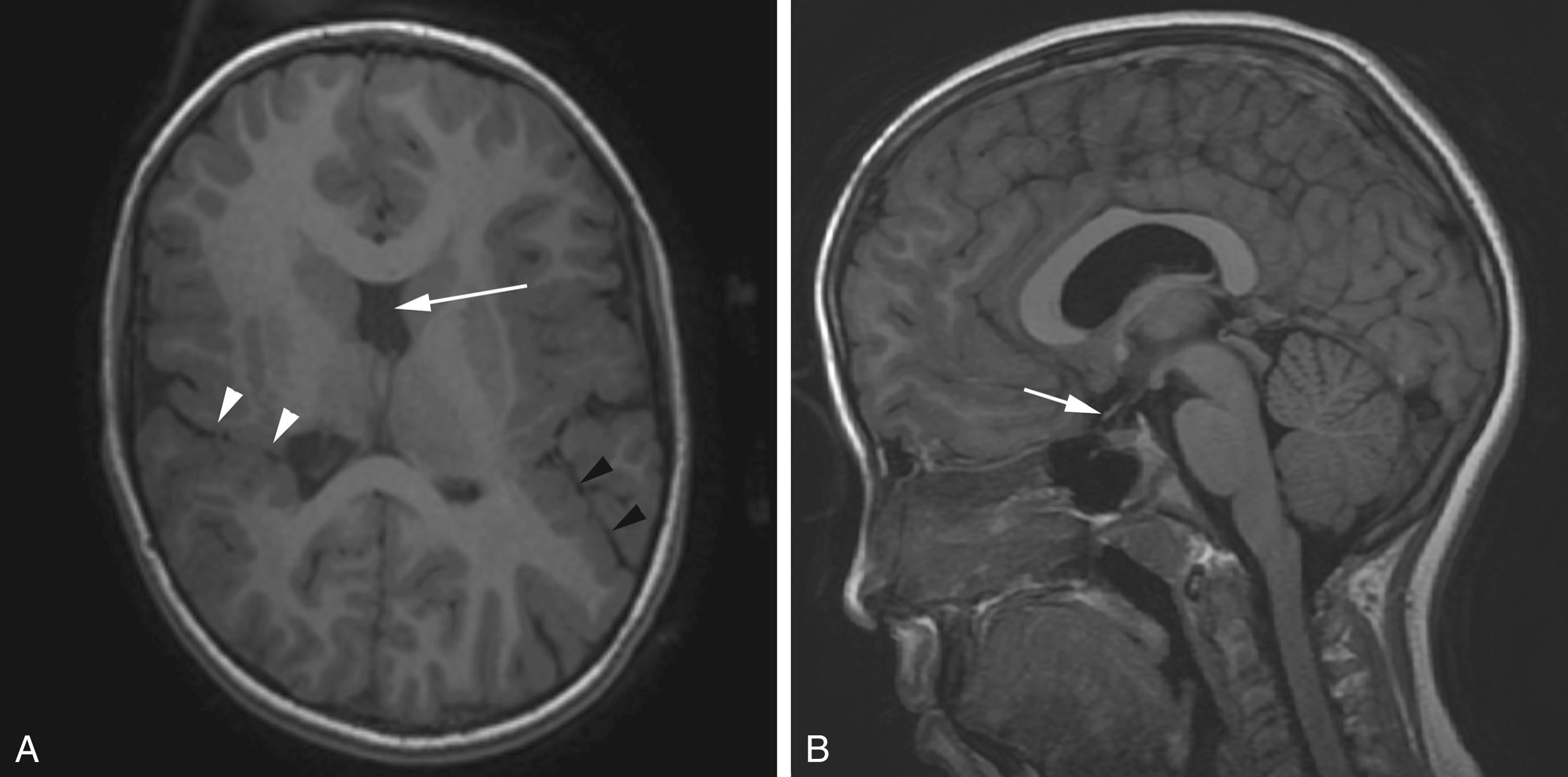
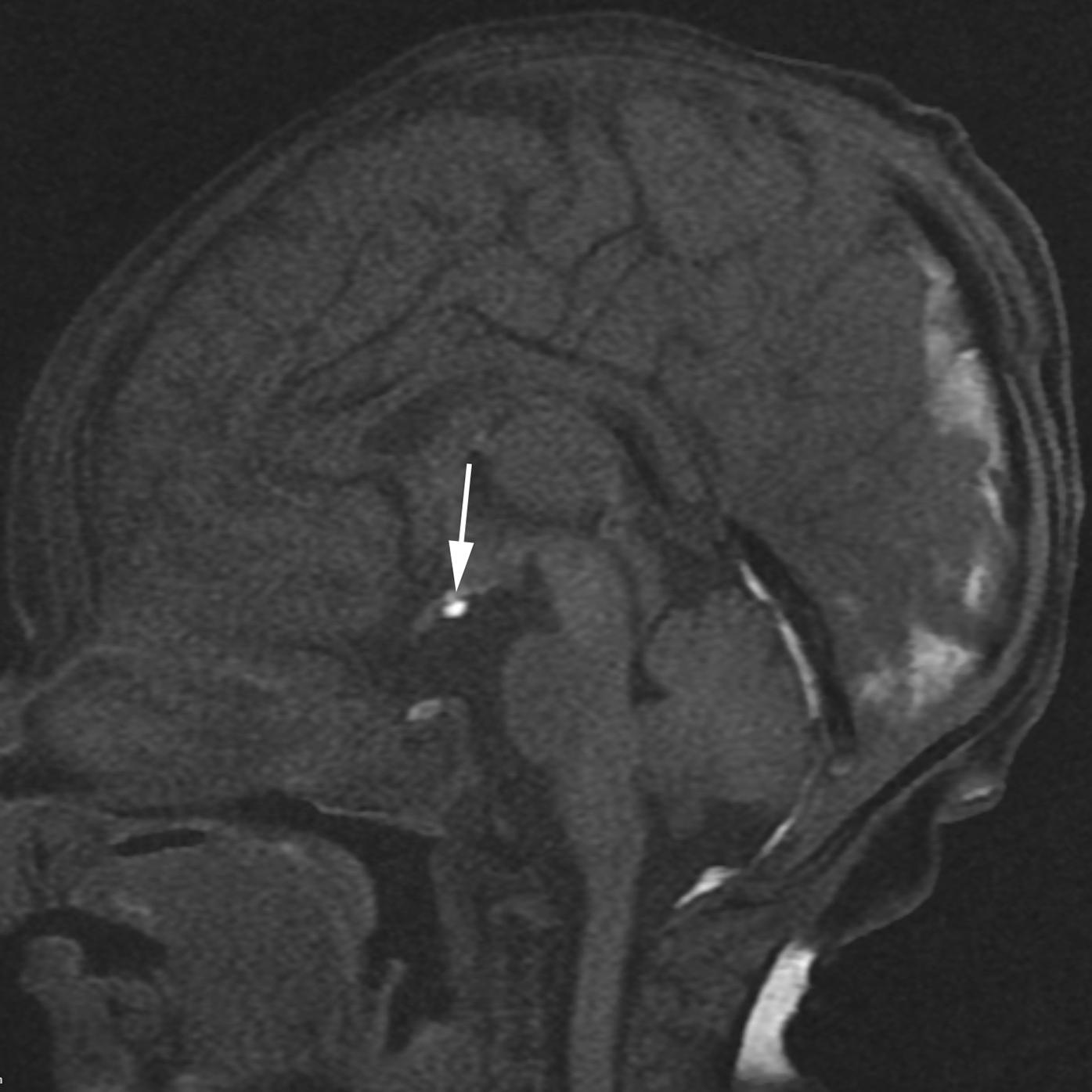
Dysgenesis of the corpus callosum includes complete absence (agenesis), partial absence, and changes in morphology and size. The corpus callosum is the largest brain commissure (white matter tract connecting the left and right cerebral hemispheres). It normally develops from two independent portions, anterior and posterior, and the anterior corpus callosum enlarges and becomes visible earlier. When a portion of the corpus callosum is absent or dysgenic, it is most commonly the posterior portion that is absent, although this is not always true ( Fig. 8-44A–D ). Absence of the corpus callosum can occur in isolation or in conjunction with many of the other developmental ( Fig. 8-45A–D ) and genetic abnormalities. On coronal MR images, the lateral ventricles are separated, and the third ventricle extends more superiorly than normal, positioned between the lateral ventricles. The white matter tracts, which normally would cross the midline via the corpus callosum, run along the medial surface of the lateral ventricles and form the bundles of Probst (see Fig. 8-44C ). Lateral ventricles assume a parallel configuration on axial views, and colpocephaly (see Fig. 8-44B ) is often present (dilatation of atrium and occipital horns of the lateral ventricles). Midline masses, such as lipomas and interhemipheric cysts (see Figs. 8-44B and 8-45A and B ), can also be associated.
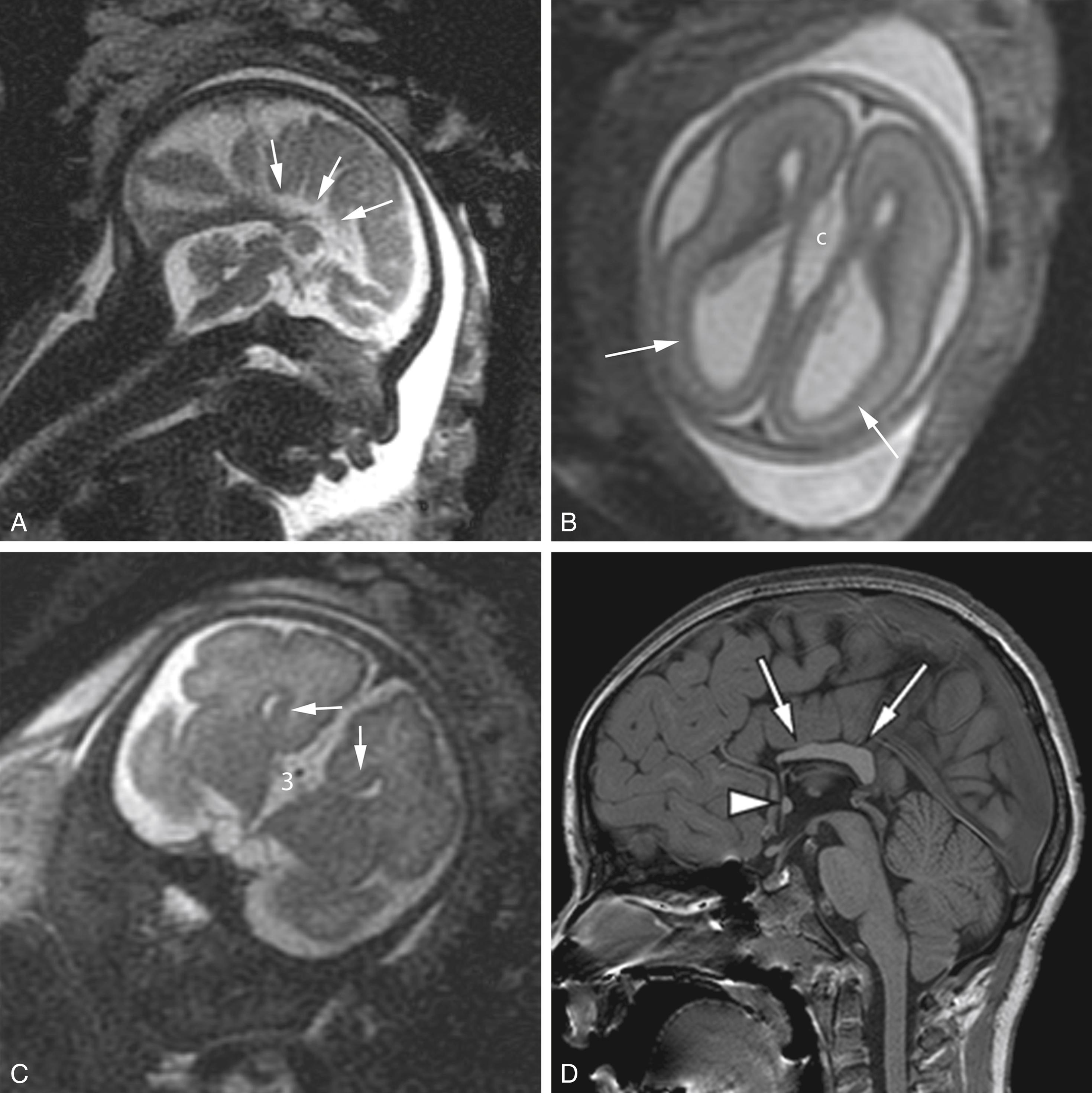
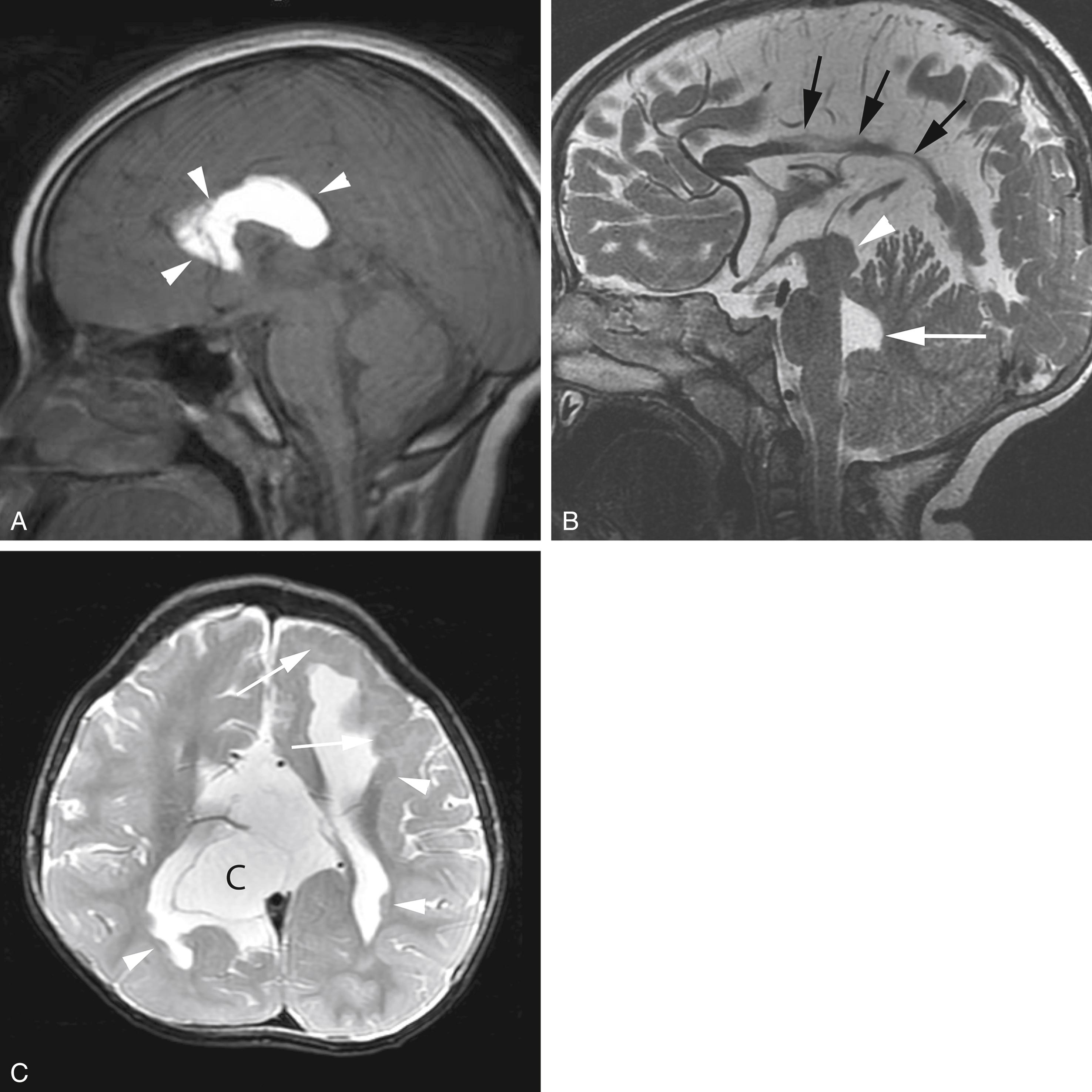
Causes of enlarged posterior fossa fluid spaces include a spectrum of etiologies that vary from normal developmental variants (mega cisterna magna) to more significant malformations. They can be divided into five major groups: Dandy–Walker malformation, cerebellar vermian hypoplasia, Blake pouch cyst, mega cisterna magna, and arachnoid cyst.
Dandy–Walker malformation is characterized by complete or partial agenesis of the cerebellar vermis in conjunction with the presence of a large posterior fossa. The CSF spaces are enlarged, and the torcula is elevated ( Fig. 8-46 ). The falx cerebelli is absent. Often there are also supratentorial abnormalities that may include holoprosencephaly, agenesis of the corpus callosum, polymicrogyria, and heterotopias. Hydrocephalus is also not uncommon. The patient outcome depends on severity of vermian hypoplasia and associated supratentorial abnormalities.
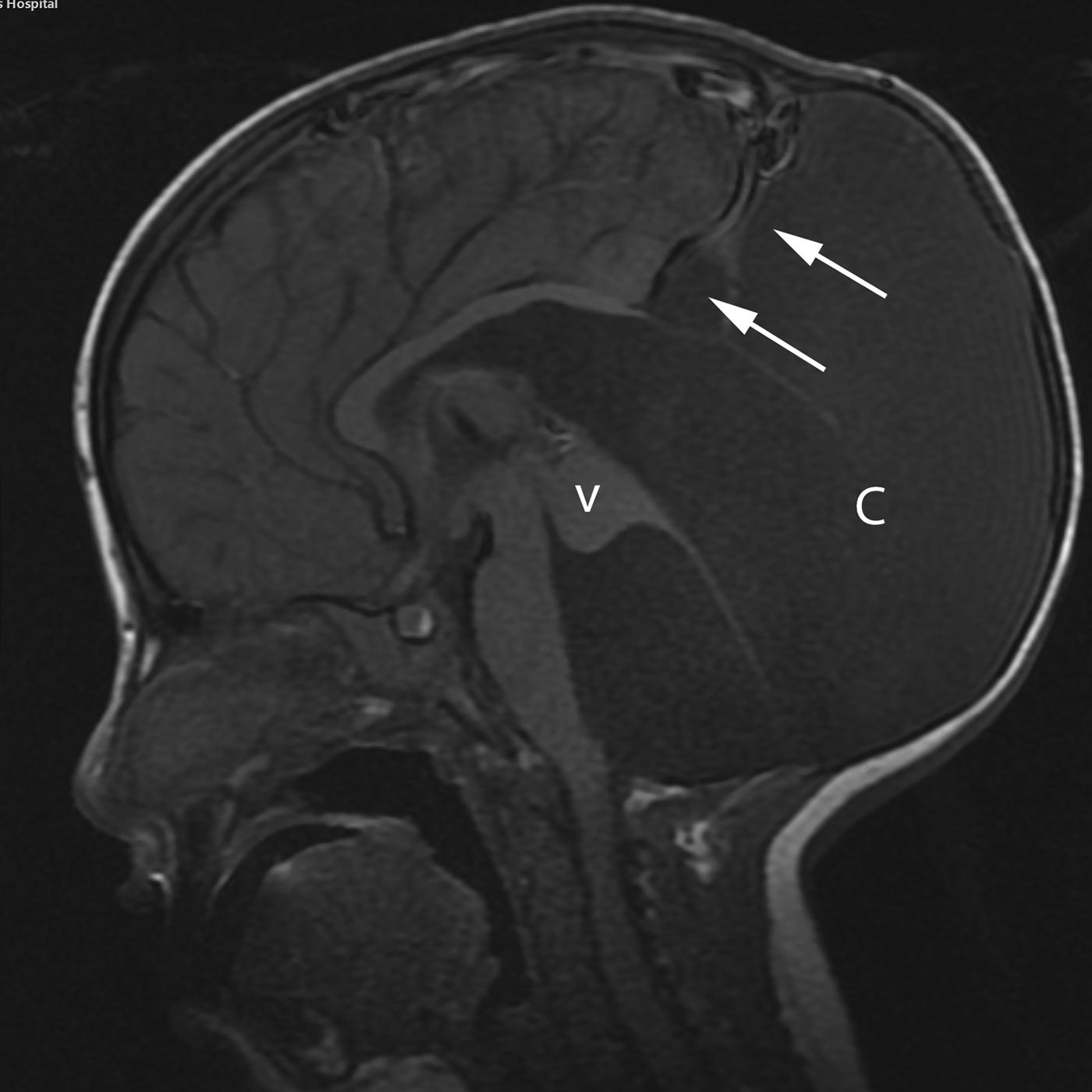
Cerebellar vermian hypoplasia (formerly known as Dandy–Walker variant or continuum) is characterized by mild, moderate, or severe hypoplasia of the cerebellar vermis. As a result, there is enlargement of the normal communication between the fourth ventricle and posterior fossa extra axial spaces. The overall size of the posterior fossa is not enlarged, and there is a normally positioned torcula Fig. 8-47 .
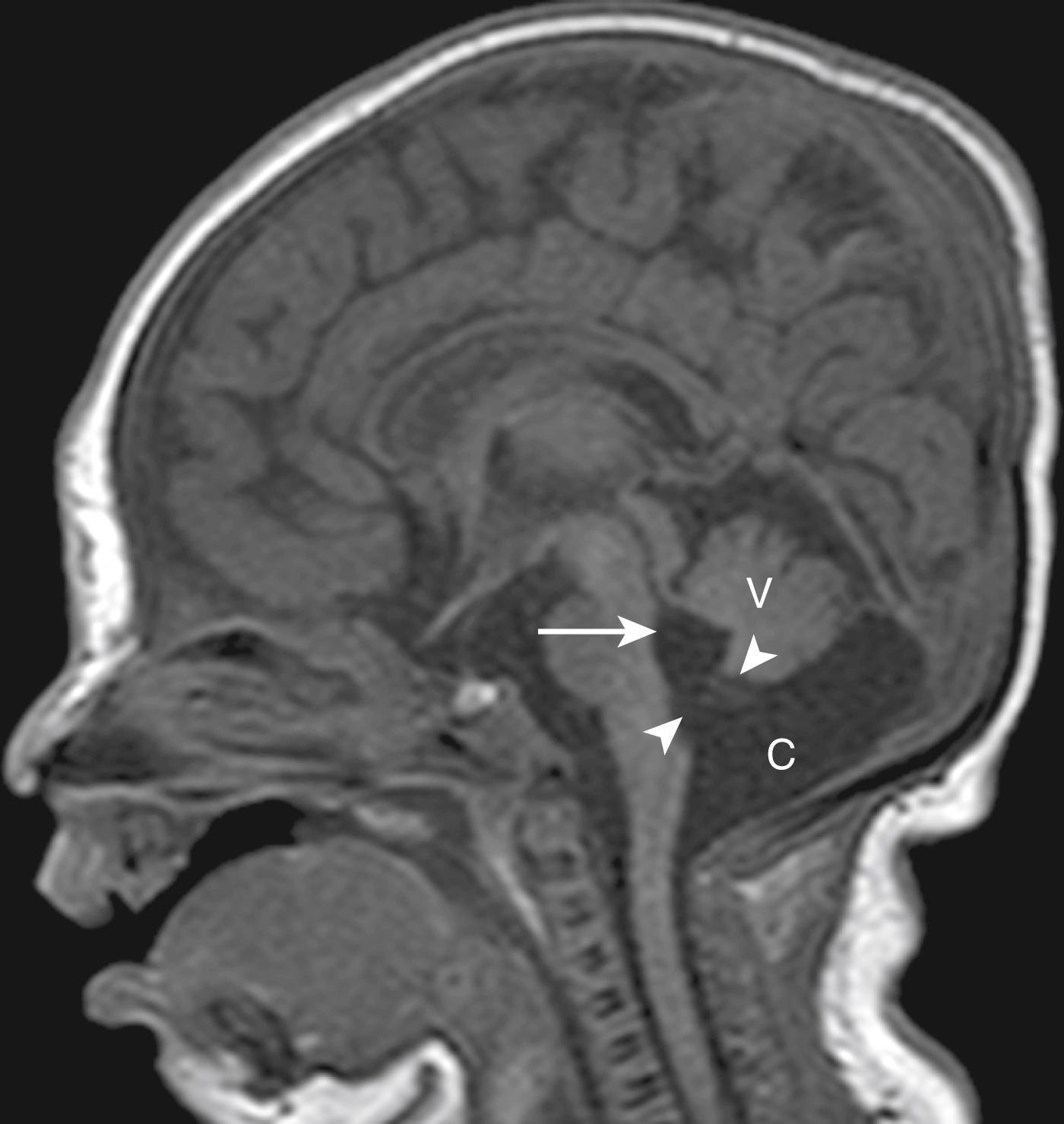
Blake pouch cyst is more commonly seen in the prenatal scenario, when fetal MRI is performed to evaluate for Dandy–Walker malformation versus vermian hypoplasia. Blake pouch is a normal embryological CSF-filled structure. It is seen during the development of the posterior fossa as a CSF outpouching that extends posteriorly from the inferior aspect of the developing fourth ventricle. When there is absent, incomplete, or late fenestration of this pouch (future foramens of Luschka and Magendie), a persistent cystic structure causing enlarged communications of the fourth ventricle and retrocerebellar extraaxial spaces is seen and referred to as Blake pouch cyst. The cerebellar vermis is usually uplifted but normally formed.
When enlarged posterior fossa CSF spaces are present with a fully developed and normally positioned cerebellar vermis, there are two possibilities. If the CSF spaces exhibit no mass effect on the cerebellum and the falx cerebelli is present, a mega cisterna magna is considered to be present. A mega cisterna magna may be in the spectrum of a persistent Blake's pouch cyst, as proposed by recent articles, and is considered a developmental variant. If the CSF spaces appear cystic and exhibit mass effect on the cerebellum, an arachnoid cyst is considered more likely ( Fig. 8-48 ). The differentiation between a mega cisterna magna and an arachnoid cyst may be difficult. However, regardless of the name chosen, if there is minimal or no mass effect on the cerebellum, the finding is considered incidental and of no clinical significance.
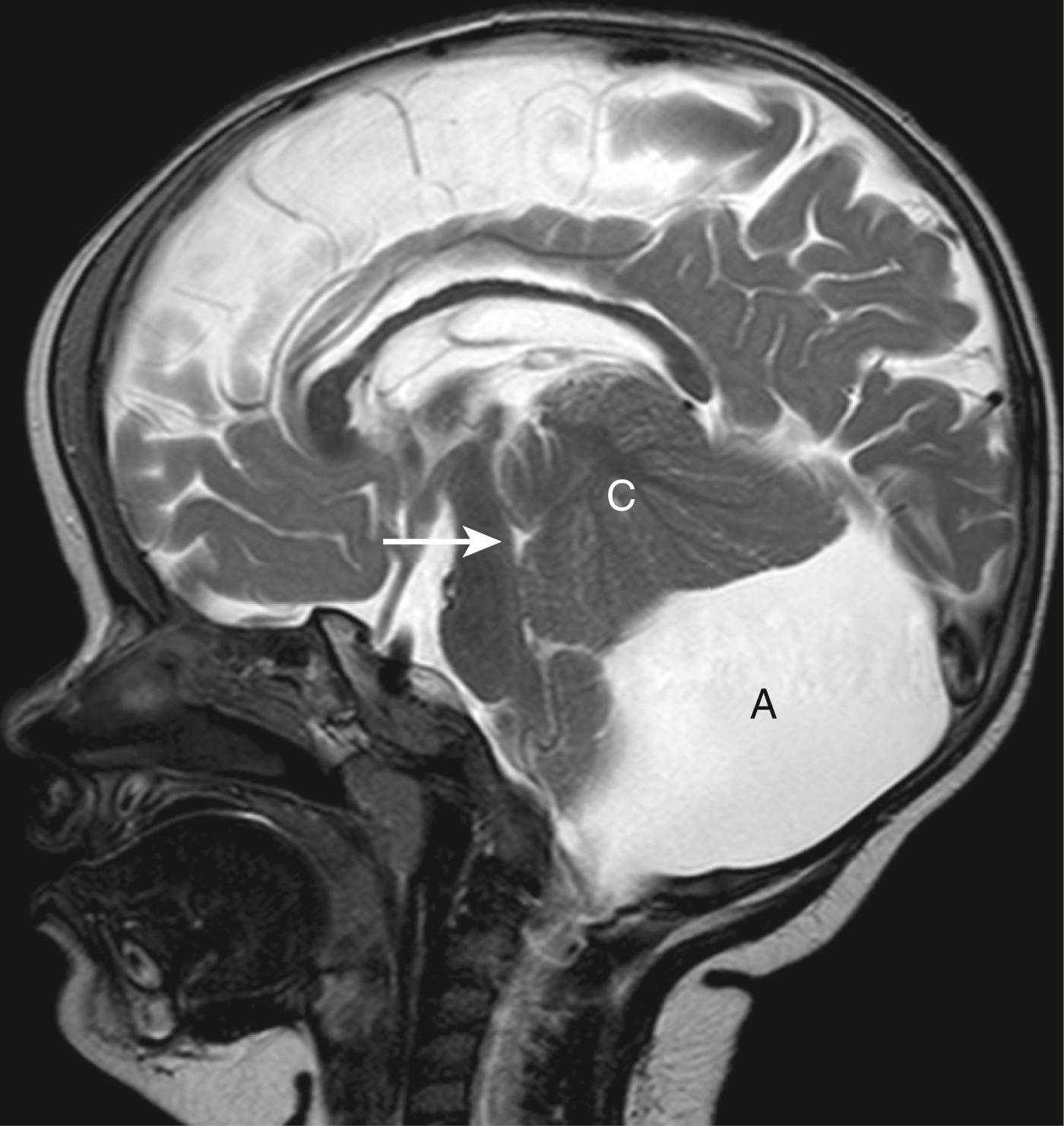
Molar tooth malformation is the main intracranial imaging finding in patients with Joubert syndrome and related disorders. Joubert syndrome and related disorders are a group of genetic disorders resulting in dysfunction of the neuronal progenitor cells cilia (ciliopathy). Imaging findings include elongated horizontally oriented superior cerebellar peduncles and deep interpeduncular fossa resembling a molar tooth on axial imaging ( Fig. 8-49A ). Additionally, a marked hypoplastic cerebellar vermis is characteristic ( Fig. 8-49B ). This may be confused with Dandy–Walker malformation on prenatal ultrasound.
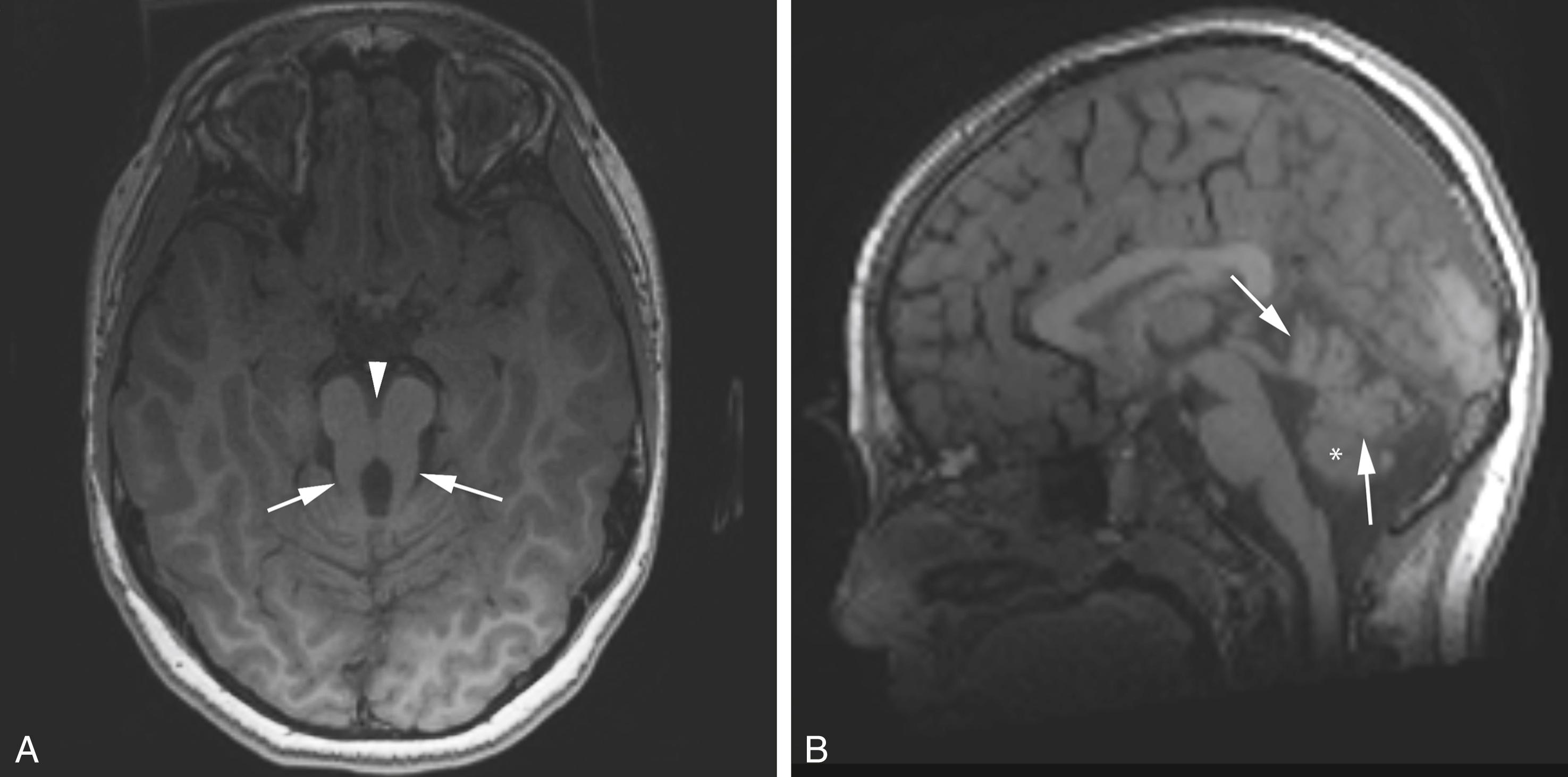
Rhombencephalosynapsis is a malformation of the rhombencephalon with complete or partial absence of the cerebellar vermis and midline fusion of the cerebellar hemispheres ( Fig. 8-50A and B ). Additional imaging findings include a small transverse cerebellar diameter (see Fig.8-121C ) and convex posterior cerebellar margins at the expected level of the vermis on axial plane as well as a rounded fastigial point and absent primary fissure on sagittal plane (see Fig. 8-45B ). This malformation is frequently associated with aqueduct stenosis diagnosed prenatally (see Fig. 8-121B-C ). Additional malformations/syndromes associated with rhombencephalosynapsis include VACTERL, holoprosencephaly, and Gomez–Lopez–Hernandez syndrome (rhombencephalosynapsis, focal alopecia, craniosynostosis, and trigeminal nerve abnormalities).
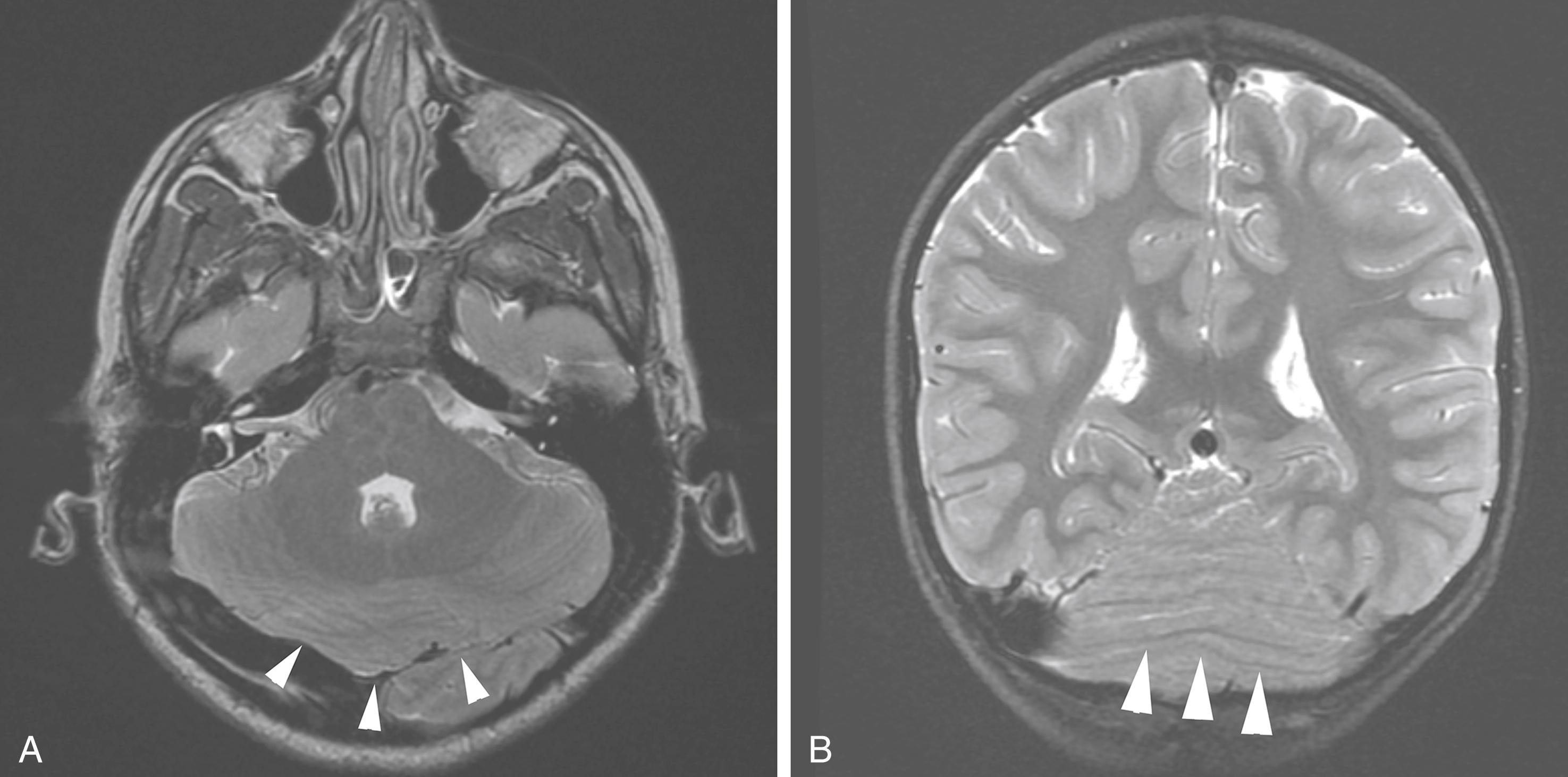
Microlissencephaly is the result of an arrest in cell proliferation resulting in both microcephaly and a simplified pattern of gyration ( Fig. 8-51 ).
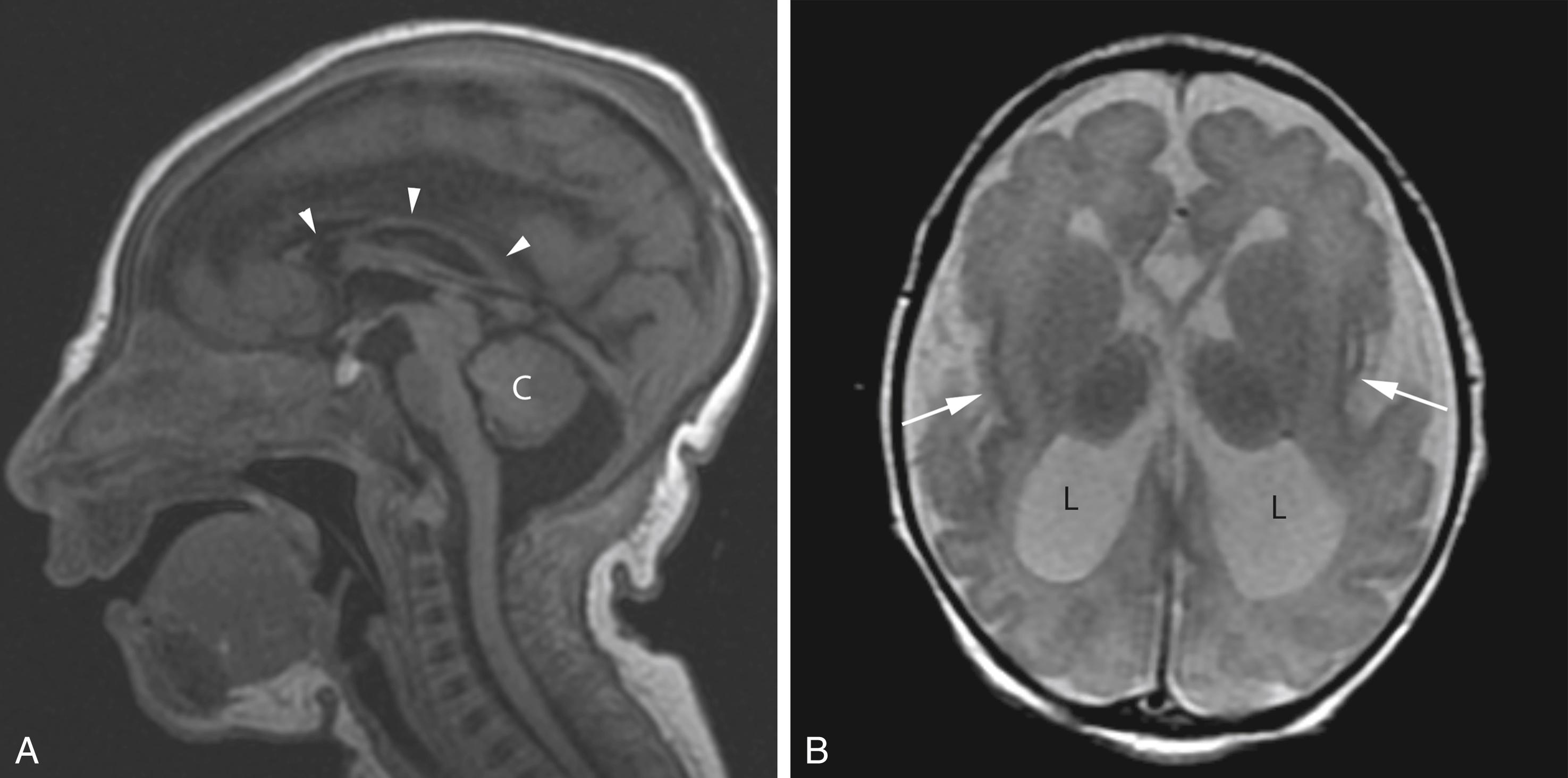
Lissencephaly is the result of migrational abnormality resulting in a smooth appearance of the brain secondary to absent sulcation and gyration (agyria) ( Fig. 8-52 ) or markedly decreased sulcation and gyration (oligogyria). Pachygyria is another overlapping term defined as abnormally broad and flat gyri with shallow sulci. Findings are best visualized with MRI, usually with patchy areas of both agyria and oligogyria/pachygyria. These abnormalities are commonly associated with other migrational abnormalities. They also occur as part of a number of genetic syndromes. Two malformations often associated with agyria and pachygyria are classic lissencephaly and cobblestone malformations. Classic lissencephaly is due to arrest of neuronal migration and is formally known as lissencephaly type I. MRI demonstrates a smooth brain with a thickened cortex and a band of hyperintense T2 signal within the cortex (sparse cell zone). The brain may demonstrate the classic “Figure eight” morphology (see Fig. 8.52 ). Cobblestone malformations are due to overmigration of neurons into the subarachnoid space via defects in the pial limitans membrane. These were formally known as cobblestone lissencephalies or lissencephalies type II. They are commonly associated with congenital muscular dystrophy. On imaging, there is markedly decreased sulcation with a pebbled appearance of the cortex ( Fig. 8-53A ). Other findings may include vermian hypoplasia, cerebellar dysplasia ( Fig. 8-53C ), brainstem hypoplasia, kinked pontomesencephalic junction, pontine cleft, ocular anomalies, and aqueduct stenosis leading to ventriculomegaly ( Fig. 8-53A and B ).
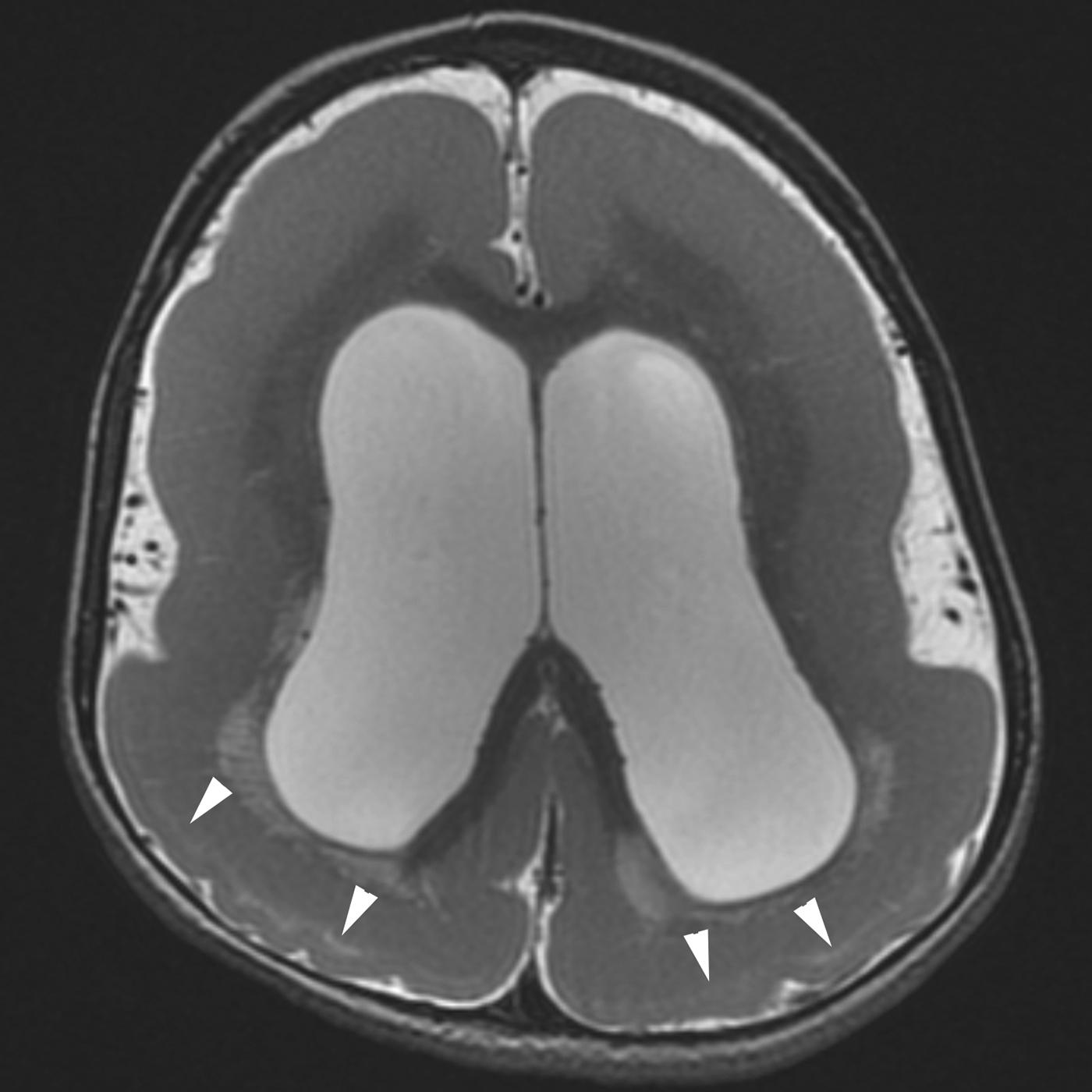
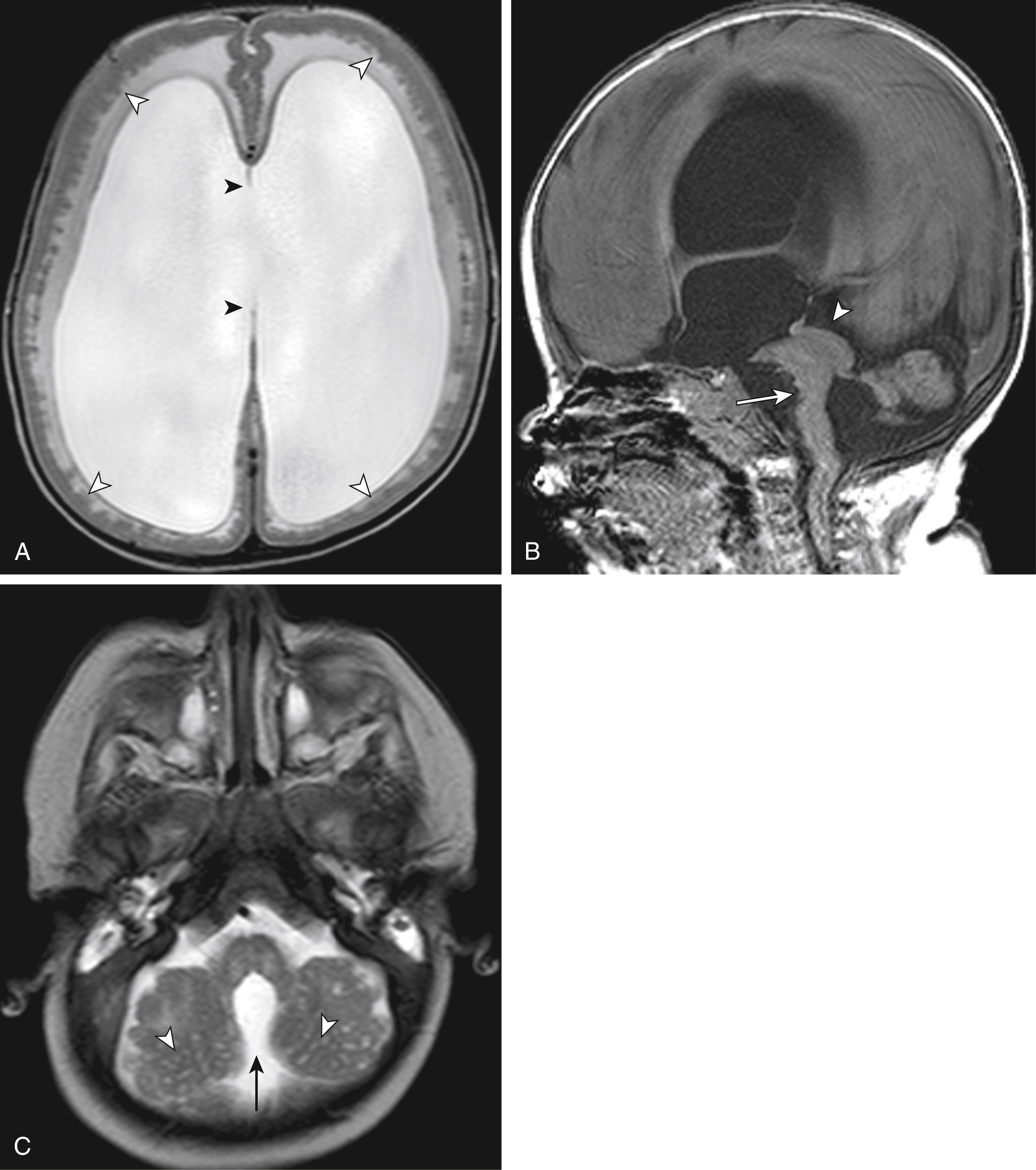
Become a Clinical Tree membership for Full access and enjoy Unlimited articles
If you are a member. Log in here